
Annual Report
of Yeti GermanCo 1 GmbH 2020
2
Annual Report of Yeti GermanCo 1 GmbH 2020
3
Annual Report of Yeti GermanCo 1 GmbH 2020
4
4 General Information on the Group
10 Economic Report
18 Forecast Report
20 Report on Opportunities
21 Risk Report
25 Risk Management
28
28 Consolidated Income Statement
29 Consolidated Statement of Comprehensive Income
30 Consolidated Statement of Financial Position
32 Consolidated Statement of Changes in Equity
33 Consolidated Statement of Cash Flows
34
56 Notes to the Consolidated Income Statement
66 Notes to the Consolidated Statement of Financial Position
116 Appendix
Content
Group Management Report
of Yeti GermanCo 1 GmbH 2020
Notes to the Consolidated Financial Statements
of Yeti GermanCo 1 GmbH 2020
Consolidated Financial Statements
of Yeti GermanCo 1 GmbH 2020
4
Annual Report of Yeti GermanCo 1 GmbH 2020
Overview of the Messer Industries Group
Yeti GermanCo 1 GmbH (the “company”) is a holding company based in Sulzbach (Taunus) near Frankfurt/
Main with a business address in Bad Soden am Taunus. It operates as a financial holding company and,
together with its subsidiaries, associates and joint ventures, forms the Messer Industries Group (the “Group”).
Yeti GermanCo 1 GmbH was founded as a joint venture company by Messer Group GmbH and CVC Capital
Partners, with the purpose of assuming the management of the businesses in the Americas (“Messer
Americas”) acquired from Linde and Praxair as of March 1, 2019 and the businesses in Western Europe
(“Messer Western Europe”) contributed by Messer. In this context, Messer Group GmbH has contributed
its Western European operating activities in Spain, Portugal, Switzerland, France, Belgium, the Netherlands,
Denmark, Germany and the company in Algeria, plus a right-of-use asset for the “Messer – Gases for Life”
brand, to the joint venture for a period of ten years as of March 1, 2019. Yeti GermanCo 1 GmbH has its
own subsidiaries in Western Europe, North and South America.
Founded in 1898, Messer is today the world’s largest family-operated specialist for industrial, medical and
specialty gases. Products and services are offered in Europe, Asia and the Americas under the “Messer –
Gases for Life” brand.
From acetylene to xenon, the Messer Industries Group offers a wide-ranging industrial and medical gas
product portfolio – the company produces industrial gases such as oxygen, nitrogen, argon, carbon dioxide,
hydrogen, helium, welding shielding gases, specialty gases, medical gases and many different gas mixtures.
General Information on the Group
Group Management Report
of Yeti GermanCo 1 GmbH 2020
5
Annual Report of Yeti GermanCo 1 GmbH 2020
Changes in group reporting in fiscal 2020
The consolidated group was unchanged in the past fiscal year.
Financial performance indicators
The Messer Industries Group uses control parameters derived from operating performance indicators to
manage its business. The most significant performance indicators are revenue, EBITDA, capital expendi-
ture and net debt. Further explanations and a breakdown of indicators can be found in the sections on
financial performance and financial position.
Non-financial performance indicators*
Safety, health, environmental protection and quality (SHEQ) have been firmly embedded in the family-
operated Messer’s guiding principles since its inception in 1898, and continue to be its top priority today
– especially in the context of the COVID-19 pandemic. Messer is aware that well-organized safety and
quality guidelines form the basis for handling operational risks safely and for improving operational perfor-
mance. For this reason, the health and safety of our employees and environmental protection are an integral
part of global quality management, which is reflected in various standards of the Messer Industries Group,
which were revised again against the backdrop of the COVID-19 pandemic to help effectively counter it.
The following information on non-financial performance indicators relates to the Group as a whole.
Occupational safety
Occupational safety is of great importance to the Messer Industries Group. Messer’s safety guidelines
reflect our position: “All work-related illnesses, injuries and accidents are avoidable.”
Messer uses its management system to identify and control possible operational risks. The principles of
this system are documented in a SHEQ manual and cover all relevant safety-related areas, such as risk
management, safety training, safety tests, Personnel protective equipment, communication safety and
accident investigation. The SHEQ manual is a part of compliance management at the Messer Industries
Group and is updated and improved regularly.
In order to measure the success of the safety measures and initiatives, the following performance indicators
are determined annually: work accidents with lost days and frequency of accidents (number of work-related
accidents with lost days per million working hours) and accident severity rate (missing days per million
working hours).
In 2020, 19 work accidents with lost days were reported in the Americas (previous year: 18) and 4 (previous
year: 10) in Western Europe.
* The content of this section is voluntary and unaudited, but has been read critically by the auditor.

6
Annual Report of Yeti GermanCo 1 GmbH 2020
The absenteeism rate of employees per million hours worked (accident frequency) was 1.7 (previous
year: 1.6) in the Americas in 2020 and 2.9 (previous year: 7.1) in Western Europe, while the number of
days lost (accident severity) was 27.8 (previous year: 21.6) per million hours in the Americas and 34.4
(previous year: 186.4) in Western Europe.
Messer Western Europe is an active member of the European Industrial Gas Association (EIGA) and the
International Oxygen Manufacturers Association („IOMA“) and Messer North America of the Compressed
Gas Association (CGA) and the American Chemistry Council (ACC). Our experts actively share experiences
and knowledge in order to learn from incidents in the industrial gas sector.
Transport safety
The transportation of gases and equipment by road and customer deliveries are activities that involve major
risks in the gas industry. Messer therefore pays special attention to the area of transport safety.
Most of the drivers who work for Messer in Europe are employed by external transport companies. These
companies are responsible for training the drivers in accordance with the ADR (European Agreement
concerning the International Carriage of Dangerous Goods by Road). In 2020, the number of avoidable
accidents when transporting our cylinder gases was 53 in the Americas (previous year: –) and four in
Western Europe (previous year: two). For every million kilometers driven, this corresponds to a frequency
rate of 6.1 in the Americas (previous year: –) and 0.65 in Western Europe (previous year: 0.29). The data for
the Americas were collected for the first time in 2020.
The number of avoidable accidents while transporting liquefied gases was 152 in the Americas (previous
year: 120) and nine in Western Europe (previous year: three); the frequency rate per million kilometers
driven in 2020 was 1.23 in the Americas (previous year: –) and 0.5 in Western Europe (previous year: 0.17).
Messer is endeavoring to reduce the number of accidents with the help of suitable supplier management,
information on defensive driving and load safety. Messer has also created its own modular driver training
package. The main issues covered by the training are:
• Statutory regulations (European and national regulations for the transport of dangerous goods by road)
• Technical aspects (hazards arising from product, vehicle and tank technology, vehicle checks, safety
technology)
• Accident avoidance
• Defensive, economic driving
In addition, all drivers receive a manual specifically for their work (bulk, bottle or service vehicles). This
ensures that the drivers have all the key information about their work to hand at all times.
2020 Americas / WEU 2019 Americas / WEU 2018 Americas / WEU
Working accidents with lost days 19 / 4 18 / 10 −
Accident rate* 1.7 / 2.9 1.6 / 7.1 −
Accident severity* 27.8 / 34.4 21.6 / 186.4 −
* per million hours worked
7
Annual Report of Yeti GermanCo 1 GmbH 2020
Digitization and IT security
Digitization is becoming increasingly important within the Messer Industries Group. The duties of the Group
Digital Officer (GDO) and the Group Security Officer (GSO) are performed by the Messer Industries Group
for Messer Western Europe. They implement Messer’s standards with a large number of projects and
advise the central functions and national subsidiaries in these areas.
At the Messer Group, the GSO is responsible for coordinating security measures, setting standards and
cultivating the corresponding expertise for all the individual companies. IT security supports the sustainability
of our digitization and the physical security of our information, in addition to helping to ensure that our key
business processes can be carried out by safeguarding the vitally necessary availability of our systems. IT
security services are devised by the IT Security team and its international members.
In the period under review, an agreement was signed to outsource most of the applications previously run
at the Messer Information Services data center in Gross-Umstadt, Germany. The goal of the cooperation is
the strategic and technical reorganization of the Messer Group’s IT infrastructure – in line with the current,
globally established standards – to make the IT infrastructure more powerful, more stable and more secure,
and thereby to create the central requirements for further efficiency enhancements and process impro-
vements. Uniformly high security standards will be implemented in conjunction with the project. Between
December 2020 and provisionally June 2021, all locations of the Messer Group and Messer Western Europe
will be connected to the IBM data center. The existing, and highly mixed, security infrastructure at the
locations will be standardized and placed under the uniform central management of a team of the outsour-
cing partner’s experts.
Outdated versions of MS Office will be replaced by Office 365. In the future, all client PCs will be provided
with central security updates and standardized, state-of-the-art software; also – as for the in-house smart-
phones – they will be administered centrally.
As part of the first wave in kicking off an IT security campaign, phishing e-mails were sent to management
and IT staff in Europe. The phishing campaign will be continued in 2021 and employees will be trained in the
risks of cybercrime using an awareness platform. We are thus reducing the potential risks and improving the
knowledge of our employees.
Messer Americas is constantly investigating the strategic possibilities of digitization and developing a
framework concept for information services to enable the companies to grow continuously. Essential
aspects that are examined as part of this concept are business applications, technical infrastructure, Internet
security and system management and organization. Within the company applications and the technical
infrastructure, applications such as SAP S / 4HANA or GOLD Suite are promoted, cloud-based services are
increasingly used and the efficiency in the areas of business processing, automation and data management
is examined. Internet security is an integral part of risk management, while protecting sensitive data is the
top priority. Our employees therefore receiving ongoing awareness training for these issues. Management
and organization are responsible for increasing efficiency within information services while at the same time
ensuring excellent service.
8
Annual Report of Yeti GermanCo 1 GmbH 2020
Data protection
Messer is committed to compliance with the applicable data protection regulations. Corresponding structures
are therefore created to guarantee a high level of data protection at Messer in the long term.
The Messer Group Privacy Officer (GPO), who is committed to continuing and optimizing data protection,
is responsible for the strategic coordination of the central data protection department at Messer and also
oversees the implementation of data protection by the national subsidiaries. The GPO also provides a number
of templates and processes to ensure a uniform standard of data protection.
A basic audit to establish the fundamental data protection level in the respective company was made
possible using a list of questions developed by the GPO. In Western Europe, data protection audits are
planned for three companies for the first time in 2021.
In order to further raise awareness of the threat posed by cybercrime, the GPO, together with the Group
Legal department, has developed an e-learning on cybercrime and made it available to the national companies
in Europe.
The data protection provisions are covered both in the Messer Group’s Code of Conduct and a supplement
to the Code for Messer Americas. In addition to this, Messer Americas has also created its own Data
Protection Policy that can be accessed on its Compliance website. The contacts for data protection issues
are the Senior Counsel and Regional Compliance Officer of Messer Americas and the Head of Human
Resources for North America. Staff throughout the Americas can also contact the members of the Legal and
Compliance team if they have any questions or concerns regarding data protection. Messer Americas also
consults with external legal experts on compliance matters in South America in particular. The “Ethics and
Code of Conduct” e-learning also contains a data protection module that must be completed for all emplo-
yees of Messer Americas.
Environmental management
Environmental protection, at all times and everywhere, is highly important to Messer. To live up to this,
Messer uses its global management system for environmental protection. The internal environmental
protection policies are documented in the Messer Industries Group’s SHEQ Manual. The environmental
management systems of the Western European and American subsidiaries are consistent with the internati-
onal ISO 14001 standard, and those of the Western European companies also adhere to the recommenda-
tions of the European Industrial Gases Association (e.g. EIGA IGC Doc. 107 – Guidelines on Environmental
Management Systems). In 2020, five of our subsidiaries in Western Europe had their environmental
management systems externally certified. Messer Americas follows the American Chemistry Council’s
Responsible Care Program, under which 35 locations in the US are certified. Two air separation units and a
CO
2
production site in Colombia are ISO 14001- and OHSAS 18001-certified, and four locations are ISO
14001-certified in Brazil.
The efficient use of energy is in Messer’s own interests. Pursuing the main goal of reducing costs and
conserving resources, energy management is an ongoing process that also helps to reduce our carbon
emissions. Our energy management system, for example, is certified according to ISO 50001 at all Messer
production sites in Germany and Spain.
9
Annual Report of Yeti GermanCo 1 GmbH 2020
At its production sites, Messer uses atmospheric air and electricity as the main raw materials for producing
air gases such as nitrogen, oxygen and argon. Production by air separation units accounts for more than
75 % of total energy consumption. Particular emphasis is therefore placed on the ongoing enhancement of
energy efficiency. Messer Group GmbH has thus engaged a Global Energy Manager (GEO) specifically to
improve the energy efficiency of air separation units. The GEO also performs this task for the Western
European companies of the Messer Industries Group.
The continuous monitoring of unit performance means that deviations in energy consumption can be
detected and potential for improvement identified. In cooperation with local managers, projects to improve
energy efficiency are being initiated on an ongoing basis.
Since joining the European Clean Energy Alliance in 2020, Messer can contribute its comprehensive
expertise in the field of industrial gases in the interests of the efficient and effective use of green hydrogen
with partners throughout Europe.
Customer satisfaction / quality
Taking the opinions and satisfaction of our customers into account is self-evident for us as a responsible
company, which is why we measure customer satisfaction in systematic surveys and integrate the results
into our management processes. The analysis of customer satisfaction is repeated every two years at every
European national company.
In Western Europe, customer satisfaction surveys were carried out in France, Switzerland and Spain (previous
year: France). In total, 9,760 customers were asked to complete the survey, which yielded 1,032 responses.
The results of the various surveys are summarized by region. On a scale from 1 for very dissatisfied to 10
for very satisfied, the overall performance of the Messer Industries Group in Western Europe has improved
year-on-year to between 8.9 and 9.4 (previous year: 8.0). The results are at a high level overall.
In the Americas, satisfaction surveys were performed for the first time in the US and Brazil in 2020. 29,009
questionnaires were sent out, 3,037 of which were analyzed. Customer satisfaction for the Americas region
was rated 5.6.
10
Annual Report of Yeti GermanCo 1 GmbH 2020
Economic Report
General economic conditions
The various industrial gases and the associated services and technologies are used in almost all industrial
sectors, not to mention food technology, medicine, research and science. Gross domestic product (GDP),
as it applies to all sectors and to the economy at large, is therefore a relevant indicator for the performan-
ce of the Messer Industries Group.
The World Health Organization (WHO) classified coronavirus (COVID-19) as a public health risk on Janua ry
30, 2020. The virus then quickly developed into a pandemic with serious repercussions worldwide. The
measures to contain the COVID-19 pandemic and to protect the health of society led to temporarily neces-
sary restrictions in everyday life and thus business life as well all over the world. As a result, according to
estimates by the International Monetary Fund (IMF)
1
and the World Bank
2
, global economic growth slum-
ped by around -4 % on average. According to the World Bank, for instance, real global GDP is believed to
have contracted by -4.3 % in 2020, after having expanded by 2.3 % in 2019. The massive economic crash
was evident in the industrialized nations and the emerging markets alike. Within the industrialized nations,
the downturn in the euro area has been even more pronounced than in the US. The economic slump has
meant a return to two different rates of GDP growth, estimated by the IMF at -2.4 % (2019: 3.6 %) for the
emerging markets and -4.9 % (2019: 1.6 %) for industrialized nations in 2020.
1
The relatively moderate
economic downturn on the emerging markets is largely thanks to China, which is also the only major eco-
nomy expected to have generated GDP growth in 2020.
The 2020 economic performance in Europe was defined by a massive slump in industrial production as of
the end of the first quarter, which would go on to bottom out during the second quarter. This was followed
by a process of recovery that, by as early as the end of the third quarter, brought consumer spending back
to the level of when the year began, though industrial production was not yet able to return to the level at
which it started the year. The recovery process then suffered a tangible setback with the start of the fourth
quarter and the second wave of the COVID-19 pandemic. According to the Organization for Cooperation and
Development (OECD)
3
, GDP for the euro area is believed to have crashed by -7.5 % in 2020 after a minor
increase of 1.3 % the year before. As a result, above all the larger Western European economic areas such
as France, Italy and Spain suffered the severest economic slumps of between -9 % and -12 % of GDP, while
Germany’s GDP downturn is expected to match the OECD’s average of -5.5 %. In Eastern Europe, GDP
frequently slumped to below the euro area average (-7.5 %), though in some countries GDP fell by less than
the OECD average (-5.5 %), for instance Poland at -3.5 % or Bulgaria at -4.1 % of GDP.
In China, where the COVID-19 pandemic first began, the economic downturn commenced just as the year
began and reached its lowest point at the end of the first quarter. By as soon as the second quarter, the
strict measures taken by the Chinese government to contain the pandemic started to have an effect and –
according to official sources – the virus was largely under control by the middle of the year. As a result,
China is expected to report GDP growth for 2020 as a whole, possibly of 2.0 % according to World Bank
estimates (2019: 6.1 %). The Chinese government’s general goal of reducing its dependence on exports by
strengthening domestic demand with a corresponding focus on consumer spending and services was
1
World Economic Outlook, Update January 2021
2
Global Economic Prospects, January 2021
3
OECD Economic Outlook – Volume 2020 Issue 2
11
Annual Report of Yeti GermanCo 1 GmbH 2020
advanced further, particularly in view of the escalating trade conflict with the US. In this context, the
government stepped up its support for infrastructure projects especially.
In the US, the impact on economic development of the COVID-19 pandemic occurred in parallel to that in
Europe, thus a massive economic slump in the first half of 2020 was followed in the third quarter by a
recovery spurred by fiscal stimulus for private households. According to the IMF
4
, GDP for 2020 as a whole
is expected to have collapsed by -3.4 %, following growth of 2.2 % in 2019. Production in particular was
negatively impacted by the trade conflict with China and, in part, Europe as well, which escalated in 2020.
The IMF is projecting a more impactful drop in GDP of -4.5 % in Brazil, though the country had achieved
slight growth of 1.4 % in 2019.
Business performance
Industrial gases business is defined by a pronounced and highly varied diversification across economic
sectors, customer segments and national activities. Furthermore, industrial gases business is locally
structured, which means that it is not directly dependent on global supply chains. The restrictions to curb the
COVID-19 pandemic, some of which were massive at times, increasingly focused on the leisure and travel
sectors as 2020 progressed, and less on the industrial activities that are more significant to industrial gas
operations. To a certain extent, there was also an isolated boom in the medical, foodstuffs and electronics
segments.
For the Messer Industries Group, fiscal 2020 was defined by an economic crash in Europe as a result of the
COVID-19 pandemic, which hit Western Europe harder than most Eastern European countries. The early
temporary business closures in North America led to a decline in demand for industrial gases coupled with
a rising need for medical oxygen. A tangible recovery was apparent on many markets during the summer
months, with some even returning to their original prepandemic levels before the end of the year. South
American business activities remained strong throughout the whole of the year, in particular because the
need for healthcare services and medical oxygen outstripped the downturn in demand for industrial gases.
The Brazilian economy proved robust on most markets in spite of the COVID-19 pandemic.
The Messer Industries Group was founded in fiscal 2018, and began operating effective March 1, 2019
following the acquisition and contribution of business in the Americas and Western Europe. Without
adjusting for this limited comparability, the Messer Industries Group generated significant revenue growth
of more than 16.5 % to K€ 1,965,492. In line with this revenue development, EBITDA was 45.1 % higher
than in 2019 at K€ 541,040. However, the change as against the previous year is largely due to the different
comparative period for operating activities.
The net debt of the Messer Industries Group was down on the previous year at K€ 1,946,309 (previous
year: K€ 1,948,833) thanks to the higher consolidated net profit and despite higher tax payments in the US.
The Messer Industries Group brought the fiscal year to a satisfactory conclusion with revenue of K€ 1,965,492
and EBITDA of K€ 541,040.
4
World Economic Outlook, Update January 2021

12
Annual Report of Yeti GermanCo 1 GmbH 2020
A slight increase in the Group’s revenue was forecast in the previous year. As stated above, revenue rose by
16.5 %, though it should be noted that the Messer Industries Group did not commence operating activities
until effective March 1, 2019. If one assumes that the Group had been operational for twelve months in
2019, revenue would have been down slightly in 2020 on account of the weak US dollar and Brazilian real.
Adjusting for this effect, revenue increased slightly and thus the forecast was achieved.
A slight increase in EBITDA was also forecast in the previous year. If one assumes that the Group had been
operational for twelve months in 2019 here as well, EBITDA would have risen by about 21 %. This positive
development largely results from favorable purchasing conditions for helium, successful cost management
in conjunction with the pandemic and a dynamic overall business performance, especially in the field of
medical gases.
While a slight increase had been forecast, the net debt of the Messer Industries Group was reduced slightly
in 2020 thanks to the high earnings in the fiscal year and in spite of high tax payments.
Translated into euro, the Messer Industries Group’s capital expenditure was slightly less than in the previous
year. However, adjusted for currency effects, capital expenditure increased in line with planning.
Overall situation of the Messer Industries Group
Results of operations
In fiscal 2020, the Group generated global revenue of K€ 1,965,492 (previous year: K€ 1,687,608), which
breaks down among the individual regions as follows:
Business activities in the various regions developed as follows:
North America
North America generated revenue of € 1,353 million. This positive development was buoyed by strong
pricing and a higher demand volume in specialty and medical gases. The slump in demand in the segments
affected by COVID-19 was therefore more than offset.
Western Europe
The revenue of the Western European companies was up by € 58 million as against the previous year at
€ 354 million. In addition to temporary business closures in all Western European countries on account of
the COVID-19 pandemic, this figure was influenced by a serious accident at a main pipeline customer in
Tarragona, Spain. These factors led to a decline in revenue, above all in the fields of liquefied gases and
on-site plants. An offsetting effect that compensated almost entirely for this decline resulted from success-
ful pricing in fiscal 2020. Revenue increases in medical gases, specialty gases, hardware and cylinder rental
made up for the weaker revenue from pipeline and liquefied gases business.
Revenue
Jan. 1 -
Dec. 31, 2020
Jan. 1 -
Dec. 31, 2019
Change in 2020
North America 1,353,366 1,142,224 18.5 %
Western Europe 353,677 296,249 19.4 %
South America 258,449 249,135 3.7 %
Total 1,965,492 1,687,608 16.5 %

13
Annual Report of Yeti GermanCo 1 GmbH 2020
South America
The South America division generated revenue of € 258 million (previous year: € 249 million), a significant
share of which was again contributed by Brazil at € 150 million (previous year: € 153 million). Revenue
was characterized by very strong demand for medical oxygen, combined with ongoing sales volume and
price increases in most business segments. The notional revenue increase of 4 % in South America is
offset by the substantial depreciation of the Brazilian real against the euro.
The Group generated global EBITDA of K€ 541,040 in fiscal 2020 (previous year: K€ 372,819).
As a negative effect, the operating profit essentially includes the costs of sales of K€ 1,001,068 (previous
year: K€ 871,564), selling and distribution expenses of K€ 588,614 (previous year: K€ 542,604) and general
and administrative expenses of K€ 181,113 (previous year: K€ 169,558).
The EBITDA of the North America region improved to € 371 million (EBITDA margin: 27.4 %) after € 250
million in the previous year with an EBITDA margin of 21.9 %. This development is essentially thanks to
demand for products in segments with higher margins, flexibility in supply chains to reduce variable costs in
line with the decline in demand and strict cost management. The previous year’s EBITDA was squeezed by
transaction and demerger costs in connection with the acquisition of activities from Linde and Praxair.
Western Europe generated EBITDA of € 95 million (previous year: € 61 million), corresponding to an EBITDA
margin of 26.9 % (previous year: 20.6 %). There were positive effects as a result of successful pricing and
cost savings in the areas of HR, travel expenses and external consulting services. Offsetting effects arose
from a provision for legal matters in connection with energy deliveries in Spain in the amount of € 5.4 million.
South America reported EBITDA of € 75 million (previous year: € 62 million) with an EBITDA margin of 29 %
(previous year: 24.9 %) in fiscal 2020, which – as in the previous year – was largely thanks to a rise in sales
volumes and a solid price recovery despite cost pressure. Offsetting this, EBITDA in euro was hit hard by the
substantial depreciation of the Brazilian real.
At K€ 85,816 (previous year: K€ 83,796), the net financial result is largely due to a negative net interest result.
€ 19 million of the financial liabilities raised in the previous year, essentially to finance the Linde / Praxair
transaction, were repaid during the year.
In total, a consolidated net profit including non-controlling interests of K€ 52,461 (previous year: K€ 3,209)
was generated in fiscal 2020. K€ 51,737 (previous year: K€ 2,695) of this relates to the shareholders of the
parent company.
EBITDA
Jan. 1 - Dec. 31, 2020 Jan. 1 - Dec. 31, 2019
Operating profit / EBIT 194,982 80,215
Depreciation of property, plant and equipment, amortization
of intangible assets and impairment
346,058 292,604
EBITDA 541,040 372,819
Revenue 1.965,492 1,687,608
Margin: 27.5 % 22.1 %

14
Annual Report of Yeti GermanCo 1 GmbH 2020
Financial position
Group Treasury is responsible for overall liquidity, interest rate and currency management. The most import-
ant objective for Group Treasury is to ensure that the Group has a minimum level of liquidity to guarantee
solvency at all times. High levels of cash funds improve our flexibility, security and independence. We can
generate additional liquidity as necessary through various other unutilized credit facilities amounting to
€ 290 million (previous year: € 279 million).
Financing
The Messer Industries Group is financed by a credit agreement with a syndicate of banks headed by
CITIBANK N.A., UK.
The loan agreement serves to partially finance the purchase price payment for the Linde AG and Praxair
business acquired in North and South America in 2019 and to finance ongoing business operations.
The credit agreement contains three facilities:
• “Facility B-1” of USD 2,225 million, a long-term, fully utilized loan with a term of seven years. The borrower
is Messer Industries USA, Inc., Delaware. The loan will be repaid quarterly at 0.25% of the original amount,
starting on June 28, 2019. The balance will be repaid in full on March 1, 2026. The margin is 2.5 % p.a. or
1.5 % p.a. depending on the underlying refinancing base of the banks.
• “Facility B-2” of € 540 million, a long-term, fully utilized loan with a term of seven years. The borrower is
Messer Industries GmbH. The loan is due on March 1, 2026. The margin was initially 2.75 % p.a., until
August 28, 2019, since when it has been subject to an adjustment mechanism based on the development
of the ratio of senior net debt to consolidated EBITDA.
• “Revolving facility” of USD 450 million: The borrowers are Messer Industries GmbH and Messer Industries
USA, Inc., Delaware, and any other company that secures the loan agreement as a guarantor. The facility
can be used to finance working capital and for all general financing requirements of the company on a
revolving basis. There is no need to reduce the loan to zero at any time during its term. It is available until
March 1, 2024. The margin was 1.75% p.a. or 0.75 % p.a., depending on the underlying refinancing base
of the banks, until August 28, 2019, since when it has been subject to an adjustment mechanism based
on the development of the ratio of senior net debt to consolidated EBITDA. The facility of € 290 million
was unutilized as of December 31, 2020.
Guarantees provided by individual Group companies serve as collateral for the financing. Investments in
Group companies, property, plant and equipment, bank balances, trade receivables and receivables from
affiliated companies were also pledged.
Net debt amounts to K€ 1,946,309 (previous year: K€ 1,948,833) as of December 31, 2020 and is calculated
as follows:
Dec. 31, 2020 Dec. 31, 2019 Change in 2020
Financial liabilities 2,357,116 2,526,255 -6.7 %
Cash and cash equivalents (410,807) (577,422) -28.9 %
Net debt 1,946,309 1,948,833 -0.1 %
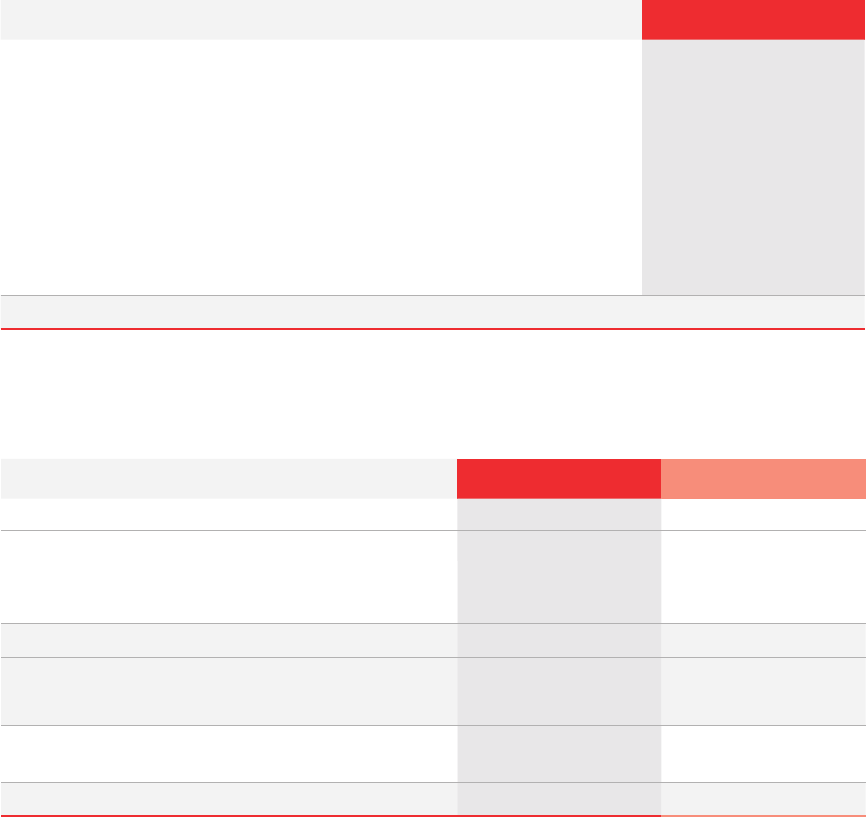
15
Annual Report of Yeti GermanCo 1 GmbH 2020
The ratio of existing financial liabilities (K€ 2,357,116) to total assets (K€ 4,656,611) was 50.6 % in 2020
(previous year: 47.4 %).
The change in gross financial liabilities is shown below:
Statement of cash flows
The statement of cash flows is as follows:
The cash flow from operating activities was K€ 222,581 and therefore K€ 191,729 lower than the previous
year’s level. In addition to significantly higher income tax payments of K€ 283,160 (previous year: K€ 88,311),
this development is mainly due to changes in operating assets. The high income tax payments were incurred
in the US and result from the acquisition of Linde AG’s business there as of March 1, 2019.
The development in cash flow from investing activities was largely defined by investments in property,
plant and equipment and intangible assets of K€ 240,746 (previous year: K€ 249,420). The cash flow from
investing activities in the previous year reflected the acquisition of the business activities of Linde and Praxair
at K€ 2,501,285.
Gross financial liabilities as of Jan. 1, 2020 2,526,255
Cash changes:
New debt raised
Capitalized financing costs
Payments of principal
3,367
−
(40,401)
Non-cash changes:
Additions to lease liabilities
Changes due to currency translation
Change in Group reporting
Capitalized financing costs
24,447
(167,646)
−
11,094
Gross financial liabilities as of Dec. 31, 2020 2,357,116
Condensed version in K€
Jan. 1 - Dec. 31, 2020 Jan. 1 - Dec. 31, 2019
Profit before tax 69,400 (3,761)
Cash flow from operating activities 222,581 414,310
Cash flow from investing activities (217,990) (2,723,654)
Cash flow from financing activities (133,795) 2,888,751
Changes in cash and cash equivalents (129,204) 579,407
Cash and cash equivalents
at the beginning of the period 577,422 124
Currency translation effect on cash and cash equivalents (37,411) (2,109)
at the end of the period 410,807 577,422

16
Annual Report of Yeti GermanCo 1 GmbH 2020
The cash flow used in financing activities amounted to K€ 133,795, after cash generated by financing
activities of K€ 2,888,751 in the previous year. After financial liabilities were incurred to finance new
business activities in the previous year, these liabilities were paid off in installments in the past fiscal year.
There were cash outflows of K€ 91,185 (previous year: K€ 95,125) for interest essentially relating to
financing.
The cash funds of the Messer Industries Group amount to K€ 410,807 as of December 31, 2020.
Operating business will grow, investments will be made and the maturing loans and interest will be repaid
in fiscal 2021 as well. Medium-term planning is still focused on the consolidation of net debt for our
business activities in the US. The funds required will be generated from cash flow from operating activities,
available cash and unutilized credit facilities.
The Group has undertaken to invest in the acquisition, construction and maintenance of various production
facilities. Obligations of this kind relate to the future purchase of plant and equipment at market prices.
There are also long-term contracts giving rise to obligations. As of December 31, 2020, the commitments
under orders, investment projects and long-term contracts amounted to K€ 612,942 (previous year:
K€ 325,469).
Capital expenditure
Capital expenditure continues to focus on safeguarding existing business and exploiting profitable growth
potential. In line with business principles, we therefore primarily invest in projects that safeguard our
product supply or that offer opportunities for profitable growth. Furthermore, there is regular investment
in the modernization of production systems and distribution channels.
The capital expenditure of the Messer Industries Group as a whole is explained below.
The Messer Industries Group invested around € 247 million in intangible assets and property, plant and
equipment in 2020. Expressed as a percentage of total revenue, capital expenditure amounts to 12.6 %
(previous year: 14.8 %).
Capital expenditure breaks down by region as follows:
In North America, investment again focused on safeguarding existing business and projects dealing with
on-site plants and air separation units in the field of liquefied gases with opportunities for profitable growth.
Given the impact of the COVID-19 pandemic on the world economy, customers in North America postponed
projects and there were delays in the construction of new plants. Furthermore, North America postponed
several investment projects until the fourth quarter of the past fiscal year and the start of 2021.
Investments in intangible assets and property, plant and equipment essentially related to new air separation
units in Indianapolis, Indiana, USA, Claymont, Delaware, USA, and Arroyo, West Virginia, USA, the construction
Capital expenditure in K€
Jan. 1 - Dec. 31, 2020 Jan. 1 - Dec. 31, 2019
North America 179,460 179,190
Western Europe 51,704 52,501
South America 15,479 17,729
Total 246,643 249,420

17
Annual Report of Yeti GermanCo 1 GmbH 2020
of a carbon dioxide plant in Keyes, California, USA, and the modernization and repair of an LCO
2
plant in
Bayport, Texas, USA. Furthermore, there was investment in sales equipment and maintenance, in addition to
capital expenditure to boost productivity.
Large-scale plant projects account for € 23.1 million of capital expenditure in Western Europe (€ 51.7 million),
and operating activities for € 28.6 million. The biggest projects were the air separation unit in Speyer (€ 12.4
million) that went live at the end of 2020 and the new air separation unit Messer V in Spain, which is due to
go live at the end of 2021. Investments in operating activities mainly relate to the maintenance of machinery,
support for core business and investments in cylinders.
In South America, as in the previous year, capital expenditure amounted to € 15 million and related to
operating activities and the maintenance of existing systems.
Net assets
Total assets declined by K€ 678,115 in the reporting year to K€ 4,656,611 as of December 31, 2020. The
main factors contributing to this were the decline in non-current assets of K€ 457,051 and in cash and cash
equivalents of K€ 166,615.
At 79.9 %, non-current assets again account for the largest share of total assets (previous year: 78.3 %).
As before, the largest item on the assets side is capital assets (property, plant and equipment, right-of-use
assets and intangible assets) at 78.8 %, down by 11.1 % as against the previous year (77.3 %). This change
mainly results from depreciation and amortization and from investing activities in the current fiscal year.
The equity ratio (including non-controlling interests) increased slightly to 25.9 % (previous year: 24.6 %).
Net financial liabilities amount to K€ 2,357,116 in the fiscal year (previous year: K€ 2,526,255) and account for
50.6 % (previous year: 47.4 %) of total equity and liabilities. Please refer to our comments under “Financial
position”.
Operating assets
Net working capital breaks down as follows:
The increase in operating assets of K€ 21,791 is essentially due to the trade payables of our companies
in the US and Brazil.
Operating assets
Dec. 31, 2020 Dec. 31, 2019
Inventories 156,361 184,521
Trade receivables 256,792 276,407
Trade payables (148,045) (215,231)
Prepayments received (16,203) (18,583)
248,905 227,114
18
Annual Report of Yeti GermanCo 1 GmbH 2020
The ratio of inventories (less prepayments received) and trade receivables to trade payables is around
3:1 (previous year: 2:1). The ratio of operating assets to revenue is 12.7 % (previous year: 13.5 %).
Days sales outstanding (DSO) improved to 47 (previous year: 59).
Overall statement on the economic situation
The satisfactory overall business development is in line with expectations that were formed when acquiring
the new business activities. The Messer Industries Group has a global presence with its three main regions
of Western Europe, North America and South America, and it has good regional diversification in a large
number of countries within these three core regions. Weak demand on individual markets or downturns in
specific industries can therefore often be compensated.
Forecast Report
General economic development
The global progress in COVID-19 vaccine development in recent months has given the leading economic
research institution grounds for optimism in their assessment of the global GDP growth trend for 2021. On
top of this, there is the stimulus of fiscal policy measures and economic relief programs recently resolved
and set up by leading economic nations such as the US, Japan and the EU. For 2021 and 2022 as well,
tangible catch-up effects are expected in the global growth trend for GDP, which should exceed the average
level of recent years. For example, the World Bank
1
or the International Monetary Fund (IMF)
2
are forecas-
ting global GDP growth for 2021 of 4.0 % to 5.5 % following a projected -4.3 % to -3.5 % in 2020. The return
of global economic momentum is expected to be driven by significantly stronger GDP growth in the
industrialized nations and the emerging markets alike, though the GDP growth rates of the industrialized
nations obviously will not match those of the emerging markets. For 2021, the IMF, for example, is forecas-
ting total GDP growth of 4.3 % for the developed nations after an expected -4.9 % in 2020, but GDP growth
of 6.3 % for the emerging markets after -2.4 % in 2020.
China is expected to take advantage of its early recovery in 2020 to further advance its claim to global
economic significance. For 2021, the World Bank and the IMF are forecasting a rise in GDP growth momen-
tum to up to 8.3 %, as compared to a previously waning economic trend of around 6 % in 2019. The risk that
the trade conflict with the US will escalate is seen as less relevant following the change of government. In
the US, ongoing GDP growth is expected to benefit from fiscal policy measures, the decline in political
uncertainty and comprehensive COVID-19 vaccination measures. Thus, the economic research institutes
1,2
are forecasting a significantly higher GDP growth rate of up to 5.1 % in 2021 after a decline in GDP of more
than 3 % in 2020. According to World Bank forecasts, consistently good financing conditions and the progress
in COVID-19 vaccinations should lead to a moderate resurgence of economic growth in Brazil with a GDP
growth rate of 3.0 % in 2021.
The World Bank and the IMF have highlighted the significant forecast risks in their statements for 2021, this
time primarily on account of the uncertainty regarding the outcome of efforts to combat the COVID-19
pandemic.
1
Global Economic Prospects, January 2021
2
World Economic Outlook, Update January 2021

19
Annual Report of Yeti GermanCo 1 GmbH 2020
Outlook for the Messer Industries Group
The medium-term planning of the Messer Industries Group is still defined by efforts to boost profitability
while at the same time achieving a modest reduction in net debt. Through suitable investment, we intend
to further increase revenue in line with the general economic conditions and utilize selected measures to
stabilize or increase the Messer Industries Group’s profitability.
In Western Europe – provided that there are no major unforeseen consequences due to an ongoing
COVID-19 pandemic – revenue is expected to grow by 2.4 % (previous year: 5.0 %) and EBITDA by 9 %
(previous year: 7 %) in the coming fiscal year. Regarding future economic developments in Europe, we
anticipate an end to partial business closures in connection with efforts to curb the COVID-19 pandemic the
first quarter of 2021. Our business activities in Europe will continue to focus on optimized utilization of the
new production capacity created in recent years, selected customer projects and targeted capacity
expansion. In Europe especially, we anticipate further price increases in the area of energy costs, which are
highly significant to our industry.
The outlook for North America anticipates an increase in revenue of 1 % (previous year: 5 %) with EBITDA
remaining unchanged (previous year: increase of 6 %) in fiscal 2021. The reversal of unsustainable cost
management activities and the volume recovery in core industrial segments will allow EBITDA and EBITDA
margins to return to a normal level, i.e. lower level.
Assuming that industrial activities throughout the region will continue to grow, revenue in South America
is expected to rise by 7 % (previous year: 4 %) with EBITDA expanding by 5 % (previous year: 5 %). Local
currencies are not expected to depreciate further.
Future investment decisions are made in line with a proportionate development of net debt.
The developments of the most important financial performance indicators of the Messer Industries Group
for the following year are planned as follows:
Planning for fiscal 2021 is based on the assumptions of successful efforts to combat the COVID-19 pandemic
and an end to partial business closures.
We expect that growth momentum in North America will continue to accelerate in 2021 after recovering
from the COVID-19 pandemic. In our overall forecast for Western Europe, we have assumed a comparatively
slow recovery in economic growth and industrial production.
In South America, we are forecasting a slight increase in market growth with industrial production continuing
to rise.
2021 vs. 2020
Revenue Slight increase
EBITDA Slight increase
Capital expenditure Strong increase
Net debt Slight decrease
20
Annual Report of Yeti GermanCo 1 GmbH 2020
Forward-looking statements
The forecast contains forward-looking statements based on management’s current appraisal of future
developments. These statements should not be interpreted as a guarantee that these expectations will
actually occur. The future business performance and earnings of the Messer Industries Group are depen-
dent on a number of risks and uncertainties, and can therefore diverge significantly from the forward-look-
ing statements made here.
Report on Opportunities
As an international supplier of industrial gases, opportunities arise for the Messer Industries Group from
the versatile applications for industrial gases in the manufacture of products needed in all fields of life and
every country of the world. Through our investments, we seize the corresponding opportunities to tap new
business potential and to maintain and expand our market position.
Specifically, the following opportunities in particular could be significant to business development and to
financial position and financial performance:
General economic opportunities
The overall economic environment generally influences our business activities, our financial position and
financial performance and our cash flows. Our forecast for 2021 is based on the expectation that the future
economic framework will be consistent with the information presented in the forecast section of this
management report. If the global economy as a whole or in regions / countries relevant to our business
develop better than shown in this forecast, our revenue and earnings could outperform the forecast.
In the Americas in particular, industrial gases business proved highly resistant during the COVID-19 pandemic.
We therefore assume that future business developments will not follow the modest economic growth / GDO
recovery forecasts.
Opportunities arising from industrial gas applications
Our products are used in a variety of production processes worldwide. In the field of application technology,
the Messer Industries Group continuously analyzes various processes to enhance production efficiency for
our customers through the use of industrial gases. New applications identified in this way could open up
corresponding business potential with a positive impact on revenue and earnings.
21
Annual Report of Yeti GermanCo 1 GmbH 2020
Opportunities arising from optimization
Where necessary, the Messer Industries Group implements selected optimization measures in support of
business performance. If the various measures are implemented more quickly or more successfully, this
could have a positive impact on revenue and earnings.
Opportunities through our employees
The Messer Industries Group promotes “ideas management” throughout the organization, allowing our
employees to suggests improvements across all national borders. In addition, the active development and
use of our employees’ potential is supported by systematic personnel development programs and training.
We believe that investing in the development of our employees promotes a good corporate culture
throughout the company and could have a positive effect on revenue and earnings.
Risk Report
As an international supplier of industrial gases, we face risks with that are inextricably linked to entrepre-
neurial activity. In addition to fluctuating demand for industrial gases and the related products, future
earnings development is also dependent on economic trends in individual countries that are beyond the
Messer Industries Group’s control.
The following risks have been presented in gross terms, i.e. mitigating factors have not been taken into
account.
Specifically, the following risks in particular could have a significant negative impact on business develop-
ment and on financial position and financial performance:
General economic risks
The industrial gases business is competitive. The effect of globalization on the company can vary according
to geographical location. Any change in the competitive environment could reduce Messer’s future earnings
and cash flows. The Messer Industries Group operates in a large number of countries, and it is therefore
exposed to local political, social and economic conditions and the resulting risks.
22
Annual Report of Yeti GermanCo 1 GmbH 2020
Market risks
We deliver to a broad range of industries and sectors (including steel production and metal processing, the
chemicals industry, petrochemicals industry, food and beverage industry, healthcare and glass industry) on
the basis of long-term supply agreements running from between up to 15 years in Europe to up to 20 years
in the Americas. A significant reduction in market demand in any one of these key industries or sectors
could adversely affect future earnings. We currently rate operational risks as medium.
Health risks
We supply a wide range of industries that today run production operations virtually everywhere in the world.
These global supply chains can be severely disrupted by epidemics of infectious diseases in major manufac-
turing countries or a pandemic. In view of the global COVID-19 pandemic, we currently rate the correspon-
ding risk of an economic impairment as high. With regard to health systems already in place in large parts of
the world and the very recent developments in vaccine distribution, we assign the longer-term economic
risks of disruption stemming from this to the medium-risk category.
Cost risks
Regulatory or governmental changes or intervention in the energy sector can lead to rising energy prices
in individual countries. Rising energy requirements are causing fluctuations in prices for oil and energy with
corresponding implications for the operating materials and precursors required by the Messer Industries
Group.
In the US, management is implementing measures to contain these commodity risks, including the electrici-
ty price risk arising from electricity purchases for operating activities. Management’s objectives and strategies
consist of hedging against these risks as far as possible and reasonable. It is also assumed that energy
prices will decrease in the years ahead due to declining demand for natural gas and low oil prices.
Purchase prices for individual significant products fluctuate considerably. Although the Messer Industries
Group can often pass cost increases on to its customers through price escalation clauses in its supply
agreements (especially increases in the price of electricity) or mitigate them with long-term procurement
contracts, price increases for energy and external procurement costs can reduce the profitability of the
Messer Industries Group. We currently rate cost risks as high.
Price risks
In individual countries, the highly competitive environment could lead to disproportionate price trends
that reduce our future revenue and earnings. We currently rate price risks as medium to high.
Operational risks
A business interruption at our production facilities can lead to supply disruption for our customers. We
endeavor to avoid this situation by regularly maintaining and monitoring our equipment. In the event of
damage, we have emergency and contingency plans in addition to tools to mitigate the financial conse-
23
Annual Report of Yeti GermanCo 1 GmbH 2020
quences of a business interruption for our customers. The Messer Industries Group is working to improve
delivery reliability and flexibility to safeguard delivery capability for customers even in the event of an
emergency. The range and quality of our services are dependent on the availability of purchased hardware
and the production equipment used (e.g. cylinders and tanks), and on the service quality of suppliers and
business partners. We currently rate operational risks as medium to high.
IT risks
The use of state-of-the-art information technology plays a key part in handling and securing business
processes within the Messer Industries Group.
The security and compliance of the information systems are set out in the IT strategy objectives. On this
basis, we are constantly designing, implementing and reviewing measures to protect data, applications,
systems and networks. This process takes both preventive and corrective measures into account.
We use preventive vulnerability scans to check the externally accessible IT communication points of our
European companies. The vulnerabilities identified are addressed according to their risk category and
resolved with corresponding measures.
We use a checklist jointly defined by the IT security team to perform self-audits of IT security, thereby
mapping the current status, and recommend measures to avoid or reduce risks. The analysis focuses on
questions about the IT systems and applications used, and also examines infrastructure or network areas.
This instrument also serves to raise awareness and avoid potential risks in IT operations. We currently rate
IT risks as medium.
Financial risks
We require our available cash funds and credit facilities for our growth and investments. We are dependent
on a stable and, in particular, liquid financial sector. The Messer Industries Group relies on cash from current
business activities to settle the obligations under its borrowing operations, including compliance with
covenants. This depends to a large extent on a positive operating cash flow.
The Group has recognized goodwill. Applying IAS 36, i.e. testing for impairment, can lead to impairment
losses on goodwill if the market and business prospects of a subsidiary, associate or a cash-generating unit
deteriorate significantly compared to their original measurement date. In the event of impairment becoming
necessary, this could have a significant impact on earnings and accounting ratios.
Global economic collapse or downturns are a recurrent threat in conjunction with financial or debt crises.
The Messer Industries Group will closely monitor current developments in order to take countermeasures,
if necessary, in the form of cost and investment saving programs. The possible deterioration in the credit
ratings of our customers entails the risk of bad debts and delays to joint projects.
In the Messer Industries Group, financial risks can also arise from changes in exchange rates and interest
rates. The management of interest rate, currency and liquidity risks is handled by the Treasury department
based on the guidelines set out by management. The Treasury department calculates and measures financial
risks and hedges against them. The Messer Industries Group currently uses standard currency forwards,
non-deliverable forwards, interest derivatives and electricity swaps as hedging instruments. The Treasury
guidelines contain principles for general risk management and individual regulations for specific areas, such
24
Annual Report of Yeti GermanCo 1 GmbH 2020
as currency and interest rate risks, the use of derivative financial instruments and the investment of surplus
cash. The risks are monitored at all times and the extent of protection is adjusted if necessary. We currently
rate the impact of relevant financial risks as low to medium.
Currency risks
As far as operating activities of the Messer Industries Group are concerned, the individual Group companies
predominantly conduct their business locally in their functional currency. The overall currency risk from
transaction risks is thus considered low overall.
However, a number of Group companies are exposed to foreign currency risks in connection with operational
transactions not denominated in their own functional currency. This mainly relates to payments for product
or service imports and are hedged as far as possible. Like all market participants, we could unexpectedly
encounter appreciation in a functional currency that weakens the country’s international competitive
capability for exports and our local activities. We see currency risks from translating foreign currency
exposures into euro as a standard part of doing business. Exchange rate losses against the euro could lead
to lower consolidated net profit and consolidated equity. We rate currency risks as high at this time.
Legal and contractual risks
Time and again, businesses are confronted with allegations that they have infringed industrial rights or legal
obligations, delivered defective products or failed to comply with environmental protection laws. Regardless
of their chances of success, such claims can result in very high defense costs. The Messer Industries Group
relies on the support of both in-house and external experts to handle such matters.
The Group has recognized a provision of € 5 million in connection with investigations in Spain. For further
information on these investigations, please refer to note 31 “Contingent liabilities” in the notes to the
consolidated financial statements.
Our business activities in many countries are subject to specific environmental laws and regulations, for
example on air emissions, groundwater pollution, the use and handling of dangerous substances and soil
analysis and detoxification. This can give rise to liability risks in conjunction with either past or current
operations. New environmental requirements in particular necessitate the occasional adjustment of our
standards. This could result in higher production costs and modifications to the production process. Howe-
ver, the recent past shows that the integration of stricter environmental regulations results in a more
efficient production process and higher quality product. We currently rate legal and contractual risks as
medium.
Overall conclusion
The opportunities set out above show that there is both internal and external potential. We endeavor to
actively develop in-house potential and will leverage external potential whenever the opportunity arises.
These are not the only risks to which the Messer Industries Group is exposed. Some risks, which have not
yet been identified or which are not considered significant today, could possibly have an adverse effect on
the Messer Industries Group if the overall conditions were to change. However, no risks were identified in
25
Annual Report of Yeti GermanCo 1 GmbH 2020
The principles of risk policy are defined by management. Risk management is designed to ensure that the
Group remains a going concern and to increase its enterprise value; it is therefore a key component of all
decision-making and business processes. The management structure and the reporting processes in place
ensure that not just the developments that could threaten the Group as a going concern, but also even
developments that could pose a threat to short-term corporate targets (such as EBITDA), are reported to the
appropriate persons promptly and regularly. This allows management to initiate measures to mitigate any
operating or financial risks early on. Risk managers who safeguard the local reporting processes have been
appointed at the individual subsidiaries.
The Messer Industries Group has arranged for adequate insurance for potential losses and liability risks,
which ensures that the possible financial consequences of risks that occur are either contained or eliminated
entirely. The extent of this insurance cover is continuously optimized based on the specific requirements of
the companies in each country.
The Safety, Health, Environment, Quality (SHEQ) department will continue to carry out audits and risk
analyses in order to further reduce the accident ratio.
State-of-the-art technologies are used in IT to minimize risks in this area. Unauthorized access to data and
systems, as well as significant data losses, have therefore been ruled out as far as possible. The efficiency,
availability and reliability of systems are constantly being monitored and improved. The security concept
also comprises detailed contingency planning. All the technologies used are regularly tested to ensure the
security of IT-based business processes so as to minimize risks of all kinds.
Tax laws and competition regulations can also give rise to business risks. The company relies on the advice
of both in-house and external experts.
Messer’s Corporate Governance contains a large number of requirements and measures to prevent risks
from occurring. The primary component of risk management at the Messer Industries Group is a risk
assessment. This is performed – and updated each year – by the central offices for the respective department
and by each consolidated subsidiary for its own business. The reports on this are channeled centrally to the
Corporate Compliance Officer (CCO) in the Americas and Western Europe. The Compliance department for
Western Europe is run by Messer Group GmbH. Training is organized and carried out based on this to cover
the identified risk areas and to identify best practices for minimizing the occurrence of risks. Messer has
issued binding compliance guidelines for its companies. In particular, these include the Code of Conduct and
the Group Guidelines. All managers at the first and second management levels have confirmed that they
have received these regulations, acknowledged their content and are committed to complying with them.
Risk Management
2020 that, individually or in aggregate, could significantly influence the Messer Industries Group as a going
concern. Management does not expect these risks to occur in 2021 either. The main operational risks in the
reporting period are still in the areas of market development and production. We have put all organizational
requirements in place to identify potential risks early on. Our vigilant, active risk management system, as
described below, helps us to limit risk.
26
Annual Report of Yeti GermanCo 1 GmbH 2020
Furthermore, all employees have been informed of the content relevant to them and have confirmed their
compliance. Management and employees receive regular information and training on the content of these
guidelines, other policies and rules of conduct.
On the basis of a matrix structure, Compliance works closely with the SHEQ, Medical, IT, Internal Audit,
Legal and Insurance departments. Compliance breaches are followed up and dealt with appropriately. They
are also taken as an opportunity to consider preventive measures to stop the associated risk from occurring
again in the future if possible.
Bad Soden am Taunus, April 9, 2021
Yeti GermanCo 1 GmbH
27
Annual Report of Yeti GermanCo 1 GmbH 2020
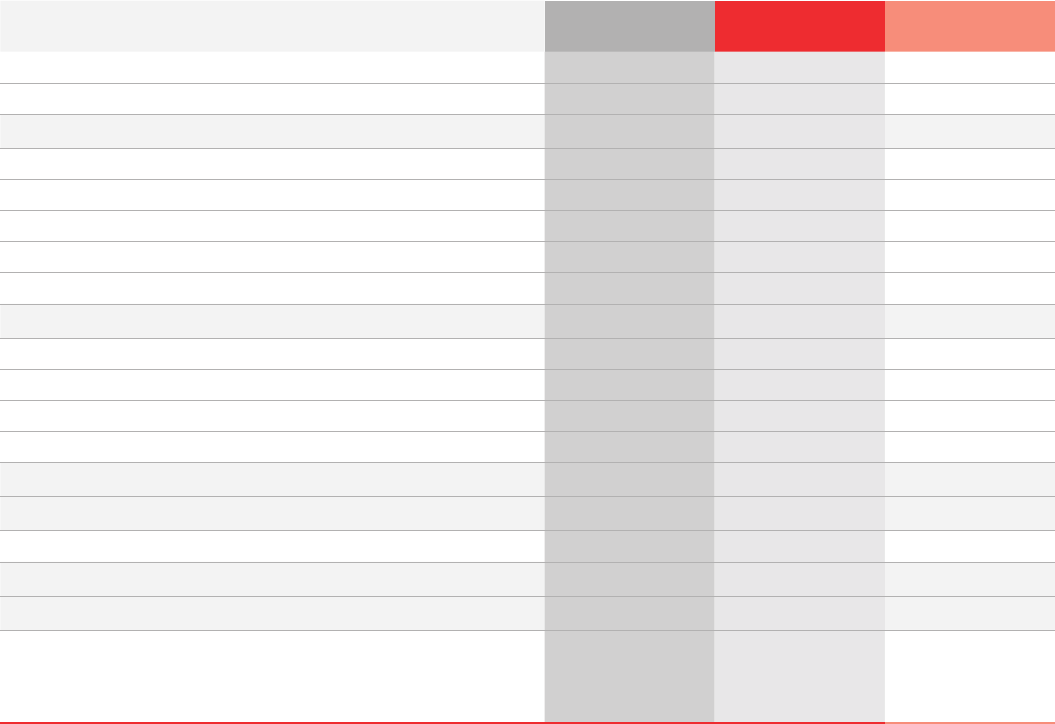
28
Annual Report of Yeti GermanCo 1 GmbH 2020
Consolidated Financial Statements
of Yeti GermanCo 1 GmbH 2020
Consolidated Income Statement
of Yeti GermanCo 1 GmbH, Sulzbach (Taunus), for the period from January 1 to December 31, 2020 (in K€)
Note
Jan. 1 - Dec. 31,
2020
Jan. 1 - Dec. 31,
2019
Revenue 4 1,965,492 1,687,608
Cost of sales 5 (1,001,068) (871,564)
Gross profit 964,424 816,044
Selling and distribution expenses 6 (588,614) (542,604)
Reversal of impairment / (impairment) on trade receivables 32 (2,861) (4,026)
General and administrative expenses 7 (181,113) (169,558)
Other operating income 8 27,310 28,637
Other operating expenses 9 (24,164) (48,278)
Operating income 194,982 80,215
Income from investments accounted for using the equity method 10, 16 58 326
Other investment result, net 10 (968) (668)
Finance income 10 11,369 31,699
Finance costs 10 (136,041) (115,333)
Financial result, net (125,582) (83,976)
Profit before tax 69,400 (3,761)
Income / (expense) from income taxes 11 (16,939) 6,970
Profit after tax 52,461 3,209
Consolidated net profit 52,461 3,209
Attributable to:
Shareholders of the parent company 51,737 2,695
Non-controlling interests 724 514
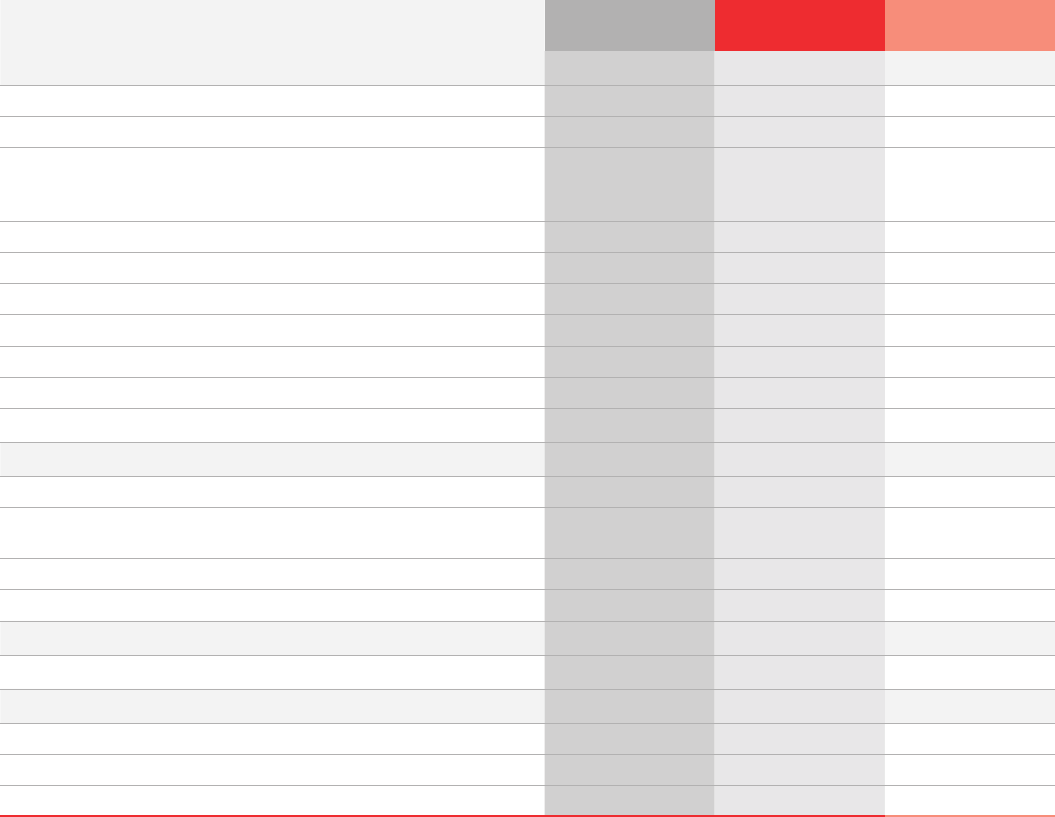
29
Annual Report of Yeti GermanCo 1 GmbH 2020
Consolidated Statement of Comprehensive Income
of Yeti GermanCo 1 GmbH, Sulzbach (Taunus), for the period from January 1 to December 31, 2020 (in K€)
For further information on equity, please refer to the comments on the consolidated statement of changes in equity below and note
30 “Equity” in the notes to the consolidated financial statements.
Note
Jan. 1 - Dec. 31,
2020
Jan. 1 - Dec. 31,
2019
Consolidated net profit 52,461 3,209
Items that may be reclassified to profit or loss
Change in translation adjustments relating to foreign subsidiaries 30 (154,152) (26,766)
Of which:
Reclassifications of currency translation differences in conjunction with
deconsolidation
− –
Result from the net investment in a foreign operation 30 4,700 6,708
Deferred taxes 11 (1,038) (1,683)
Derivative financial instruments
Change in fair value of derivatives used for hedging purposes
1
32 (14,113) (13,863)
Reclassification to profit or loss 32 9,948 4,496
Deferred taxes 11 (569) 2,781
From associates accounted for using the equity method 16 – –
(155,224) (28,327)
Items that will not be reclassified to profit or loss
Remeasurement of net defined benefit obligation for pension plans
and other employee benefits
Change in remeasurement of the net defined obligation for pension plans 25 (3,507) (7,735)
Deferred taxes 11 605 2,138
(2,902) (5,597)
Other comprehensive income (158,126) (33,924)
Total comprehensive income (105,665) (30,715)
Attributable to:
Shareholders of the parent company (105,815) (31,258)
Non-controlling interests 150 543
1
Gains / losses on financial instruments in effective hedges
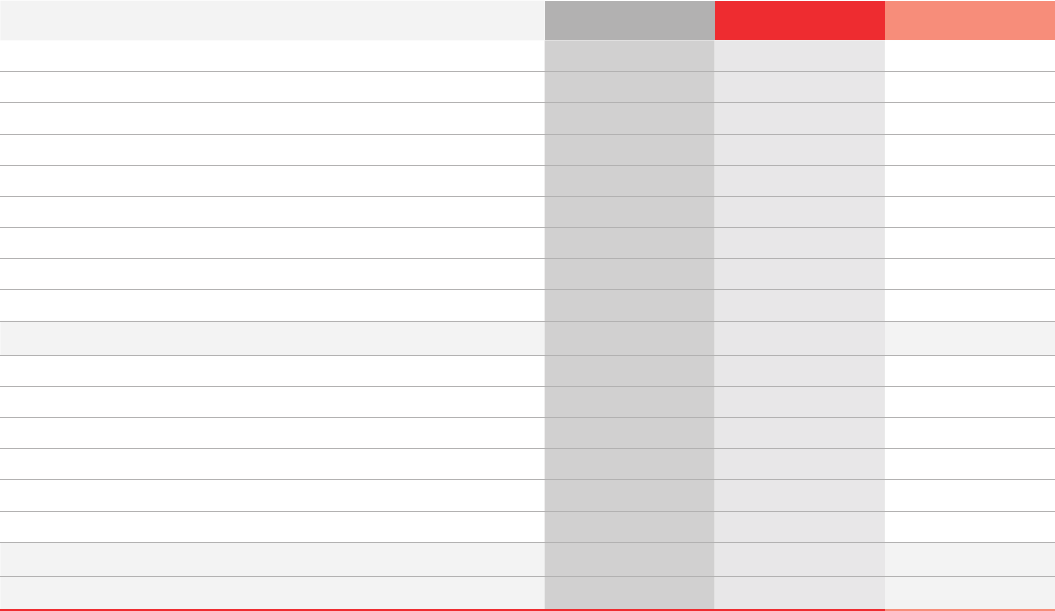
30
Annual Report of Yeti GermanCo 1 GmbH 2020
Consolidated Statement of Financial Position
of Yeti GermanCo 1 GmbH, Sulzbach (Taunus) as of December 31, 2020 (in K€)
Assets
Note Dec. 31, 2020 Dec. 31, 2019
Goodwill 14 566,429 655,901
Right-of-use assets 14 78,814 84,182
Other intangible assets 14 1,005,648 1,162,332
Property, plant and equipment 15 2,017,836 2,223,363
Investments accounted for using the equity method 16 5,680 5,894
Equity investments and other financial investments 17, 18 1,494 1,494
Deferred tax assets 11 16,909 6,323
Other financial assets 19 25,375 37,364
Non-financial assets 19 1,959 1,357
Non-current assets 3,720,144 4,178,210
Inventories 20 156,361 184,521
Trade receivables 21 256,792 276,407
Current income tax assets 45,285 20,926
Other current financial assets 23 24,434 42,319
Non-financial assets 23 42,788 54,921
Cash and cash equivalents 24 410,807 577,422
Current assets 936,467 1,156,516
Total assets 4,656,611 5,334,726
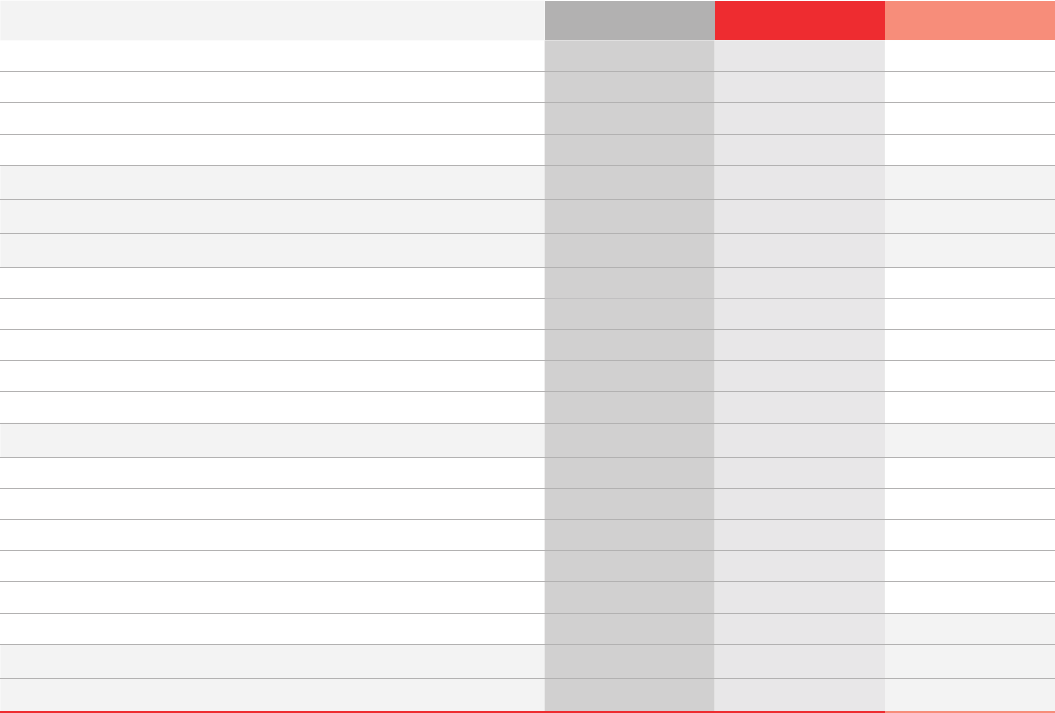
31
Annual Report of Yeti GermanCo 1 GmbH 2020
Consolidated Statement of Financial Position
of Yeti GermanCo 1 GmbH, Sulzbach (Taunus) as of December 31, 2020 (in K€)
Equity and Liabilities
Note Dec. 31, 2020 Dec. 31, 2019
Issued capital 30 30 30
Capital reserves 30 1,329,973 1,329,973
Retained earnings 30 53,133 4,298
Other components of equity 30 (183,007) (28,357)
Equity attributable to shareholders of the parent company 1,200,129 1,305,944
Non-controlling interests 30 3,648 4,195
Equity 1,203,777 1,310,139
Provisions for employee benefits 25 47,162 49,708
Other provisions 26 60,932 51,067
Non-current financial liabilities 27 2,333,741 2,502,734
Deferred tax liabilities 11 466,019 529,505
Other non-current financial liabilities 28 2,052 −
Non-current liabilities 2,909,906 3,133,014
Other provisions 26 26,532 26,859
Current financial liabilities 27 23,375 23,521
Trade payables 32 148,045 215,231
Current income tax liabilities 29 27,022 283,166
Other current financial liabilities 29 83,099 33,176
Non-financial liabilities 29 234,855 309,620
Current liabilities 542,928 891,573
Total equity and liabilities 4,656,611 5,334,726
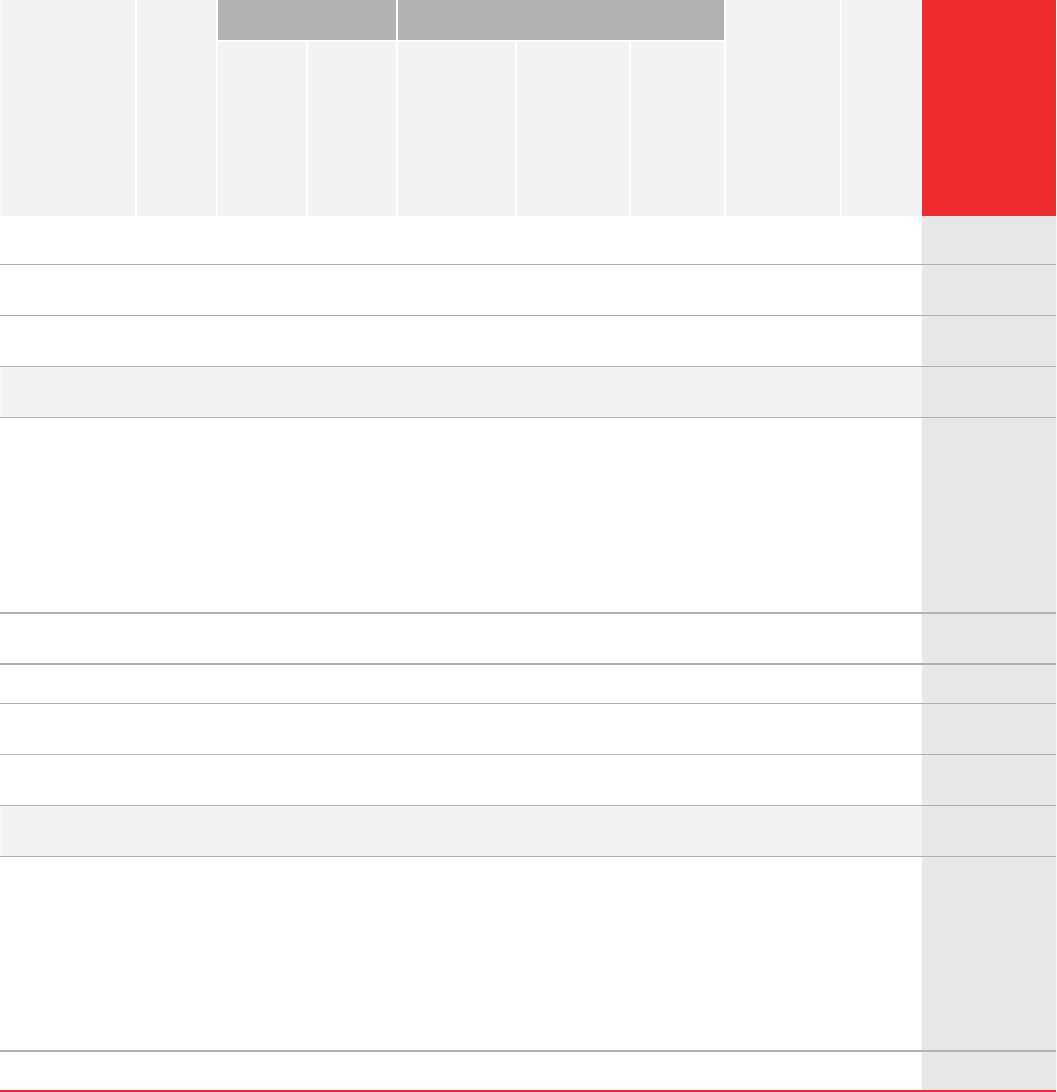
32
Annual Report of Yeti GermanCo 1 GmbH 2020
Consolidated Statement of Changes in Equity
of Yeti GermanCo 1 GmbH, Sulzbach (Taunus), for fiscal 2020 (in K€)
For further information on equity, please refer to the comments under note 30 “Equity” in the notes to the consolidated financial
statements.
Issued
capital
Reserves Other components of equity
Equity
attributable to
shareholders
of the parent
company
Non-con-
trolling
interests
Total equity
Capital
reserves
Retained
earnings
Currency
translation reserve
Hedging reserve
Result from
net invest-
ment
As of Jan. 1, 2019
25 75 7,200 (1)
– –
7,299 12 7,311
Consolidated net
profit
– –
2,695
– – –
2,695 514 3,209
Other comprehen-
sive income
– –
(5,597) (26,795) (6,586) 5,025 (33,953) 29 (33,924)
Total comprehen-
sive income
– –
(2,902) (26,795) (6,586) 5,025 (31,258) 543 (30,715)
Additions to/
withdrawals from
reserves
– – – – – – – – –
Distributions
– – – – – – – – –
Capital increase
5 1,329,898
– – – –
1,329,903
–
1,329,903
Capital reduction
– – – – – – – –
—
Additions/disposals
of non-controlling
interests
– – – – – – –
3,640 3,640
As of Dec. 31, 2019
30 1,329,973 4,298 (26,796) (6,586) 5,025 1,305,944 4,195 1,310,139
As of Jan. 1, 2020
30 1,329,973 4,298 (26,796) (6,586) 5,025 1,305,944 4,195 1,310,139
Consolidated net
profit
– –
51,737
– – –
51,737 724 52,461
Other comprehen-
sive income
– –
(2,902) (153,578) (4,734) 3,662 (157,552) (574) (158,126)
Total comprehen-
sive income
— — 48,835 (153,578) (4,734) 3,662 (105,815) 150 (105,665)
Additions to/
withdrawals from
reserves
– – – – – – –
(1) (1)
Distributions
– – – – – – –
(696) (696)
Capital increase
– – – – – – – – –
Capital reduction
– – – – – – – – –
Additions/disposals
of non-controlling
interests
– – – – – – – – –
As of Dec. 31, 2020
30 1,329,973 53,133 (180,374) (11,320) 8,687 1,200,129 3,648 1,203,777
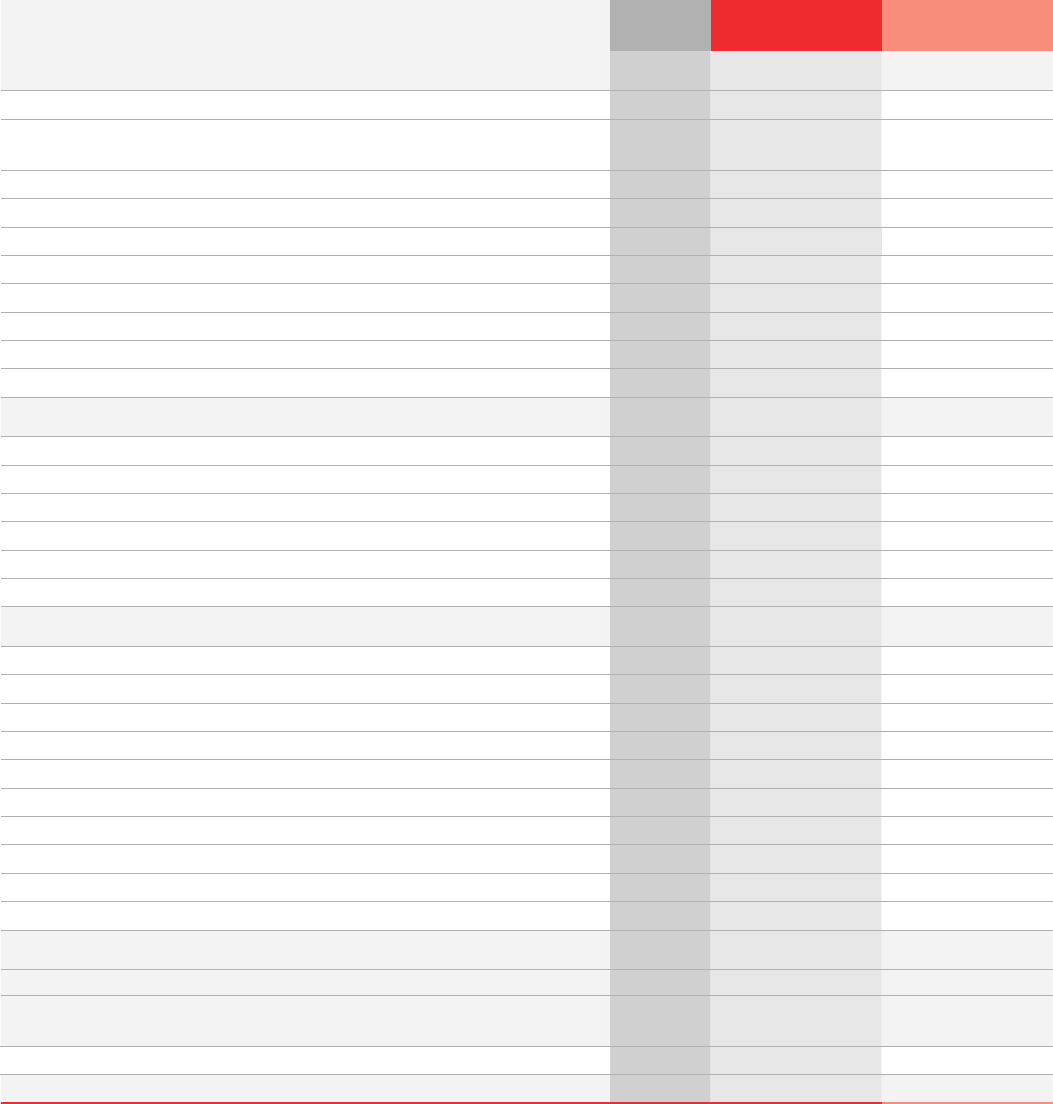
33
Annual Report of Yeti GermanCo 1 GmbH 2020
Consolidated Statement of Cash Flows
of Yeti GermanCo 1 GmbH, Sulzbach (Taunus), for fiscal 2020 (in K€)
Note
Jan. 1 - Dec. 31,
2020
Jan. 1 - Dec. 31,
2019
Consolidated net profit before taxes 69,400 (3,761)
Income taxes paid (283,160) (88,311)
Depreciation of property, plant and equipment, amortization of
intangible assets and impairment
14, 15 346,058 292,604
Losses / (gains) on disposal of fixed assets (7,352) (2,516)
Changes in investments in associates 16 (58) (326)
Net interest income 10 85,816 83,796
Changes in inventories 13,191 23,793
Changes in trade receivables (6,574) 33,030
Changes in provisions (430) 9,986
Changes in trade payables (14,891) 46,221
Changes in other liabilities and other assets 20,581 19,794
Cash flow from operating activities 222,581 414,310
Investments in property, plant and equipment and intangible assets (240,746) (249,420)
Investments in equity investments and other non-current assets – (2,501,285)
Capital reductions and dividends received from associates 136 –
Proceeds from disposals of property, plant and equipment and intangible assets 15,304 17,240
Disbursement from disposals of subsidiaries and loans – (323)
Interest received 7,316 10,134
Cash flow from investing activities (217,990) (2,723,654)
Changes in capital by shareholders of Yeti GermanCo 1 GmbH — 557,883
Proceeds from non-current financial liabilities 3,317 2,525,732
Proceeds from current financial liabilities 50 175
Repayments of non-current financial liabilities (19,428) (15,692)
Repayments of current financial liabilities (69) (187)
Payments for lease liabilities (16,104) (9,388)
Transaction costs – (74,727)
Distributions to non-controlling interests (696) –
Interest paid (91,185) (95,125)
Other net finance costs (9,680) 80
Cash flow from financing activities (133,795) 2,888,751
Changes in cash and cash equivalents (129,204) 579,407
Cash and cash equivalents
at the beginning of the period
577,422 124
Currency translation effect on cash and cash equivalents (37,411) (2,109)
at the end of the period 410,807 577,422
34
Annual Report of Yeti GermanCo 1 GmbH 2020
1. General Information
Yeti GermanCo 1 GmbH (the “Company”) is a holding company with the business address Messer-Platz 1,
65812 Bad Soden am Taunus, and is based in Sulzbach (Taunus), Germany, registered with the Frankfurt /
Main Local Court under the number HRB 111626. Yeti GermanCo 1 GmbH is the parent company of the
Messer Industries Group (the “Group”), which produces and sells industrial gases (in particular oxygen,
nitrogen, argon, helium, carbon dioxide, hydrogen and rare and high-purity gases), processes for their use
and systems located on the customer’s property (on-site plants) for gas production. The main customers of
the Messer Industries Group include important companies from the manufacturing, chemical, steel-producing
and pharmaceutical industries, the food industry and waste management.
Yeti GermanCo 1 GmbH was founded as a joint venture by Messer Group GmbH and CVC Capital Partners
(CVC), UK, with the purpose of assuming the management of Messer’s business in Western Europe and the
Americas. In this context, Messer Group GmbH has contributed its Western European operating activities
in Spain, Portugal, Switzerland, France, Belgium, the Netherlands, Denmark, Germany and the company in
Algeria, plus a right-of-use asset for the ‚Messer - Gases for Life‘ brand, to the joint venture for a period of
ten years as of March 1, 2019. The requirements of section 315e (3) of the Handelsgesetzbuch (HGB –
German Commercial Code) for the preparation of the consolidated financial statements of Yeti GermanCo 1
GmbH in accordance with the International Financial Reporting Standards (IFRS) have been satisfied.
Comparisons with the previous year are limited as the Messer Industries Group only became operational
effective March 1, 2019.
The reporting date for Yeti GermanCo 1 GmbH and all the subsidiaries included in the consolidated financial
statements is December 31 of the calendar year.
The consolidated financial statements of the Company for the fiscal year ended December 31, 2020 will
be submitted to the Audit Committee of the Advisory Board of the Messer Industries Group after being
prepared by the Managing Director. After being discussed by the Audit Committee, the managing directors
will present the consolidated financial statements to the shareholders for approval.
Notes to the Consolidated
Financial Statements
of Yeti GermanCo 1 GmbH 2020
35
Annual Report of Yeti GermanCo 1 GmbH 2020
Messer GasPack 2 GmbH, Messer Industriegase GmbH, Messer Industries GmbH, Messer Produktions-
gesellschaft mbH Salzgitter, Messer Produktionsgesellschaft mbH Siegen, Messer Produktionsgesellschaft
mbH Speyer, Yeti GermanCo 2 GmbH, Yeti GermanCo 3 GmbH, all consolidated domestic subsidiaries, will use
the exemption provisions in accordance with section 264 (3) HGB and will therefore not disclose their annual
financial statements for 2020, nor will they prepare (HGB) notes or a management report.
2. Accounting Policies
Basis of preparation
The consolidated financial statements are prepared in euro. Unless stated otherwise, all amounts are
rounded to thousands (K€). Differences may arise due to rounding.
Statement of compliance with IFRS
The consolidated financial statements for 2020 have been prepared in accordance with International
Financial Reporting Standards (IFRS) and the Interpretations of the IFRS Interpretations Committee (IFRS
IC), as applicable in the EU.
The accounting policies on which the 2020 consolidated financial statements are based have been applied
consistently.
The consolidated financial statements have been prepared on the basis of historical cost, amortized cost
and the fair value from market measurement of available-for-sale financial assets and financial liabilities
(including derivative financial instruments).
Estimates are required in order to prepare the consolidated financial statements in accordance with IFRS
and the Interpretations issued by the IFRS Interpretations Committee, as applicable in the EU. Moreover,
the application of uniform Group accounting policies requires judgments on the part of management.
New financial reporting standards and interpretations
The following new or revised standards and interpretations are effective for the first time for these consoli-
dated financial statements on January 1, 2020:
• Amendments to References to the Conceptual Framework in IFRS Standards
• Amendments to IFRS 3 – Definition of a Business
• Amendments to IFRS 9, IAS 39 and IFRS 7 – Interest Rate Benchmark Reform
• Amendments to IAS 1 and IAS 8 – Definition of Material
• Amendments to IFRS 16 – Covid-19-Related Rent Concessions (effective from June 1, 2020)
Amendments to References to the Conceptual Framework in IFRS Standards
The revised Conceptual Framework consists of a new introductory explanation on the status and purpose of
the Conceptual Framework and eight complete sections. It now contains sections on “The reporting entity”
and “Presentation and disclosure”; “Derecognition” was added to the section on “Recognition”.
36
Annual Report of Yeti GermanCo 1 GmbH 2020
The content was also amended: For example, “income” is no longer divided into “revenues” and “gains”.
Together with the amended Conceptual Framework, references to the Conceptual Framework were revised
in various standards.
The changes have no material impact on the consolidated financial statements of Yeti GermanCo 1 GmbH.
Amendments to IFRS 3 – Definition of a Business
The IASB’s amendments clarify that, to be considered a business, an acquired set of activities and assets
must include, at a minimum, an input and a substantive process that together significantly contribute to
the ability to create output. Also, the definition of outputs is narrowed by focusing on goods and services
provided to customers; the reference to an ability to reduce costs is removed. The IASB has also introduced
an optional concentration test that permits a simplified assessment of a business.
This has no material impact on the consolidated financial statements of Yeti GermanCo 1 GmbH.
Amendments to IFRS 9, IAS 39 and IFRS 7 – Interest Rate Benchmark Reform – Phase 1
The amendments result from existing uncertainty in connection with the IBOR reform. Under existing
hedge accounting rules, in many cases the pending changes in interest rate benchmarks would lead to the
discontinuation of hedging relationships. The continuation of hedging relationships is now possible. To this
end, the amendments provide relief from applying specific previous hedge accounting requirements, e.g.,
assessing whether a forecast transaction is highly probable in the context of cash flow hedges.
The changes have no material impact on the consolidated financial statements of Yeti GermanCo 1 GmbH.
Amendments to IAS 1 and IAS 8 – Definition of Material
The amendments provide a uniform and precise definition across all IFRSs of what makes information in
the financial statements material, and provide accompanying examples. The amendments also harmonize
the definitions from the Conceptual Framework, IAS 1, IAS 8 and IFRS Practice Statement 2 Making
Materiality Judgements.
This has no material impact on the consolidated financial statements of Yeti GermanCo 1 GmbH.
Amendments to IFRS 16 – COVID-19-Related Rent Concessions
IFRS 16 specifies how lessees should account for changes in lease payments, including concessions. For
each lease, the lessee must assess whether the rent concession is a modification of the lease and thus
remeasure the lease liability.
The amendment to IFRS 16 grants a practical expedient if applied. This is temporary and subject to meeting
certain conditions. Under the practical expedient, lessees may elect not to assess whether certain COVID-19-
related rent concessions are lease modifications and account for these rent concessions as if they were not
lease modifications. The amendments are effective for reporting periods beginning on or after June 1, 2020.
This has no material impact on the consolidated financial statements of Yeti GermanCo 1 GmbH.
37
Annual Report of Yeti GermanCo 1 GmbH 2020
New financial reporting standards not yet effective:
The following new standards and amendments to standards were not yet effective for these consolidated
financial statements and were therefore not applied, but had already been endorsed by the EU and will be
binding from fiscal 2021 onwards:
• Amendments to IFRS 4 – Extension of the Temporary Exemption from Applying IFRS 9 (effective from
fiscal 2021)
• Amendments to IFRS 9, IAS 39, IFRS 7, IFRS 4 and IFRS 16 – Interest Rate Benchmark Reform –
Phase 2 (effective from fiscal 2021)
• IFRS 17 (including amendments to IFRS 17) – Insurance Contracts (effective from fiscal 2023)
• Amendments to IFRS 3 – References to the Conceptual Framework (effective from fiscal 2022)
• Amendments to IFRS 10 and IAS 28 – Sale or Contribution of Assets between an Investor and its
Associate or Joint Venture (effective date deferred indefinitely)
• Amendments to IAS 1 – Classification of Liabilities as Current or Non-Current (effective from fiscal
2023)
• Amendments to IAS 16 – Property, Plant and Equipment – Proceeds before Intended Use (effective
from fiscal 2022)
• Amendments to IAS 37 – Onerous Contracts – Cost of Fulfilling a Contract (effective from fiscal 2022)
• Annual Improvements to IFRSs 2018-2020 Cycle – Amendments to IFRS 1, IFRS 9, IFRS 16 and IAS 41
(effective from fiscal 2022)
• Amendments to IAS 1 and IFRS Practice Statement 2 – The amendments deal with the disclosure of
material accounting policies and the application of the materiality concept (effective from fiscal 2023)
• Amendments to IAS 8 – The amendments clarify how an entity should distinguish accounting changes
from changes in estimates (effective from fiscal 2023)
The Group is not planning early adoption of the new or amended standards and interpretations that become
effective in subsequent fiscal years. Unless stated otherwise, the impact on the consolidated financial
statements of Yeti GermanCo 1 GmbH is currently being examined.

38
Annual Report of Yeti GermanCo 1 GmbH 2020
Consolidation principles
A complete list of the Group’s equity investments can be found in the annex to these notes. Material
subsidiaries as of December 31, 2020 are:
The consolidated financial statements comprise the financial statements of Yeti GermanCo 1 GmbH and
the financial statements of its subsidiaries as of December 31, 2020. The financial statements of the
subsidiaries are prepared using uniform accounting policies and for the same reporting period as the
financial statements of the parent company.
a. Subsidiaries
Yeti GermanCo 1 GmbH and its subsidiaries controlled by Yeti GermanCo 1 GmbH are included in the
consolidated financial statements as of December 31, 2020. The Group controls an entity when it has
exposure or rights to variable returns from its involvement with the entity and the ability to utilize its control
so as to influence the amount of returns from the entity. Subsidiaries are included in the consolidated
financial statements from the date on which control is achieved and until the date on which control ends.
All receivables and liabilities, revenue, income and expenses arising from intra-group transactions are
eliminated in the consolidated financial statements. Intra-group transactions are performed on the basis of
full cost transfer prices.
Subsidiaries are accounted for using the acquisition method. The cost of the acquisition represents the fair
value of the assets transferred, the liabilities incurred or assumed and the equity interests issued by the
acquirer at the transaction date. It also includes the fair value of any recognized assets or liabilities resulting
from a contingent consideration arrangement. Assets, liabilities and contingent liabilities identifiable in
conjunction with a business combination are measured at fair value as of the acquisition date on initial
consolidation.
Acquisition-related costs are recognized as an expense in the period in which they are incurred.
In a business combination achieved in stages, any previously held equity interest in the acquiree is remeasu-
red at fair value as of the acquisition date. Any resulting gain or loss is recognized in the income statement.
Goodwill is measured as the excess of the cost of the acquisition, the amount of any non-controlling
interest in the acquiree and the fair value of any previously held equity interest at the date of acquisition
over the Group’s share of the net assets measured at fair value. The option of accounting for goodwill using
the full goodwill method is not exercised. If the cost is less than the fair value of the net assets of the
subsidiary acquired, the difference is reassessed and then recognized directly in profit or loss. The results of
the subsidiaries acquired or sold during the fiscal year are included in the consolidated income statement
from the time control is achieved or until control is lost.
Name and registered office of subsidiary
Country
Shareholding
in percent
Dec. 31, 2020
Shareholding
in percent
Dec. 31, 2019
Messer LLC Inc., Delaware USA 10 0 % 10 0 %
Messer Canada Inc., Ontario Canada 10 0 % 10 0 %
Messer Gases Ltda., Sao Paulo Brazil 100 % 10 0 %
Messer France S.A.S., Suresnes France 100 % 10 0 %
39
Annual Report of Yeti GermanCo 1 GmbH 2020
b. Transactions with non-controlling interests without loss of control
Transactions with non-controlling interests without a loss of control are treated in the same way as transac-
tions with the Group’s equity owners. Any difference arising from the acquisition of a non-controlling
interest between the consideration paid and the relevant share in the carrying amount of the net assets of
the subsidiary is recognized in equity. Gains and losses arising from the disposal of non-controlling interests
are also recognized in equity.
c. Disposal of subsidiaries
If the Group loses control of an entity, the Group’s remaining interest is remeasured at fair value and the
resulting difference recognized in profit or loss. Furthermore, all amounts reported in other comprehensive
income relating to this entity are accounted for as if the parent company had directly disposed of the related
assets or liabilities. This means that any profit or loss previously recognized in other comprehensive income
is reclassified either to profit and loss or to retained earnings.
d. Associates, joint ventures and joint operations
Investments in entities over which the Group has significant influence but without control or joint control
over financial and operating policy and joint ventures over which the Group has joint control are accounted
for using the equity method. These are initially measured at cost, including transaction costs. Significant
influence is assumed if the Group holds 20% or more of the voting power but does not control the investee.
The Group’s share in earnings of equity investments is shown under “Income from investments accounted
for using the equity method”. The carrying amounts of equity investments are written down if impaired. The
Group’s interest in associates and joint ventures includes the goodwill arising on acquisition (net of accumu-
lated impairment losses).
If the ownership interest in an associate or joint venture is reduced but the investment continues to be
an associate or joint venture, only a proportionate amount of the gain or loss previously recognized in other
comprehensive income is reclassified to profit or loss, if this would also occur on the disposal of the
individual assets and liabilities.
The Group’s share of the profit or loss of associates and joint ventures is recognized in profit or loss from
the acquisition date. Changes in reserves are recognized pro rata in consolidated reserves. Accumulated
changes after acquisition are offset against the carrying amount of the investment. If the Group’s share of
the loss in an associate or joint venture is equal to or exceeds the Group’s share in this investee, including
other unsecured receivables, the Group recognizes no further losses unless it has entered into commit-
ments for the associate or joint venture or has made payments for the associate or joint venture.
As of the end of each reporting period, the Group determines whether there is objective evidence that
the investment in the associate or joint venture is impaired. If this is the case, the difference between the
carrying amount and the recoverable amount is recognized as an impairment loss and reported in the
income statement under the income from the investment in the associate or joint venture.
To the extent that a Group entity performs transactions with an associate or joint venture, any unrealized
gains or losses are eliminated on the basis of the Group’s interest in this entity.
40
Annual Report of Yeti GermanCo 1 GmbH 2020
A joint operation is a joint arrangement whereby the parties that have joint control of the arrangement have
rights to the assets, and obligations for the liabilities, relating to the arrangement.
The associated assets and liabilities, income and expenses from joint operations are included in the consoli-
dated financial statements according to the economically attributable share.
The Group recognizes its direct rights to the assets, liabilities, revenue and expenses of joint operations and
their share in any assets, liabilities, revenue and expenses jointly managed or incurred. These are included in
the financial statements under the corresponding line items. Details of joint operations recognized in the
financial statements can be found under note 16 “Interests in Other Entities”.
Currency translation
a. Functional currency and reporting currency
The consolidated financial statements are presented in euro, the Group’s reporting currency. The functional
currency of individual foreign operations is determined by the economic environment in which they operate.
The items included in the financial statements of the respective company are measured using this functional
currency.
b. Transactions and balances
Foreign currency transactions are initially translated using the spot exchange rate between the functional
currency and the foreign currency at the transaction date. Monetary assets and liabilities denominated in a
foreign currency are translated into the functional currency at the closing rate. All exchange differences are
recognized in profit or loss. This does not include exchange differences from certain intragroup foreign
currency borrowings to the extent that they are used to hedge net investments in foreign operations.
These exchange differences, and any deferred taxes arising from them, are recognized directly in equity.
Non-monetary items that are measured in terms of historical cost in a foreign currency are translated using
the exchange rate at the date of the transaction. Non-monetary items that are measured at fair value in a
foreign currency are translated using the exchange rates at the date when the fair value was determined.
Foreign currency gains and losses that essentially result from trade receivables and trade payables denomi-
nated in foreign currencies are included in “Other operating income” or “Other operating expenses”.
c. Group companies
The functional currency of foreign operations not based within the area of the European Currency Union
(ECU) is the respective local currency. As of the end of the reporting period, assets and liabilities of these
subsidiaries are translated into the Messer Industries Group’s reporting currency using the closing rate.
Income and expenses are translated at average rates for the fiscal year. The resulting exchange differences
are recognized through other comprehensive income and included in currency translation reserves within
equity. They therefore do not affect profit or loss. When a foreign operation is deconsolidated, the cumulative
amount recognized in equity for this foreign operation is reversed to profit or loss.

41
Annual Report of Yeti GermanCo 1 GmbH 2020
The following table shows an overview of the exchange rates used for the principal currencies:
Intangible assets and goodwill
The differences between the consideration transferred by the Messer Industries Group for acquirees and
the fair value of the assets acquired, liabilities assumed and contingent liabilities are recognized in accordance
with IFRS 3.32 et seq. The remaining goodwill is tested for impairment in accordance with IAS 36 at least
once a year.
The other intangible assets such as brands, patents, licenses, customer bases, software, etc. are initially
measured at cost. Patents, licenses, customer bases and software, etc. are amortized on a straight-line
basis over their expected useful lives of three to 47.5 years. The amortization charge on other intangible
assets is reported within the related expense item, usually cost of sales or distribution and selling expenses.
The amortization period and the amortization method for an intangible asset with a finite useful life are
reviewed at least at the end of each fiscal year.
Average rates Closing rates
Selected
currencies
ISO-
Code
Jan. 1 - Dec. 31, 2020
€1
Jan. 1
- Dec. 31, 2019
€1
Dec. 31, 2020
€1
Dec. 31, 2019
€1
Brazilian real BRL 5.88 4.42 6.37 4.52
Chilean peso CLP 903.13 792.19 872.14 845.88
Canadian dollar CAD 1.53 1.49 1.56 1.46
Colombian peso COP 4,215.38 3,696.05 4,200.50 3,688.10
Swiss franc CHF 1.07 1. 11 1.08 1.09
US Dollar USD 1.15 1. 12 1.23 1. 12

42
Annual Report of Yeti GermanCo 1 GmbH 2020
Property, plant and equipment
Property, plant and equipment are recognized at cost and depreciated over their expected useful lives. The
cost of acquired property, plant and equipment includes all costs directly attributable to their acquisition. The
cost of self-constructed items of property, plant and equipment includes all directly attributable direct costs
and an appropriate share of overheads, including depreciation, and are therefore measured taking all costs
required to construct the assets into account. In the event of a statutory requirement to restore an item to
its original condition, the cost also includes the present value of expected future payments for decommissi-
oning and restoration. When each major inspection is performed, in accordance with IAS 16.14, its cost is
recognized in the carrying amount of the item of property, plant and equipment as a replacement if the
recognition criteria are satisfied.
Subsequent costs are only recognized as part of the cost of the asset or as a separate asset when it is
probable that they will result in future economic benefits to the Group and the costs can be measured
reliably.
Expenditure for repairs and maintenance, which does not represent a significant replacement investment, is
recognized as an expense in the fiscal year in which it is incurred.
Gains and losses on the disposal of property, plant and equipment are calculated as the difference between
proceeds from disposal and the carrying amounts of the assets and recognized in the consolidated income
statement.
Depreciation is recognized on a straight-line basis over the following useful lives:
The residual carrying amounts and useful lives are reviewed at the end of each reporting period and
adjusted as necessary. If the carrying amount of an item of property, plant and equipment exceeds the
estimated recoverable amount, it is written down to that recoverable amount.
Borrowing costs are recognized as an expense in the period in which they are incurred, except when they
relate to qualifying assets. Within the Messer Industries Group, these chiefly relate to air separation units.
Borrowing costs that are directly attributable to the acquisition, construction or production of a qualifying
asset are capitalized as part of the cost of that asset up to the date when substantially all the activities
necessary to prepare the qualifying asset for its intended use or sale are complete. A qualifying asset is an
asset that necessarily takes a substantial period of time to get ready for its intended use or sale.
Depreciation
Useful life in years
Buildings 10 - 50
Plant and machinery
thereof air separation units
5 - 20
15
Other operating and office equipment 3 - 10
43
Annual Report of Yeti GermanCo 1 GmbH 2020
Leases
a. Leases in which the Group is the lessee
The Group leases various offices, warehouses, equipment and vehicles. Leases are generally concluded for
fixed periods of one month to 10 years for movable assets and for one month to 50 years for immovable
assets, but may have extension options.
At the inception of a contract, the Group assesses whether the contract is, or contains, a lease. A contract
is, or contains, a lease if the contract conveys the right to control the use of an identified asset for a period
of time in exchange for consideration. The Group uses the IFRS 16 definition of a lease to assess whether a
contract includes the right to control an identifiable asset.
Contracts may contain both lease and non-lease components. The Group assigns the transaction price to
these components based on their relative stand-alone prices. However, for leases of real estate for which
the Group is a lessee, it has elected not to separate lease and non-lease components and instead accounts
for these as a single lease component.
Lease terms are negotiated on an individual basis and contain a wide range of different terms and conditions.
The lease agreements do not impose any covenants other than the security interests in the leased assets
that are held by the lessor. Leased assets may not be used as security for borrowing purposes.
Leases are recognized as a right-of-use asset and a corresponding liability at the date at which the leased
asset is available for use by the Group. Assets and liabilities arising from a lease are initially measured on a
present value basis. Lease liabilities include the net present value of the following lease payments:
• fixed payments (including in-substance fixed payments), less any lease incentives receivable;
• variable lease payment that are based on an index or a rate, initially measured using the index or rate as
at the commencement date;
• amounts expected to be payable by the Group under residual value guarantees;
• the exercise price of a purchase option if the Group is reasonably certain to exercise that option; and
• payments of penalties for terminating the lease, if the lease term reflects the Group exercising that
option.
Lease payments to be made under reasonably certain extension options are also included in the measure-
ment of the liability. The lease payments are discounted using the interest rate implicit in the lease. If
that rate cannot be readily determined, which is generally the case for leases in the Group, the lessee’s
incremental borrowing rate is used, being the rate that the individual lessee would have to pay to borrow
the funds necessary to obtain an asset of similar value to the right-of-use asset in a similar economic
environment with similar terms, security and conditions.
To determine the incremental borrowing rate, the Group:
uses recent third-party financing received by the individual lessee as a starting point. Lessees are divided
into regions according to geographical segments. The financing is divided into groups based on the remaining
terms of the contracts (up to 1 year, up to 2 years, up to 3 years, up to 4 years, up to 5 years and longer
than 5 years). The calculated average interest rates for each group and region are used in measuring the
right-of-use asset and lease liability.

44
Annual Report of Yeti GermanCo 1 GmbH 2020
The Group is exposed to potential future increases in variable lease payments based on an index or rate.
These possible changes in lease payments are not taken into account in the lease liability until they take
effect. When adjustments to lease payments based on an index or rate take effect, the lease liability is
reassessed and adjusted against the right-of-use asset.
Lease payments are allocated between principal and finance cost. The finance cost is charged to profit or
loss over the lease period so as to produce a constant periodic rate of interest on the remaining balance
of the liability for each period.
Right-of-use assets are measured at cost comprising the following:
• the amount of the initial measurement of the lease liability;
• any lease payments made at or before the commencement date less any lease incentives received;
• any initial direct costs; and
• estimated costs incurred by the lessee in dismantling or removing the underlying asset, restoring the
location where it is to be found or restoring the underlying asset to the condition required in the lease
agreement.
Right-of-use assets are generally depreciated over the shorter of the asset’s useful life and the lease term
on a straight-line basis. If the Group is reasonably certain to exercise a purchase option, the right-of-use
asset is depreciated over the underlying asset’s useful life.
Depreciation is recognized on a straight-line basis over the following useful lives:
Payments associated with short-term leases of equipment and vehicles and all leases of low-value
assets are recognized as an expense in profit or loss. Short-term leases are leases with a lease term of
12 months or less. Low-value assets essentially comprise IT equipment and other equipment.
Extension and termination options are included in a number of property and equipment leases across
the Group. These are used to maximize operational flexibility in terms of managing the assets used in
the Group’s operations. These options are taken into account in the measurement of right-of-use assets
and lease liabilities when there is reasonable assurance.
The lease term is reassessed if an option is actually exercised (or not exercised) or the Group becomes
obliged to exercise (or not exercise) it. The assessment of reasonable certainty is only revised if a
significant event or a significant change in circumstances occurs, which affects this assessment, and
that is within the control of the lessee.
Depreciation
Useful life in years
Land 1 - 50
Buildings 1 - 30
Plant and machinery 1 - 10
Other operating and office equipment 1 - 5
45
Annual Report of Yeti GermanCo 1 GmbH 2020
b. Leases in which the Group is the lessor
If the Group is the lessor, it classifies each lease as either a finance lease or an operating lease at inception
of the lease.
Leases in which a significant portion of the risks and rewards of ownership transfers to the lessee are classi-
fied as finance leases.
In this case, disposal is assumed at the start of the lease term and revenue is recognized in the amount
of the present value of the minimum lease payments attributable to the asset. In return, a claim from the
customer that is reduced over the term of the contract is recognized. Interest income earned on finance
leases is reported as other financial income.
No finance leases were identified within the Messer Industries Group.
Leases in which a significant portion of the risks and rewards of ownership remain with the lessor, are
classified as operating leases. Payments made in connection with an operating lease are recognized as an
expense in the income statement on a straight-line basis over the term of the lease.
Impairment and reversal of impairment on intangible assets, goodwill, right-of-use
assets and property, plant and equipment
An impairment test for goodwill, right-of-use assets, other intangible assets and property, plant and equip-
ment involves comparing the recoverable amount of the asset against its carrying amount to determine
whether it must be written down to recoverable amount. In accordance with IAS 36, goodwill is allocated to
the smallest cash-generating unit for which goodwill is monitored by management. The recoverable amount
is defined as the higher of the asset’s fair value less costs to sell and its value in use. Fair value less costs to
sell is defined as the amount obtainable from the sale of an asset or cash-generating unit in an arm’s length
transaction between knowledgeable, willing parties, less the costs of disposal. Value in use is the present
value of future cash flows expected to arise from the continuing use of an asset and from its disposal at
the end of its useful life. In the event of impairment, existing goodwill is reduced first. If the impairment
loss exceeds the carrying amount of goodwill, the difference is typically distributed among the remaining
non-current assets pro rata. With the exception of goodwill, impairment losses are reversed when the
reasons for the impairment no longer apply. Impairment losses and required reversals are shown together
with depreciation and amortization in the statement of changes in assets under additions to cumulative
depreciation and amortization, and are reported and explained separately in the notes.
Inventories
Inventories are measured at the lower of cost or net realizable value at the end of the reporting period using
the average cost method. Their production cost includes all directly attributable direct costs, appropriate
portions of materials and production overheads and depreciation.
46
Annual Report of Yeti GermanCo 1 GmbH 2020
Trade and other receivables
Trade receivables are recognized from the date they arise. Items that do not contain a significant financing
component are initially measured at the transaction price. The corresponding impairment loss is measured
at an amount equal to lifetime expected credit losses, based on an analysis of historical default data and
forecasts of future economic conditions. Expected credit losses are a probability-weighted estimate of
credit losses.
Cash and cash equivalents
Cash and cash equivalents include freely available cash on hand and demand deposits. Cash equivalents
also include short-term liquid financial assets that can be readily converted into cash at any time. This risk of
fluctuations in value is immaterial.
Employee benefits
a. Pension obligations
The Group has both defined benefit and defined contribution pension plans. A defined contribution plan is a
pension plan under which the Group pays fixed contributions into a separate non-Group entity (a fund). The
Group does not have any legal or constructive obligation to pay any additional amounts if the fund does not
have sufficient assets to meet the pension entitlements of all employees for the current and past fiscal years.
Typically, defined benefit plans set out an amount of pension benefits that employees will receive on retire-
ment and that is typically dependent on one or more factors (such as age, length of service and salary).
The Company’s obligations from defined benefit pension plans are calculated separately for each defined
benefit plan and according to actuarial principles. The benefits earned by employees in the current and prior
periods – in return for their service – are initially estimated. The present value of the defined benefit obligation,
the gross pension obligation, is calculated by actuaries using the projected unit credit method. Plan assets
are deducted from the gross pension obligation at fair value. This results in the net liability or the net asset
value to be recognized.
The Company determines net interest expense (net interest income) from the net liability (net asset value)
by multiplying the net liability (net asset value) at the beginning of the period by the interest rate with which
the defined benefit gross pension obligation is discounted at the beginning of the period.
The interest rate is determined by reference to market yields at the end of the reporting period on high
quality corporate bonds. The currency and term of the underlying corporate bonds are consistent with the
currency and estimated term of the post-employment obligations.
The calculation of the net liability (net asset) is based on an actuarial report prepared by a qualified actuary as
of the end of each reporting period.
47
Annual Report of Yeti GermanCo 1 GmbH 2020
If the deduction of plan assets from the defined benefit gross pension obligation results in an excess of plan
assets, the amount of the net asset value is limited to the present value of the economic benefits associated
with the plan asset surplus, e.g. in the form of reimbursements from the plan or reduced future contribution
payments if the Company has control over these economic advantages. Control is assumed to exist if the
Company can realize the economic benefit within the term of the pension plan or on settlement of plan
liabilities.
The calculation of the present value of the economic benefits of the excess of plan assets takes into account
any minimum funding requirements.
The amounts arising on remeasurement comprise actuarial gains and losses arising on the measurement
of the defined gross pension obligation on the one hand and the difference between the actual return on
plan assets and the rate of return assumed at the beginning of the reporting period on the other hand.
In the event that there is an excess of plan assets, the amounts arising on remeasurement also include the
change from applying an asset ceiling, to the extent that this has not been considered as part of the net
interest component.
The Group recognizes all amounts arising on remeasurement in other comprehensive income (OCI), while
other components of the net pension expense (service cost and net interest component) are recognized in
profit or loss. The interest portion of the addition to provisions included in pension expense is reported as
interest expense within net finance costs. The cumulative remeasurement effects are reported in retained
earnings within equity.
If the present value of a defined benefit obligation changes as a result of a plan amendment or curtailment,
the Group recognizes the resulting effect as past service cost in profit or loss. The amounts are recognized
when the amendment or curtailment occurs.
Defined benefit plans expose the Company to various risks. In addition to general actuarial risks such as
longevity risk and interest rate risk, the Company is exposed to currency risk and capital market / investment
risk.
b. Obligations from bonus plans
Obligations for bonus payments are recognized as a liability and as an expense. A provision is recognized in
the consolidated financial statements in cases in which there is a contractual obligation or a constructive
obligation as a result of past business practices.
Other provisions
Other provisions are recognized for present legal and constructive obligations arising from past events
that are likely to result in a future outflow of resources embodying economic benefits, provided that a
reliable estimate can be made of the amount of the obligations. If the effect of the time value of money
is material, provisions are discounted using a current pre-tax rate that reflects, when appropriate, the
risks specific to the liability. When discounting is used, the increase in the provision due to the passage
of time is recognized as interest expense.
48
Annual Report of Yeti GermanCo 1 GmbH 2020
Government grants
Government grants are recognized where there is reasonable assurance that the grant will be received and
all attached conditions will be complied with. When the grant relates to an expense item, it is recognized as
income on a systematic basis over the periods that the related costs, for which it is intended to compensate,
are expensed. If the grant relates to an asset, it is recognized as deferred income and reversed to profit or
loss on a straight-line basis over the expected useful life of the asset.
Financial instruments: principles
A financial instrument is any contract that gives rise to a financial asset of one entity and a financial liability
or equity instrument of another entity. A distinction is made between derivative and non-derivative financial
instruments.
Derivative financial instruments can be embedded in other financial instruments or non-financial instruments.
In accordance with IFRS, an embedded derivative must be separated from the host contract and measured
separately at its fair value if the economic characteristics of the embedded derivative are not closely related
to those of the host contract. The Messer Industries Group had no separable embedded derivatives in the
fiscal year. Compound financial instruments issued that contain both an equity and a debt component must
be accounted for separately on the basis of the substance of the instruments. The Messer Industries Group
was not party to any hybrid or compound financial instruments in the fiscal year. Regular way purchases and
sales of financial instruments are typically recognized by the Messer Industries Group as of the settlement
date, while derivatives are recognized as of the trade date.
Financial assets and financial liabilities are initially recognized at fair value, including any transaction costs
if necessary. The fair value of a financial instrument is the price that would be achieved between market
participants on the measurement date for the sale of the financial instrument.
Financial assets are derecognized fully or in part when the contractual rights to receive cash flows have
expired or if control over the financial asset and substantially all the risks and rewards of the asset have
been transferred to a third party. Financial liabilities are derecognized when the contractual obligations have
been settled, canceled or have expired.
The classes to be formed in accordance with IFRS 7 include the measurement categories presented below.
Furthermore, liabilities from leases and hedging derivatives in the context of hedge accounting are included
in the classes according to IFRS 7.
49
Annual Report of Yeti GermanCo 1 GmbH 2020
Financial assets
Financial assets are classified according to the following IFRS 9 measurement categories:
a. Financial assets at amortized cost (AC)
The Messer Industries Group classifies its financial assets as at amortized cost only if both of the following
criteria are met:
• the asset is held within a business model whose objective is to collect the contractual cash flows; and
• the contractual terms give rise to cash flows that are solely payments of principal and interest.
b. Financial assets at fair value through profit or loss (FVTPL)
The Messer Industries Group classifies the following primary financial assets at fair value through profit or
loss:
• debt investments that do not qualify for measurement at either amortized cost or fair value through other
comprehensive income;
• equity investments that are held for trading; and
• equity investments for which the entity has not elected to recognize fair value gains and losses through
other comprehensive income.
The Group has not designated any primary financial assets at fair value through profit or loss.
c. Financial assets at fair value through other comprehensive income (FVOCI)
Financial assets at fair value through other comprehensive income comprise:
• Equity securities which are not held for trading, and which the Messer Industries Group has irrevocably
elected at initial recognition to recognize in this category. These are strategic investments and the Group
considers this classification to be more relevant.
• Debt securities where the contractual cash flows are solely principal and interest and the objective of the
Group’s business model is achieved both by collecting contractual cash flows and selling financial assets.
The results of measuring such investments in equity instruments are reported in other comprehensive
income. On disposal of these debt securities, any related balance within other comprehensive income is
reclassified to retained earnings.
Financial liabilities
a. Financial liabilities at amortized cost (AC)
Financial liabilities at amortized cost are non-derivative financial liabilities that are subsequently measured at
amortized cost using the effective interest method. Any difference between the amount received and the
amount repayable is recognized as income or expense over the term of the instrument. Transaction costs
incurred are deducted from the respective financial liabilities and amortized over the term of the underlying
liability using the effective interest method. Within the Messer Industries Group, this measurement category
includes in particular financial liabilities, trade payables and non-derivative other current and non-current
liabilities.
50
Annual Report of Yeti GermanCo 1 GmbH 2020
b. Financial liabilities at fair value through profit or loss (FVTPL)
Financial liabilities at fair value are either classified as held for trading or designated upon initial recognition
as at fair value through profit or loss.
These financial liabilities are subsequently measured at fair value, with gains and losses from the financial
instruments in this category recognized directly in net finance costs in the income statement.
Derivative financial instruments and hedging
Derivatives are initially recognized at fair value on the date a derivative contract is entered into, and they are
subsequently remeasured to their fair value at the end of each reporting period. The accounting for subse-
quent changes in fair value depends on whether the derivative is designated as a hedging instrument and,
if so, the nature of the item being hedged. When entering into a derivative contract, the Messer Industries
Group designates it as either:
(1) a hedge of the fair value of recognized assets or liabilities (fair value hedges); or
(2) a hedge of a forecast transaction or firm commitment (cash flow hedge).
The Messer Industries Group exclusively uses derivatives for hedging if this is required by the hedged items.
This applies, for example, to risks from energy purchases, variable interest payments and exchange rate
fluctuations. Hedged items are the obligations contractually entered into to achieve the goals of the Messer
Industries Group, receivables and anticipatory transactions. Derivative instruments are thus exclusively used
to safeguard the Messer Industries Group’s business performance to the extent stipulated in its Articles or
Association. Macro hedging, i.e. the consolidation of individual positions in order to merely hedge the net
amount, is not practiced.
Most of the transactions for which this type of hedging could be applied are hedged in full in terms of
scope or amount, using a variety of financial instruments. The selection of individual instruments is always
a management decision, made in line with the risk profile, i.e. the opportunity for return associated with
the respective risk.
Hedge accounting is used for a majority of the existing hedging transactions. Nevertheless, there are
derivatives that have been contracted to hedge risks from items, for which the formal requirements have
not been fully met and which are therefore not recognized in hedge accounting, but rather as stand-alone
derivatives at fair value through profit and loss in accordance with IFRS 9.
The aim of hedge accounting is to largely offset the changes in the value of the hedging instruments and
the hedged items. Messer uses hedge accounting in accordance with IFRS 9 to avoid fluctuations in the
income statement due to the different measurement of hedged items and hedging instruments.
When entering into the transaction, the Group documents the relationship between the hedging instrument
and the hedged item in addition to the objective of its risk management and its underlying strategy. In
addition, at the inception of the hedge and thereafter, the Group documents its assessment of whether the
derivatives used in the hedge are highly effective at compensating for the changes in the fair value or cash
flow. Hedge accounting is only maintained as long as its effectiveness can be proven. Evidence of this
effectiveness is determined by comparing the contract specifics, maturities and volumes (critical terms
match) and by means of a regression analysis.
51
Annual Report of Yeti GermanCo 1 GmbH 2020
For those hedges for which hedge accounting is used, the gain or loss on remeasurement is broken down
into effective and ineffective portions. The effective portion is the portion of the gain or loss on remeasure-
ment that represents an effective hedge against the risk. For cash flow hedges, this is recognized separately
in other comprehensive income. The ineffective portion, where necessary, is immediately recognized in the
consolidated income statement.
Derivative financial instruments not subject to hedge accounting are also measured at fair value through profit
or loss.
The fair value of financial instruments is determined in accordance with IFRS 13. The fair value is derived
from financial instruments quoted on an active market or calculated using standard measurement models
(discounted cash flow method) from current market prices. If necessary, the market value provided by a
bank can also be used.
a. Cash Flow hedges
Changes in the fair values of derivatives classified as cash flow hedges that are a close match for the hedged
item are recognized in equity. If the forecast transaction or firm commitment results in the recognition of a
non-financial asset or non-financial liability, the gains and losses previously deferred in equity are removed
from equity and included in the measurement of the cost of the asset or liability. In all other cases, the gains
or losses previously recognized in equity are transferred to profit or loss in the same period as that in which
the hedged forecast transaction or firm commitment is recognized in profit or loss.
Income and operating cash flow are essentially unaffected by market interest rates, as the Group does not
hold any significant interest-bearing assets. Variable interest loans are partially hedged using interest rate
swaps and caps (cash flow hedge for future interest payments). This effectively converts loans with floating
interest rates into loans with fixed interest rates.
When a hedging instrument expires or is sold, or when a hedging instrument no longer meets the criteria
for hedge accounting in accordance with IAS 9, any cumulative gains or losses recognized in equity to date
remain there and are not removed until the forecast transaction or firm commitment is recognized in profit or
loss. However, if the forecast transaction or firm commitment is no longer expected to occur, the cumulative
gain or loss that had been recognized directly in equity is recognized in profit or loss.
b. Fair value hedges
The changes in the fair value of derivatives that are designated as a fair value hedge and are a close match
for the underlying transaction are recognized in the income statement together with the changes in the fair
value of the hedged assets or liabilities attributable to the hedged risk.
The fair values of the various derivative financial instruments are listed under note 32 “Other Financial Instru-
ment Disclosures”.
There were only cash flow hedges on December 31, 2020.
52
Annual Report of Yeti GermanCo 1 GmbH 2020
Management of financial risks
In conjunction with its operating activities, the Messer Industries Group is exposed to various financial risks,
in particular credit, liquidity, interest and currency risk, which are described in more detail under note 32
“Other Financial Instrument Disclosures”. The Group’s risk management system takes into account the fact
that financial market developments are not foreseeable and is intended to minimize any potential negative
impact on the Group’s financial position. The Group uses derivative financial instruments to hedge against
specific risks.
Risk management is handled by Group Treasury in compliance with guidelines approved by management.
Group Treasury identifies, assesses and hedges financial risks. The guidelines contain general principles for
risk management and detailed rules for specific areas, such as currency and interest rate risks, the use of
derivative financial instruments and the investment of surplus cash.
Use of assumptions, estimates and judgments
The preparation of IFRS financial statements requires management to make certain assumptions, estimates
and judgments that affect the reported amounts of assets and liabilities, the disclosure of contingent assets
and liabilities as of the end of the reporting period and the reported amounts of revenue and expenses for
the fiscal year. The estimates and assumptions concern the future. Actual results may therefore differ from
these estimates.
Estimates and their underlying assumptions are examined on an ongoing basis. Revisions of estimates are
recognized prospectively. If a change in an accounting estimate gives rise to changes in assets and liabilities,
or relates to an item of equity, the changes in estimates are recognized by adjusting the carrying amounts of
the related assets, liabilities or equity items.
COVID-19 has no material effect on the assessment of the underlying estimates and assumptions in fiscal
2020.
Judgments, assumptions concerning the future and sources of estimation uncertainty that could potentially
have the greatest impact on these consolidated financial statements were required in particular for:
a. Allocation and impairment testing of goodwill
The allocation of goodwill to the various cash-generating units or groups of cash-generating units and
impairment testing in accordance with IAS 36 on the basis of the expected future cash flows of these
cash-generating units or groups of cash-generating units over the detailed planning period of four years
are subject to estimates made by the Group. Judgments are also required to derive capitalization rates.
A change in the factors used when testing goodwill and other intangible assets or property, plant and
equipment for impairment may lead to higher, lower or no impairment.
b.Determination of useful lives of property, plant and equipment and assessing which cost
components can be capitalized
Group-wide uniform useful lives for items of property, plant and equipment are determined on the basis of
past experience and regularly reviewed. As part of the process of assessing whether an item is eligible for
recognition as an asset and which components of cost should be taken into account, we make assumptions
regarding the expected future usability of the asset.
53
Annual Report of Yeti GermanCo 1 GmbH 2020
c. Assessment of the need for and measurement of allowances for doubtful debts
When recognizing allowances for doubtful debts, estimates are made regarding the creditworthiness of
individual customers and market segments, and general economic forecasts for the different countries and
the history of our bad debts.
d. Measurement of pension obligations
Obligations from defined benefit pension commitments are calculated on the basis of actuarial assumptions.
These are mainly the discount rate, life expectancy and pension and salary trends. The interest rate is
determined by reference to market yields at the end of the reporting period on high quality corporate bonds.
Sensitivity analyses with respect to the interest rate used are provided in the notes.
e. Recognition and measurement of other provisions
Other provisions are recognized and measured on the basis of an assessment of the probability of a future
outflow of benefits, using values based on experience and circumstances known as of the end of the
reporting period. The actual outflow of economic resources at a later date could be lower or higher than the
amount recognized as a provision. The nature of estimates and judgments used differs for the various
categories of provisions.
The recognition and measurement of provisions for legal disputes requires a high degree of judgment as to
whether a current obligation exists and whether a future outflow of economic resources is probable and can
be reliably estimated. We obtain assessments from in-house and external attorneys to assess these matters.
Changes in circumstances may result in adjustments to provisions.
f. Income taxes
IFRIC 23 clarifies the recognition and measurement requirements of IAS 12 in accounting for uncertainties
in income taxes. Estimates and assumptions must be made for recognition and measurement, e.g. whether
an assessment is made separately or together with other uncertainties, whether a probable or expected
value is used for the uncertainty and whether changes have occurred compared to the previous period. The
detection risk is irrelevant for the accounting of uncertain statement of financial position items. The accoun-
ting is based on the assumption that the tax authorities are investigating the matter in question and that they
have all the relevant information.
Income taxes
The tax expense comprises current and deferred taxes. Current and deferred taxes are recognized in profit
or loss, except to the extent that they are associated with a business combination or with an item recognized
directly in equity or other comprehensive income.
The Group has determined that interest and penalties on income taxes, including uncertain tax items, do not
meet the definition of income taxes and are therefore accounted for in accordance with IAS 37.
a. Current taxes
Current taxes are the expected tax liability or tax receivable on the taxable income or loss for the fiscal year
based on tax rates that are enacted or substantively enacted at the end of the reporting period, plus any
adjustments to tax liability for prior years. The amount of the expected tax liability or tax receivable reflects
the amount that is the best estimate, taking into account tax uncertainty, if any. Current tax liabilities also
include all tax liabilities that arise as a result of dividends being determined. Current tax assets and liabilities
are only netted under certain conditions.
54
Annual Report of Yeti GermanCo 1 GmbH 2020
b. Deferred taxes
Deferred taxes are recognized, in accordance with the asset and liability method, for all temporary differen-
ces at the end of the reporting period between the carrying amounts of assets and liabilities in the statement
of financial position and their corresponding tax bases, and on the tax loss and for tax loss carryforwards.
In accordance with IAS 12.15 in conjunction with IAS 12.21B, temporary differences arising on the initial
recognition of goodwill are not included in the calculation of deferred taxes. Deferred taxes are calculated
using currently enacted or substantially enacted tax rates that will apply when the temporary differences are
expected to reverse. Deferred tax assets are recognized to the extent that it is probable that future taxable
profits will be available against which the unused tax loss carryforwards or asset-side differences between
the carrying amounts and the corresponding tax bases can be utilized.
Deferred tax assets and liabilities are only offset if they relate to income taxes levied by the same taxation
authority and the entity has a legally enforceable right to offset the tax assets and liabilities.
Income taxes relating to items that are recognized directly in other comprehensive income are also recogni-
zed in other comprehensive income and not in profit or loss. Deferred taxes are recognized in other compre-
hensive income if the underlying transaction is also recognized in other comprehensive income.
Revenue recognition
Revenue includes sales of products and services and rental income, less trade discounts and rebates.
a. Revenue from on-site plant and pipeline sales
Customers requiring large volumes of industrial gases (typically oxygen, nitrogen and hydrogen) and with a
relatively constant demand are typically supplied by plants adjacent to or on their facilities, the capacity of
which frequently also covers the liquid gas requirements of the surrounding market. These plants are legally
owned and operated by the Messer Industries Group. The product supply contracts typically have terms of
ten to 15 years and generally include agreements on minimum purchase volumes or minimum prices and
price escalation clauses. Revenue is recognized when the gas is delivered to the customer, which is the
date on which the risks and rights of ownership of the industrial gases are transferred. If the customer does
not take delivery of the minimum purchase requirements, revenue is generally recognized in the amount of
the contractual minimum. The same conditions and accounting policies apply to sales via pipelines, with the
sole difference that customers are supplied via a pipeline. Estimates are not required as of the end of the
year as a result of regular billing.
Certain gas supply contracts, in particular those for the gas generation plants rented on a long-term basis,
must be examined for the existence of a finance lease in accordance with IFRS 16 and, if necessary,
classified as such. In the event of a finance lease in accordance with IFRS 16, disposal is assumed at the
start of the lease term and revenue is recognized in the amount of the present value of the minimum lease
payments attributable to the asset. Interest income earned on finance leases is reported as other operating
income.
No finance leases were identified within the Messer Industries Group.
b. Revenue from liquefied gases
Liquid products are typically stored in the Group’s own tanks, which are rented to customers on their
premises. The gases are delivered to customers in tankers, tank trailers or rail cars from which the gases
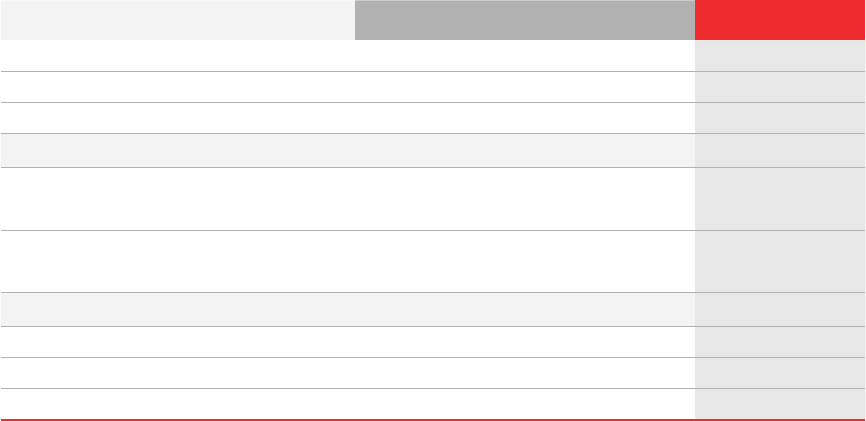
55
Annual Report of Yeti GermanCo 1 GmbH 2020
are transferred to the leased tanks. The agreements customary in liquefied products business typically have
a term of two to three years. Revenue from liquefied products is recognized on delivery to the tank. Income
from the rental of tanks is recognized according to the terms of the lease agreements in accordance with
IFRS 16.
c. Revenue from cylinder gases
Customers who need small amounts of gas (especially for most special gases) receive the products in
cylinders, which are typically owned by the Group and rented to customers. Cylinder gases are generally
sold by individual purchase orders or by contracts, with terms ranging between one and two years. Revenue
from gas sales is realized on delivery to the customer. Income from the rental of cylinders is recognized
according to the terms of the lease agreements in accordance with IFRS 16.
d. Construction contracts
Depending on the type of contractual arrangement, revenue from long-term construction contracts in the
Engineering division is recognized either at a point in time or over a period of time.
In accordance with IFRS 15, revenue from engineering projects is recognized over a period of time if they
satisfy the criteria of IFRS 15.35. In the Messer Industries Group, this typically only applies to air separation
units for specific customers. For other engineering projects that do not meet the criteria mentioned, revenue
is recognized when the project is completed in accordance with IFRS 15.
3. Consolidated Companies
The group of consolidated companies is unchanged as against the previous year and is as follows:
2020
Germany Foreign countries Total
Consolidated 9 28 37
Equity method – 4 4
Proportionately consolidated – 2 2
As of Jan. 1 9 34 43
Additions
of which acquisitions – – –
Disposals
of which disposals – – –
As of Dec. 31 9 34 43
Consolidated 9 28 37
Equity method − 4 4
Proportionately consolidated – 2 2

56
Annual Report of Yeti GermanCo 1 GmbH 2020
Revenue is mainly generated by the sale of liquefied products, cylinder gases and on-site and pipeline sales.
Revenue for fiscal 2020 breaks down among the individual sales channels as follows:
Notes to the Consolidated Income Statement
4. Revenue
Revenue for fiscal 2020 breaks down among the individual regions as follows:
Jan. 1 - Dec. 31, 2020 Jan. 1 - Dec. 31, 2019
From contracts with customers 1,730,889 88 % 1,491,719 88 %
From other revenue sources 234,603 12 % 195,889 12 %
Total 1,965,492 100 % 1,687,608 100 %
Jan. 1 - Dec. 31, 2020 Jan. 1 - Dec. 31, 2019
Liquefied gases 1,065,835 54 % 954,425 56 %
Cylinder gases 351,697 18 % 266,437 16 %
Pipeline / on site 184,873 9 % 154,982 9 %
Hardware / other 128,484 7 % 115,875 7 %
From contracts with customers 1,730,889 88 % 1,491,719 88 %
From other revenue sources 234,603 12 % 195,889 12 %
Total 1,965,492 100 % 1,687,608 100 %
Jan. 1 - Dec. 31, 2020 Jan. 1 - Dec. 31, 2019
North America 1,353,366 69 % 1,142,224 68 %
Western Europe 353,677 18 % 296,249 17 %
South America 258,449 13 % 249,135 15 %
Total 1,965,492 100 % 1,687,608 100 %
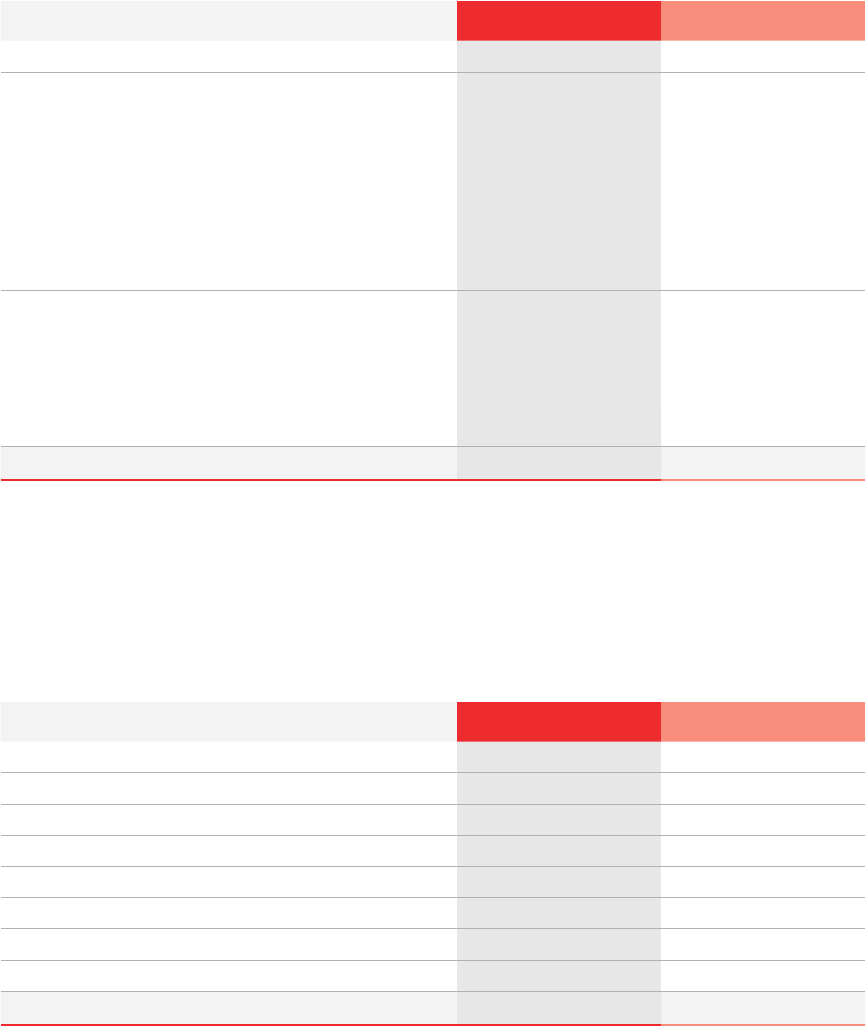
57
Annual Report of Yeti GermanCo 1 GmbH 2020
6. Selling and Distribution Expenses
Selling and distribution expenses include all expenses in connection with the sale and marketing of a
product. Selling and distribution expenses also include the costs of all sales departments and logistics
activities.
5. Cost of Sales
In addition to directly attributable costs, such as energy, personnel and material costs, the cost of sales
also includes overheads attributable to the production process, including depreciation on air separation
units.
Jan. 1 - Dec. 31, 2020 Jan. 1 - Dec. 31, 2019
Personnel expenses 212,680 194,707
Depreciation and amortization 163,994 146,463
Transportation costs 126,506 111,496
Maintenance 28,004 28,946
Warehousing costs 6,691 5,400
Insurance 2,958 2,282
Advertising 587 864
Other 47,194 52,446
Total 588,614 542,604
Jan. 1 - Dec. 31, 2020 Jan. 1 - Dec. 31, 2019
Goods purchased 32,441 28,893
Production costs
Energy 228,587 213,647
Depreciation and amortization 161,835 137,158
Personnel expenses 89,386 84,293
Maintenance 32,656 34,027
Taxes and other fees 18,320 16,231
Security and insurance 4,419 2,605
Others
Raw materials and supplies 390,289 339,671
Hardware 5,532 3,479
Services 1,207 629
Other 36,396 10,931
Total 1,001,068 871,564
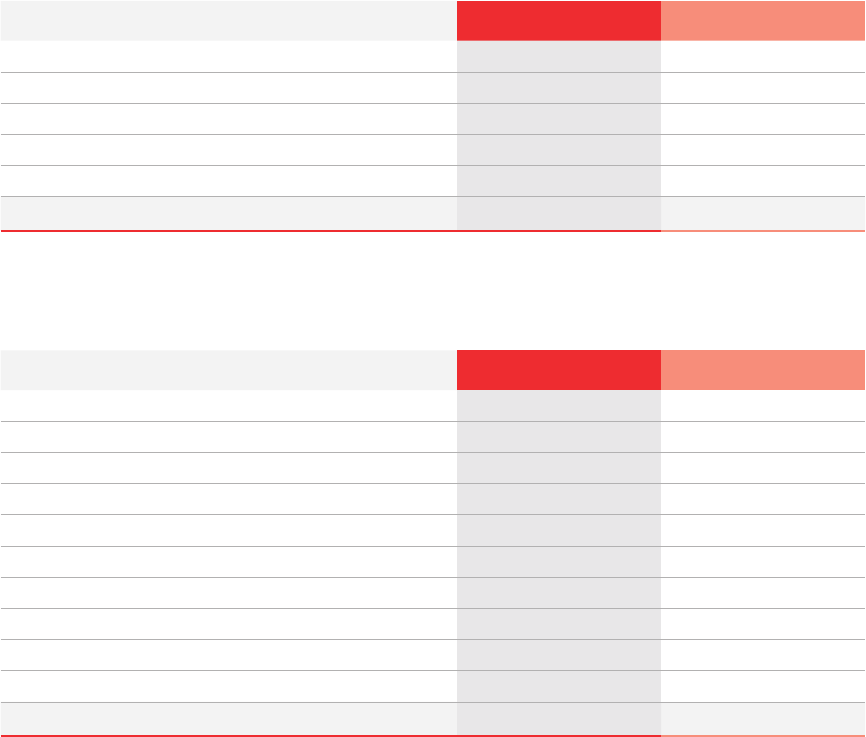
58
Annual Report of Yeti GermanCo 1 GmbH 2020
7. General and Administrative Expenses
General and administrative expenses include the personnel and non-personnel costs of management and
administrative areas to the extent not recharged to other functions as an internal service.
8. Other Operating Income
Jan. 1 - Dec. 31, 2020 Jan. 1 - Dec. 31, 2019
Personnel expenses 82,032 75,756
Depreciation and amortization 20,235 8,984
Insurance and audit services 10,042 7,918
IT services 6,405 6,201
Other 62,399 70,699
Total 181,113 169,558
Jan. 1 - Dec. 31, 2020 Jan. 1 - Dec. 31, 2019
Exchange rate gains from operating activities 7,743 9,558
Gains on the disposal of non-current assets 7,605 3,696
Other prior-period income 4,065 2,419
Change in the fair value of derivatives through profit or loss 795 –
Income from related parties 669 700
Insurance claims 491 38
Other reimbursements 353 36
Derecognition of liabilities – 1,322
Income from changes group reporting – 794
Miscellaneous 5,589 10,074
Total 27,310 28,637
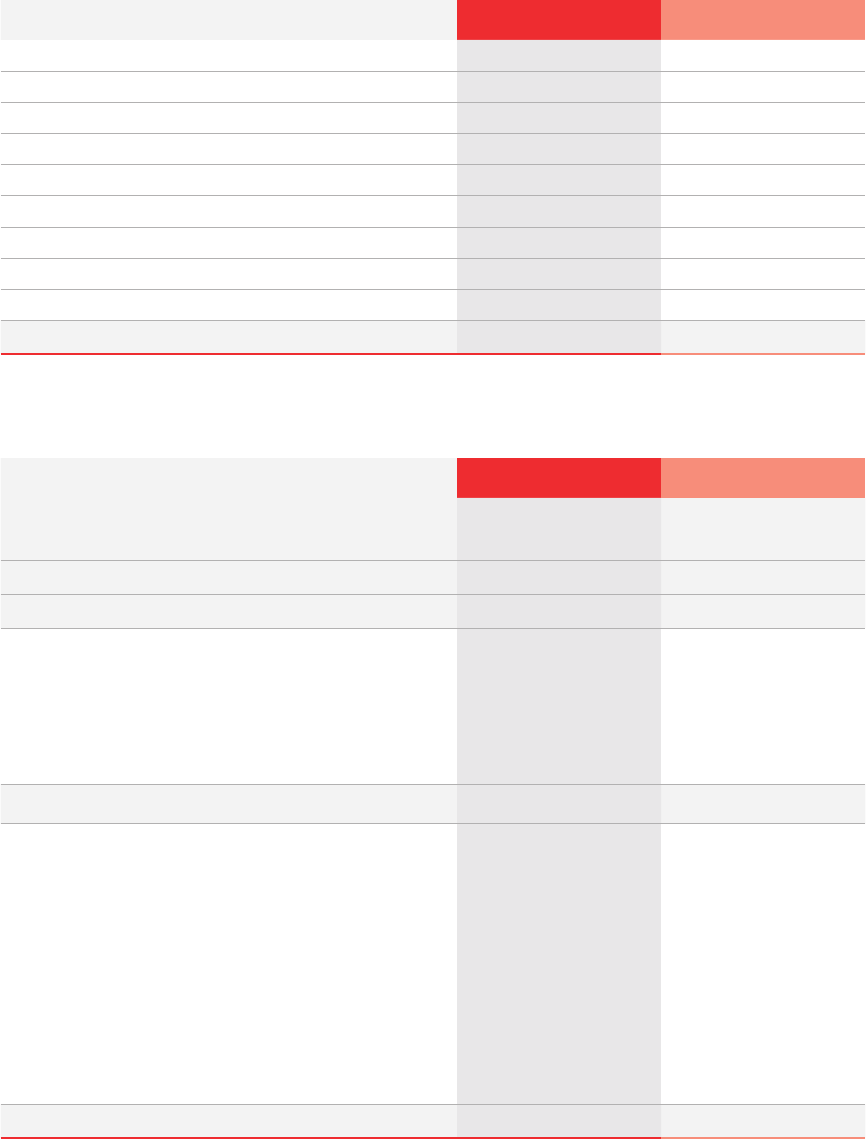
59
Annual Report of Yeti GermanCo 1 GmbH 2020
9. Other Operating Expenses
10. Financial result, net
Jan. 1 - Dec. 31, 2020 Jan. 1 - Dec. 31, 2019
Exchange rate losses from operating activities 7,527 3,320
Legal and consulting expenses 6,003 33,703
Other taxes 4,140 3,599
Related party expenses 2,778 1,935
Change in the fair value of derivatives through profit or loss 271 119
Losses on the disposal of non-current assets 253 857
Bank charges 90 77
Prior-period expenses – 598
Miscellaneous 3,102 4,070
Total 24,164 48,278
Jan. 1 - Dec. 31, 2020 Jan. 1 - Dec. 31, 2019
Income from investments accounted for using the equity
method
58 326
Other investment result, net (968) (668)
Finance income 11,369 31,699
Interest income from
Bank balances 473 4,975
Foreign currency gains 5,595 10,560
Gain or loss from the measurement of derivatives – 9,232
Other finance income 5,301 6,932
Finance costs (136,041) (115,333)
Interest expense from
Liabilities to banks (83,418) (92,469)
Leases (5,175) (4,615)
Expenses for the discounting of provisions (5,104) (3,125)
Capitalized borrowing costs 5,034 6,876
Foreign currency losses (12,385) (7,341)
Write-down on transaction costs (11,094) (5,091)
Gain or loss from the measurement of derivatives (169) −
Other finance costs (23,730) (9,568)
Total (125,582) (83,976)
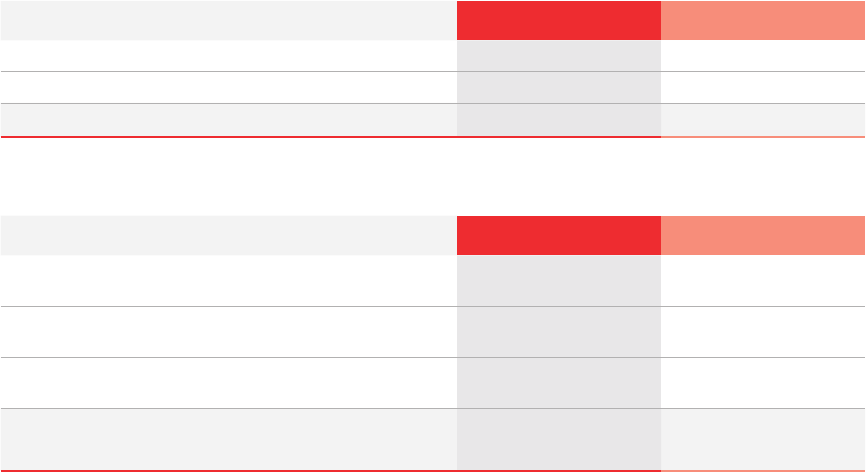
60
Annual Report of Yeti GermanCo 1 GmbH 2020
11. Tax Result
Deferred income taxes related to items charged or credited directly to other comprehensive income:
The following reconciliation summarizes the individual calculations of deferred taxes for specific companies
using the respective tax rates specific to their countries, taking consolidation adjustments into account. The
expected income tax is reconciled to the effective reported tax income. To calculate the expected income
tax, the income tax rate for the Group in fiscal 2020, based on the tax rate for the parent company of 30.00 %
(previous year: 30.00 %), is multiplied by the profit before tax.
For more information on interest expenses for our bank financing and derivatives, please refer to note
27 “Financial Liabilities” and note 32 “Other Financial Instrument Disclosures”.
Jan. 1 - Dec. 31, 2020 Jan. 1 - Dec. 31, 2019
Current income taxes (8,607) (35,359)
Deferred income taxes (8,332) 42,329
Total (16,939) 6,970
Dec. 31, 2020 Dec. 31, 2019
Deferred taxes related to gains or losses from the
remeasurement of hedges
2,212 2,781
Deferred income taxes on net investments in foreign
operations
(2,721) (1,683)
Deferred taxes related to the remeasurement of net
defined benefit obligations
2,743 2,138
Deferred tax assets / (liabilities) recognized in
other comprehensive income
2,234 3,236
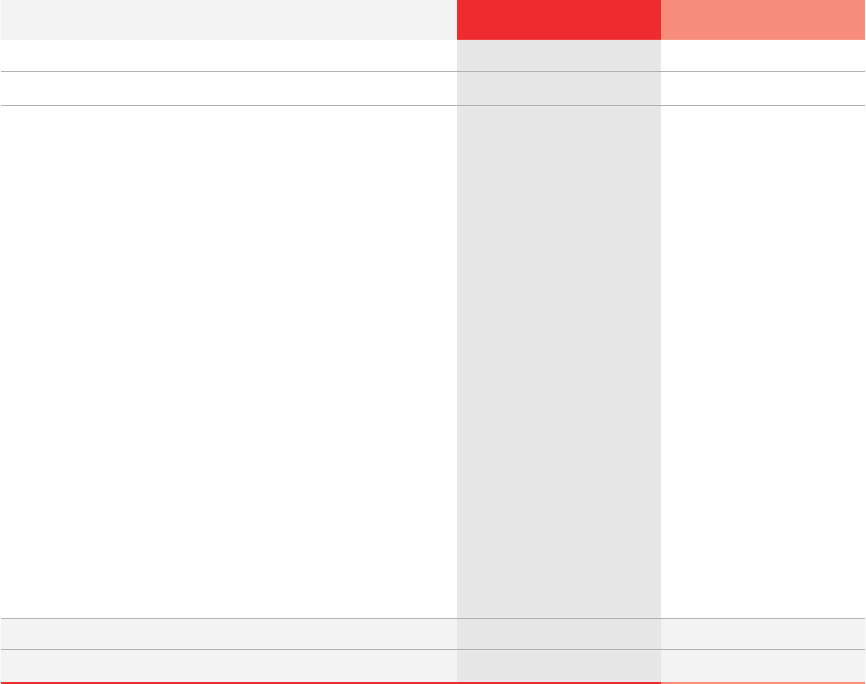
61
Annual Report of Yeti GermanCo 1 GmbH 2020
As of December 31, 2020, within the Messer Industries Group there were tax loss carryforwards of
K€ 430,598 (previous year: K€ 262,758) and credit for offsetting in the form of interest carryforwards of
K€ 8,809 (previous year: K€ 0).
For Group companies that had losses in the current or the previous period, a deferred tax asset of K€ 26
(previous year: K€ 74) was capitalized, the realization of which is dependent on future taxable profits that are
higher than the effects of the reversal of existing taxable temporary differences. The recognition of deferred
tax assets is justified in that their realization is likely on the basis of planning for tax purposes.
Deferred taxes were not recognized for tax loss carryforwards of K€ 201,270 (previous year: K€ 198,553),
interest carryforwards of K€ 8,809 (previous year: K€ 0) or temporary differences of K€ 3,476 (previous year:
K€ 2,888), as it is assumed – on the basis of planning for tax purposes – that it will not be possible to utilize
the tax loss carryforwards or temporary differences. The temporary differences of K€ 3,476 and the interest
carryforwards of K€ 8,809 are considered vested.
Jan. 1 - Dec. 31, 2020 Jan. 1 - Dec. 31, 2019
Tax rate 30.00 % 30.00 %
Profit before tax 69,400 (3,761)
Expected income tax / (charge) (20,820) 1,128
Impairment of goodwill – –
Impairment loss / non-recognition of deferred taxes on
temporary differences
14,462 824
Impairment loss / non-recognition of deferred taxes on
loss carryforwards
2,734 20,224
Effect of tax credits 143 148
Non-deductible interest expenses – –
Non-deductible withholding tax / other taxes (8,125) (5,381)
Effect of changes in tax rates 1,727 (231)
Associates accounted for using the equity method (1) 677
Tax-exempt investment income / tax-exempt gains on
the disposal of subsidiaries
– –
Tax (expense) / income for previous years (5,529) (1,706)
Non-deductible expenses for tax purposes / tax-free income (9,213) (9,358)
Tax rate differences at Group companies 7,276 551
Others 407 94
Effective tax income / (expense) from operating activities (16,939) 6,970
Effective tax rate 24.41 % 185.32 %

62
Annual Report of Yeti GermanCo 1 GmbH 2020
The loss carryforwards of the Messer Industries Group without deferred tax assets will expire as follows:
In accordance with IAS 12.39, deferred taxes on the difference between the pro rata equity of a subsidiary
recognized in the consolidated statement of financial position and the carrying amount of the investment in
that subsidiary must be included in the parent company’s tax accounts (outside basis differences) if they are
expected to be realized. These differences essentially relate to the retained earnings of German and foreign
subsidiaries. Deferred taxes are not recognized for these retained earnings as they are re-invested indefinitely
or are not subject to corresponding taxation. Distributions by subsidiaries would be subject to dividend
taxation. Distributions from abroad could also trigger withholding tax. As of December 31, 2020, deferred
tax liabilities for outside basis differences were not taken into account for planned dividend payments as
their realization is not planned.
Expiring within
Dec. 31, 2020
1 year 1,461
2 years 11 6
3 years 1,637
After 3 years 157,092
Indefinite 40,964
Total 201,270
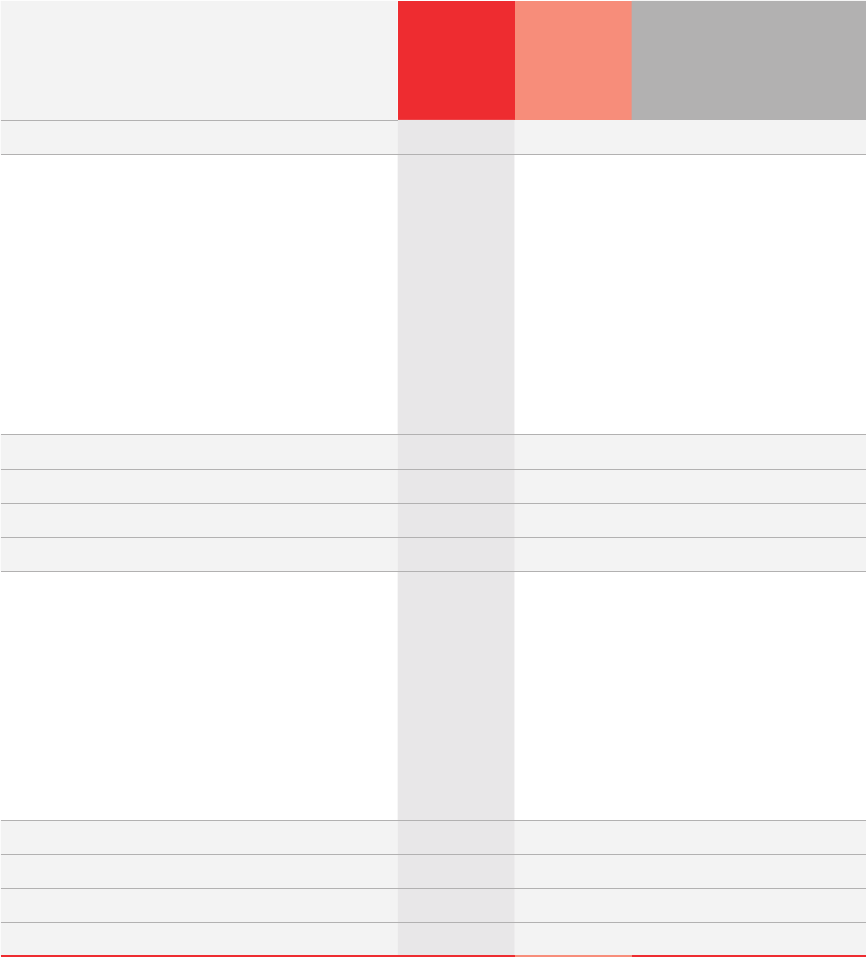
63
Annual Report of Yeti GermanCo 1 GmbH 2020
Deferred taxes are attributable to the following statement of financial position items as of December 31,
2020:
Dec. 31, 2020 Dec. 31, 2019
Recognized
in profit or
loss and other
changes outside
profit or loss*
Recognized
in other
comprehen-
sive income
Deferred tax assets
Tax loss carryforwards and tax credits 57,619 20,917 36,702 –
Intangible assets and property, plant and equipment 17,148 200 16,948 –
Inventories 861 619 242 –
Trade receivables 6,455 5,107 1,348 –
Other current receivables and other assets 346 628 (282) –
Provisions for employee benefits 19,710 17,297 1,808 605
Other long-term provisions 15,413 9,694 5,719 –
Other current liabilities 21,782 30,993 (9,211) –
Miscellaneous 23,102 23,679 1,030 (1,607)
Total 162,436 109,134 54,304 (1,002)
Offsetting (145,527) (102,811)
Deferred tax assets, net 16,909 6,323
Deferred tax liabilities
Intangible assets (175,541) (279,461) 103,920 –
Property, plant and equipment (383,016) (331,678) (51,338) –
Other non-current receivables and assets (193) (376) 183 –
Inventories (19,536) (14,282) (5,254) –
Other current receivables and assets (1,401) – (1,401) –
Non-current and current financial liabilities (26) (588) 562 –
Other short-term provisions (3,016) (3,200) 184 –
Miscellaneous (28,817) (2,731) (26,086) –
Total (611,546) (632,316) 20,770 –
Offsetting 145,527 102,811
Deferred tax liabilities, net (466,019) (529,505)
Total deferred taxes, net (449,110) (523,182) 75,074 (1,002)
*
of which exchange rate changes recognized in other comprehensive income: K€ 83,406
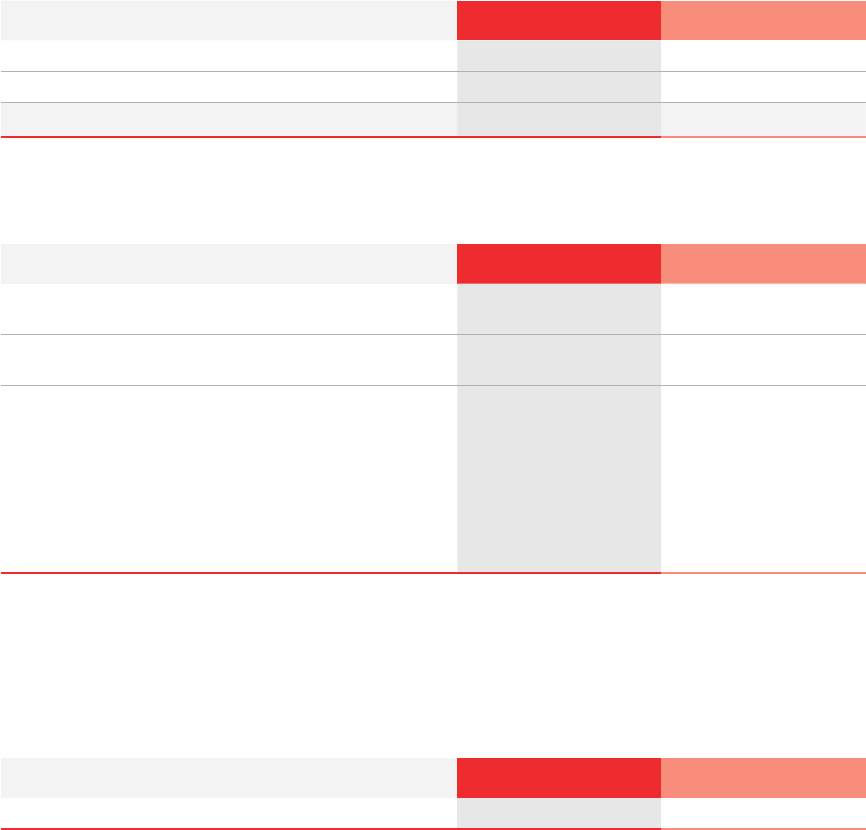
64
Annual Report of Yeti GermanCo 1 GmbH 2020
Deferred tax assets and liabilities in the statement of financial position and deferred taxes in the income
statement are reconciled as follows:
Deferred tax assets and liabilities, after offsetting at the individual companies, break down as follows:
12. Personnel expenses
Personnel expenses consist of wages and salaries, social security contributions and other employee benefits
(e.g. pensions).
The above amount includes wages and salaries of K€ 299,247 (previous year: K€ 266,035), social security
expenses of K€ 74,207 (previous year: K€ 74,980) and other personnel expenses of K€ 11,686 (previous year:
K€ 14,190). Personnel expenses also comprise expenses for defined contribution plans of K€ 3,683 (previous
year: K€ 3,032) and for defined benefit plans of K€ 1,227 (previous year: K€ 935).
Deferred taxes
Dec. 31, 2020 Dec. 31, 2019
Deferred tax assets 16,909 6,323
Deferred tax liabilities (466,019) (529,505)
Total deferred taxes, net (449,110) (523,182)
Jan. 1 - Dec. 31, 2020 Jan. 1 - Dec. 31, 2019
Change in deferred tax assets in the statement of financial
position
10,586 6,323
Change in deferred tax liabilities in the statement of financial
position
63,486 (529,505)
Difference 74,072 (523,182)
Of which:
Through profit and loss (8,332) 42,329
Change in group reporting – (569,792)
Offset against other comprehensive income (1,002) 3,236
Exchange rate changes 83,406 1,045
Jan. 1 - Dec. 31, 2020 Jan. 1 - Dec. 31, 2019
Personnel expenses 390,050 359,172
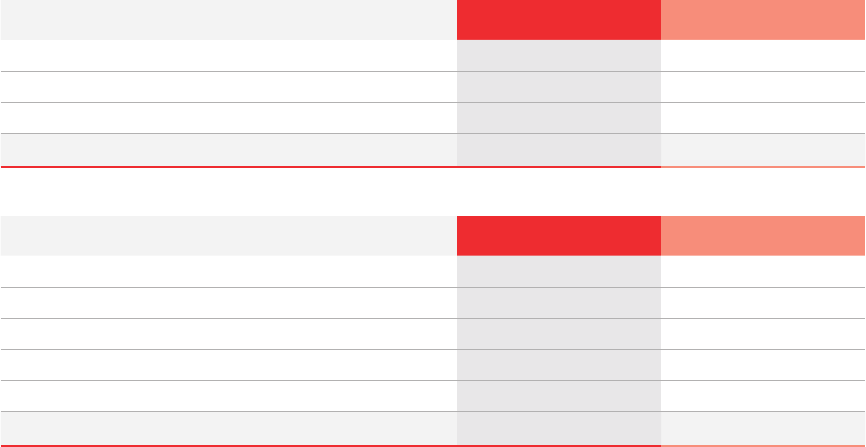
65
Annual Report of Yeti GermanCo 1 GmbH 2020
13. Number of Employees (annual average)
The average number of employees breaks down as follows:
By function
Jan. 1 - Dec. 31, 2020 Jan. 1 - Dec. 31, 2019
Production and filling 2,581 2,630
Logistics 1,463 1,509
Sales and marketing 974 949
Administration 600 632
Engineering 147 128
Total number of employees 5,765 5,848
By region
Jan. 1 - Dec. 31, 2020 Jan. 1 - Dec. 31, 2019
North America 2,754 2,838
South America 2,209 2,208
Western Europe 802 802
Total number of employees 5,765 5,848
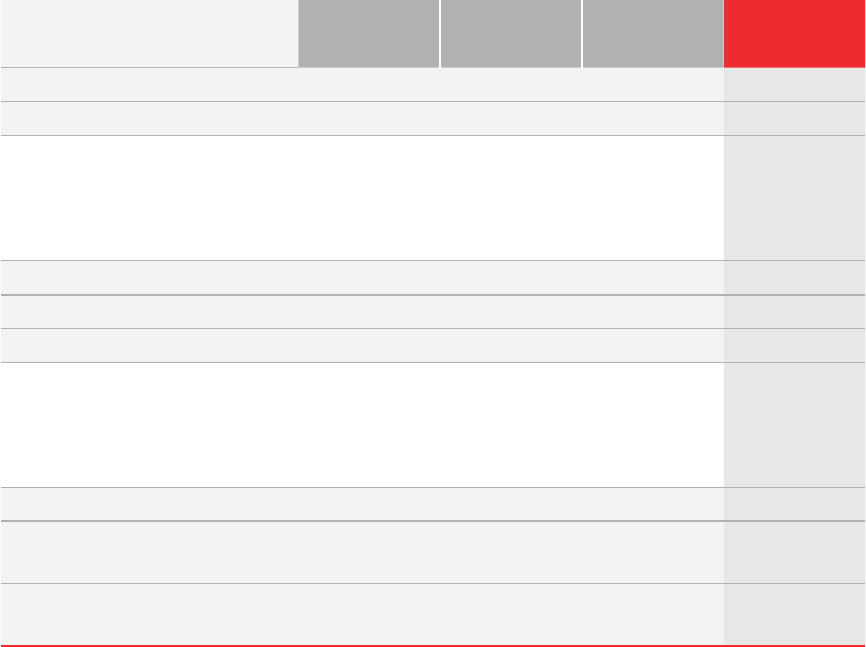
66
Annual Report of Yeti GermanCo 1 GmbH 2020
Notes to the Consolidated Statement of Financial Position
14. Intangible Assets
2020
Goodwill
Right-of-use
assets
Other intangible
assets
Total
Cost
As of Jan. 1, 2020 655,901 97,835 1,231,097 1,984,833
Additions – 25,008 123 25,131
Reclassification – – 11,277 11,277
Disposals – (7,061) (102) (7,163)
Exchange rate changes (89,472) (7,853) (94,727) (192,052)
As of Dec. 31, 2020 566,429 107,929 1,147,668 1,822,026
Cumulative amortization
As of Jan. 1, 2020 – (13,653) (68,765) (82,418)
Additions – (19,504) (81,521) (101,025)
Reclassification – – – –
Disposals – 2,261 11 2,272
Exchange rate changes – 1,781 8,255 10,036
As of Dec. 31, 2020 – (29,115) (142,020) (171,135)
Net carrying amounts as
of Jan. 1, 2020
655,901 84,182 1,162,332 1,902,415
Net carrying amounts as
of Dec. 31, 2020
566,429 78,814 1,005,648 1,650,891
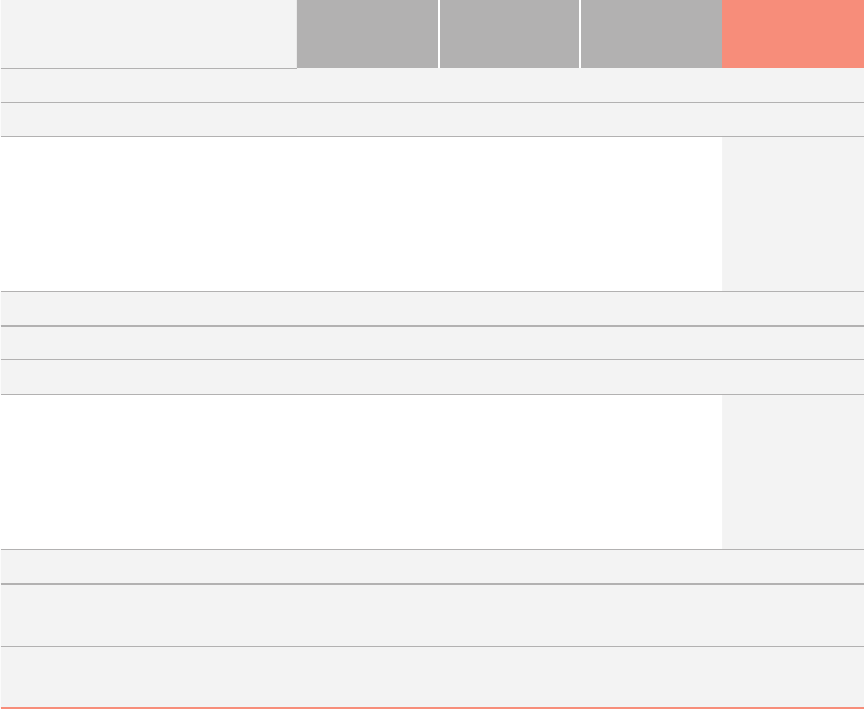
67
Annual Report of Yeti GermanCo 1 GmbH 2020
The changes in group reporting in 2019 include the addition of the assets of the companies acquired from
Linde in the US, Canada, Brazil and Colombia, the Western European companies contributed and the
company acquired from Praxair in Chile.
Goodwill
Goodwill is tested for impairment as of December 31 each year. In accordance with IAS 36, goodwill is
allocated to the smallest cash-generating unit for which goodwill is monitored and tested for impairment at
this level by comparing discounted expected future cash flows against the carrying amount of that cash-
generating unit. The smallest identifiable group of assets that generate cash inflows from continued use that
are largely independent of the cash inflows of other assets or other groups of assets (cash-generating unit)
were identified by the companies of the Messer Industries Group operating in the individual countries. If
individual production and distribution companies within a country complement each other economically,
they are combined into groups of cash-generating units for the purposes of goodwill monitoring. Accordingly,
for Belgium, Brazil, Germany, Colombia (also combined with the business activities in Chile), the Netherlands,
Spain and the US, various companies were combined in conjunction with impairment testing.
2019
Goodwill
Right-of-use
assets
Other intangible
assets
Total
Cost
As of Jan. 1, 2019 1 – – 1
Additions – 7,385 326 7,711
Change in group reporting 655,430 91,119 1,233,790 1,980,339
Reclassification – – 1,234 1,234
Disposals – (754) (2,859) (3,613)
Exchange rate changes 470 85 (1,394) (839)
As of Dec. 31, 2019 655,901 97,835 1,231,097 1,984,833
Cumulative amortization
As of Jan. 1, 2019 – – – –
Additions – (13,977) (68,819) (82,796)
Change in group reporting – (62) – (62)
Reclassification – – – –
Disposals – 396 – 396
Exchange rate changes – (10) 54 44
As of Dec. 31, 2019 – (13,653) (68,765) (82,418)
Net carrying amounts as
of Jan. 1, 2019
1 – – 1
Net carrying amounts as
of Dec. 31, 2019
655,901 84,182 1,162,332 1,902,415
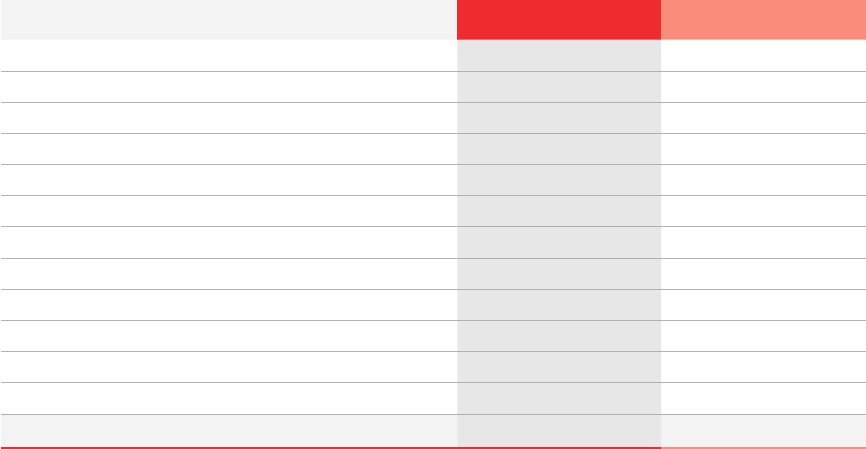
68
Annual Report of Yeti GermanCo 1 GmbH 2020
The following table shows the breakdown of goodwill as of December 31, 2020:
The recoverable amount for an individual operating company is based on calculations of its respective value
in use. The value in use is the present value of the estimated future cash flows expected from the continuing
operations of each company. The cash flow forecast is based on the most recent financial plans of the
respective cash-generating unit that have been approved by management. Starting with the analysis of past
results, values in use were calculated on the basis of detailed forecasts of long-term cash flows through
2024. Cash flows for periods after the detailed planning period were based on the final fiscal year of the
detailed planning period (using the terminal value model). Forecast cash flows were discounted to their
present value at the measurement date using an appropriate capitalization rate specific to that country. The
capitalization rate is calculated using the capital asset pricing model (CAPM) after first being broken down
into the components of basic interest rate, risk premium and growth discount. The risk-free basic interest
rate was derived from yields on long-term government bonds taking into account the respective country
rating (Moody’s). The risk premium was obtained by multiplying the market risk premium by the beta factor
that reflects the relative risk of a given stock compared to the market as a whole. The market risk premium
was calculated for each country using the Damodaran model, taking into account the respective country
rating (Moody’s). The beta factor was calculated on the basis of an analysis of a peer group of listed compa-
nies for the Messer Industries Group.
Dec. 31, 2020 Dec. 31, 2019
Cash-generating unit USA 365,290 424,443
Cash-generating unit Canada 69,640 74,578
Cash-generating unit Germany 33,086 33,086
Cash-generating unit France 23,043 23,043
Cash-generating unit Colombia 18,882 21,505
Cash-generating unit Switzerland 17,512 17,429
Cash-generating unit Spain 13,879 13,879
Cash-generating unit Belgium 9,623 9,623
Cash-generating unit Brazil 8,629 31,046
Cash-generating unit Netherlands 3,649 3,649
Cash-generating unit Algeria 1,979 2,403
Cash-generating unit Portugal 1,217 1,217
566,429 655,901
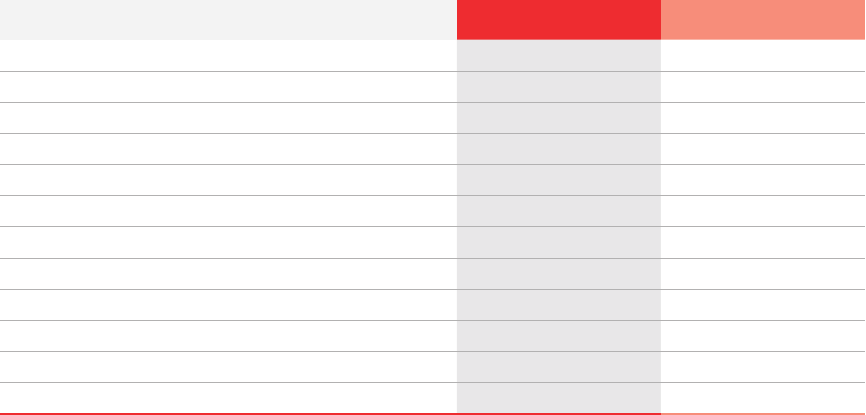
69
Annual Report of Yeti GermanCo 1 GmbH 2020
The capitalization rates for the specific countries are as follows:
The detailed forecasts up to 2024 used to calculate the values in use of the cash-generating units are based,
among other things, on the assumptions for revenue growth, the development of the EBITDA margin and
the long-term growth rate after the detailed planning period.
Dec. 31, 2020 Dec. 31, 2019
Brazil 9.79 % 10.90 %
Algeria 8.71 % 8.64 %
Portugal 8.33 % 8.27 %
Colombia 8.23 % 10.20 %
Spain 7.48 % 7.44 %
Belgium 6.11 % 6.10 %
France 5.96 % 5.95 %
Canada 5.55 % 6.30 %
USA 5.54 % 6.35 %
Switzerland 5.31 % 5.33 %
Netherlands 5.29 % 5.31 %
Germany 5.28 % 5.29 %
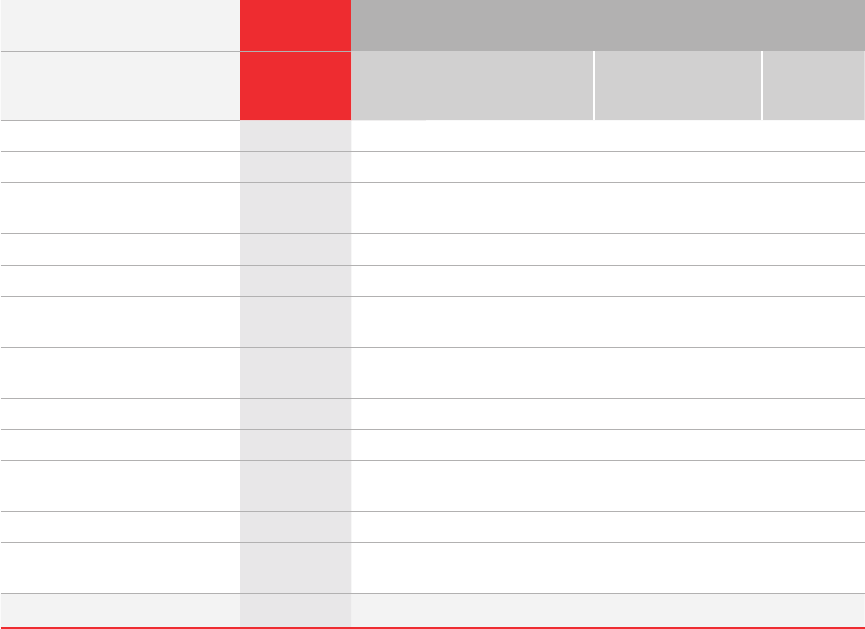
70
Annual Report of Yeti GermanCo 1 GmbH 2020
The weighted average growth rate for extrapolating cash flows beyond the planning period is 1.0 % for all
Western European units (previous year: 0.5 %). The average growth rate for the American units its between
1.25 % and 3.0 % (previous year: 1.5 %).
The following three scenarios were simulated in conjunction with a sensitivity analysis:
(a) Increase in the capitalization rates for each country by 1 percentage point.
(b) Long-term growth rate after the detailed planning period reduced by 0.5 %.
(c) Planned EBIT of the cash-generating units consistently falls short of forecasts by 10 % throughout the
entire planning period and thereafter from fiscal 2024 onwards.
In these scenarios, there are no goodwill impairment requirements for any companies except Spain. Under
the significant planning assumptions set out above, the recoverable amount for Spain is approximately equal
to the carrying amount. Thus, any negative change in the significant planning assumptions leads to impair-
ment. The impairment loss is allocated to the carrying amounts of the assets of the cash-generating unit in
the following order:
The carrying amount of all goodwill allocated to the cash-generating unit is reduced first. Secondly, the
carrying amount of the other assets of the cash-generating unit is reduced in line with their share of the
total carrying amount.
These assumptions for the cash-generating units are as follows:
Company
Carrying
amount
Significant planning assumptions
Dec. 31, 2020
Revenue growth
(CAGR)
Trend in EBITDA
margin*
Growth
rate**
Cash-generating unit USA 365,290 65 % Slight increase Slight increase 1.75 %
Cash-generating unit Canada 69,640 12 % Slight increase Slight increase 1.25 %
Cash-generating unit Germany 33,086 6 %
Significant
increase
Significant
increase
1.0 %
Cash-generating unit France 23,043 4 % Moderate increase Moderate increase 1.0 %
Cash-generating unit Colombia 18,882 3 % Moderate increase Moderate increase 3.0 %
Cash-generating unit
Switzerland
17,512 3 % Moderate increase
Moderate
decrease
1.0 %
Cash-generating unit Spain 13,879 2 % Moderate increase
Significant
increase
1.0 %
Cash-generating unit Belgium 9,623 2 % Slight increase Slight increase 1.0 %
Cash-generating unit Brazil 8,629 2 % Moderate increase Moderate increase 3.0 %
Cash-generating unit
Netherlands
3,649 1 % Slight increase Stable 1.0 %
Cash-generating unit Algeria 1,979 0 % Slight increase Slight decrease 1.0 %
Cash-generating unit Portugal 1,217 0 %
Significant
increase
Significant
increase
1.0 %
Messer Industries Group 566,429 100 %
* End of the detailed planning period compared to the current fiscal year
** Growth after the detailed planning period

71
Annual Report of Yeti GermanCo 1 GmbH 2020
The above scenarios would lead to the following impairment losses:
Company
Carrying
amount
Sensitivity scenarios
Dec. 31, 2020
Capitalization rate
+1 percentage point
Growth rate
-0.5 %
EBIT
-10 % on forecast*
Cash-generating unit Spain 13,879 21,459 9,779 6,903
* Throughout the forecast period
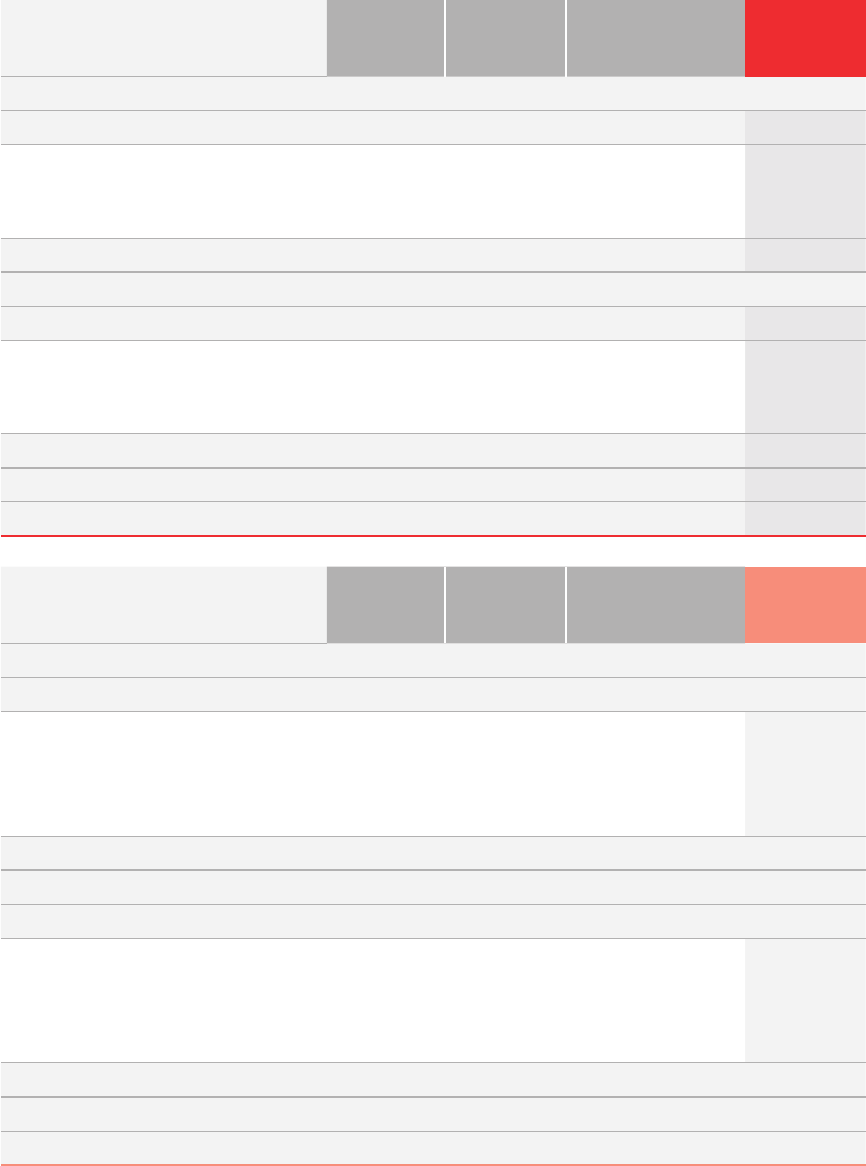
72
Annual Report of Yeti GermanCo 1 GmbH 2020
Right-of-use assets
Right-of-use assets relate to assets capitalized in conjunction with leases in accordance with IFRS 16.
These consist of the following:
2020
Land and
buildings
Plant and
machinery
Other operating and
office equipment
Total
Cost
As of Jan. 1, 2020 69,492 27,928 415 97,835
Additions 3,467 21,466 75 25,008
Disposals (3,695) (3,335) (31) (7,061)
Exchange rate changes (5,288) (2,536) (29) (7,853)
As of Dec. 31, 2020 63,976 43,523 430 107,929
Cumulative amortization
As of Jan. 1, 2020 (7,034) (6,473) (146) (13,653)
Additions (10,292) (9,050) (162) (19,504)
Disposals 698 1,554 9 2,261
Exchange rate changes 1,078 692 11 1,781
As of Dec. 31, 2020 (15,550) (13,277) (288) (29,115)
Net carrying amounts as of Jan. 1, 2020 62,458 21,455 269 84,182
Net carrying amounts as of Dec. 31, 2020 48,426 30,246 142 78,814
2019
Land and
buildings
Plant and
machinery
Other operating and
office equipment
Total
Cost
As of Jan. 1, 2019 – – – –
Additions 1,732 5,628 25 7,385
Change in group reporting 67,678 23,058 383 91,119
Disposals (36) (718) — (754)
Exchange rate changes 118 (40) 7 85
As of Dec. 31, 2019 69,492 27,928 415 97,835
Cumulative amortization
As of Jan. 1, 2019 – – – –
Additions (7,029) (6,806) (142) (13,977)
Change in group reporting (19) (40) (3) (62)
Disposals 36 361 (1) 396
Exchange rate changes (22) 12 – (10)
As of Dec. 31, 2019 (7,034) (6,473) (146) (13,653)
Net carrying amounts as of Jan. 1, 2019 – – – –
Net carrying amounts as of Dec. 31, 2019 62,458 21,455 269 84,182

73
Annual Report of Yeti GermanCo 1 GmbH 2020
Interest expenses of K€ 5,175 (previous year: K€ 4,615) were recognized in connection with leases. Further-
more, the following expenses were recognized that were not taken into account in the measurement of
right-of-use assets and the corresponding liability:
In total, leases resulted in cash outflows of K€ 21,917 (previous year: K€ 22,206) in the year under
review.
For the operating companies Messer LLC and Messer North America Inc., USA, the value in use calculated
in accordance with the principles described for two leases was less than the net assets of the cash-genera-
ting units. At K€ 4,221, the recoverable amount calculated based on the principles described is less than the
carrying amount of K€ 6,409. The deficit between the value in use and the carrying amount of K€ 2,188 was
distributed as an impairment loss on the right-of-use assets of the cash-generating unit on the basis of their
carrying amounts. The impairment loss is reported under “General and administrative expenses” in the
income statement.
Other intangible assets
Other intangible assets essentially consist of customer bases, technologies / patents and licenses, the net
carrying amounts of which were K€ 673,068 (previous year: K€ 775,389), K€ 139,046 (previous year:
K€ 156,543) and K€ 115,592 (previous year: K€ 130,011) as of December 31, 2020, and other intangible assets.
The customer bases result from purchase price allocation performed as of March 1, 2019 and will be amortized
on a straight-line basis over a period of up to 46 years after December 31, 2020. The useful life of the
customer bases is not more than 47.5 years and is higher than the original maximum contract term of 15
years as the respective renewal options are highly likely to be exercised by customers. The amortization
expense for the fiscal year is recognized in selling and distribution expenses.
“Technologies” mainly includes patents in the segments of software, oil and gas, energy, food and healthcare,
which were acquired from the Linde Group. As of December 31, 2020, the net carrying amounts of the
patents are K€ 120,751 (previous year: K€ 133,576) in the US, K€ 8,025 (previous year: K€ 9,835) in Colombia,
K€ 6,720 (previous year: K€ 7,742) in Canada and K€ 3,550 (previous year: K€ 5,390) in Brazil.
The licenses include the rights to the brands ‚Messer – Gases for Life‘ K€ 113,892, previous year: K€ 127,838)
and ‚REMEO‘ (K€ 1,700, previous year: K€ 2,173) and are amortized over their useful life of ten years.
2020 2019
Expenses for leases for low-value assets – 596
Expenses for short-term leases 2,487 6,363
Expenses for variable lease payments – –
2,487 6,959
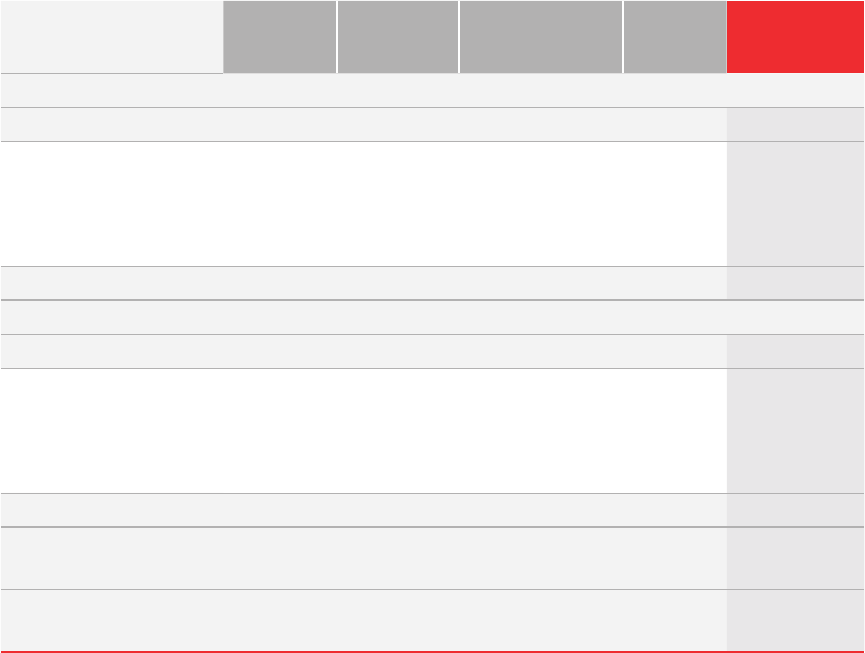
74
Annual Report of Yeti GermanCo 1 GmbH 2020
15. Property, Plant and Equipment
2020
Land and
buildings
Plant and
machinery
Other operating and
office equipment
Construction
in progress
Total
Cost
As of Jan. 1, 2020 207,781 1,743,298 191,871 284,706 2,427,656
Additions 300 24,042 1,262 224,175 249,779
Reclassification 1,377 290,912 58,405 (361,971) (11,277)
Disposals (2,571) (9,939) (1,926) (730) (15,166)
Exchange rate changes (17,734) (163,742) (21,244) (15,335) (218,055)
As of Dec. 31, 2020 189,153 1,884,571 228,368 130,845 2,432,937
Cumulative amortization
As of Jan. 1, 2020 (5,889) (164,667) (33,737) – (204,293)
Additions (7,502) (198,558) (39,127) – (245,187)
Reclassification 4 (83) 79 – —
Disposals 120 5,897 1,147 – 7,164
Exchange rate changes 410 21,786 5,019 – 27,215
As of Dec. 31, 2020 (12,857) (335,625) (66,619) – (415,101)
Net carrying amounts as
of Jan. 1, 2020
201,892 1,578,631 158,134 284,706 2,223,363
Net carrying amounts as
of Dec. 31, 2020
176,296 1,548,946 161,749 130,845 2,017,836
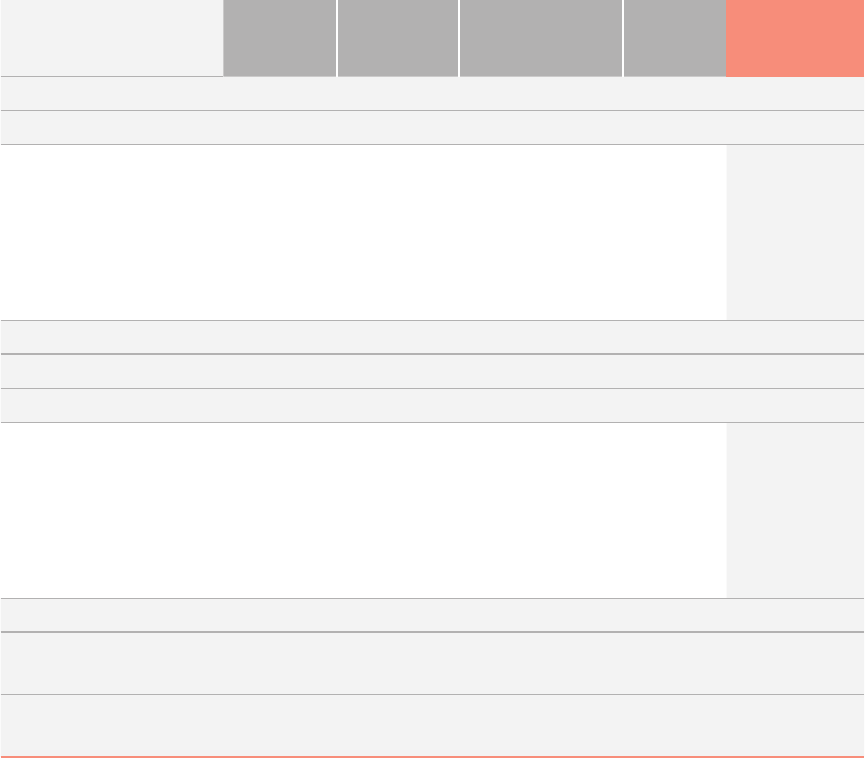
75
Annual Report of Yeti GermanCo 1 GmbH 2020
The changes in group reporting in 2019 include the addition of the assets of the companies acquired from
Linde in the US, Canada, Brazil and Colombia, the Western European companies contributed and the
company acquired from Praxair in Chile.
Borrowing costs of K€ 5,034 (previous year: K€ 6,876) were capitalized for qualifying assets in the fiscal year.
The average interest rate was 3.2 % (previous year: 3.2 %).
Additions to plant and machinery include a net amount of K€ 3,588 that was capitalized in accordance with
IFRIC 1 on the basis of measurement changes in restoration obligations.
In addition, property, plant and equipment includes technical equipment, including tanks and gas cylinders,
from operating leases in which the Messer Industries Group acts is the lessor.
2019
Land and
buildings
Plant and
machinery
Other operating and
office equipment
Construction
in progress
Total
Cost
As of Jan. 1, 2019 – – – – –
Additions 950 20,674 3,401 223,976 249,001
Change in
group reporting
207,038 1,618,943 178,887 194,953 2,199,821
Reclassification 3,414 115,588 13,630 (133,866) (1,234)
Disposals (3,316) (9,049) (3,908) (216) (16,489)
Exchange rate changes (305) (2,858) (139) (141) (3,443)
As of Dec. 31, 2019 207,781 1,743,298 191,871 284,706 2,427,656
Cumulative amortization
As of Jan. 1, 2019 – – – – –
Additions (6,532) (168,295) (34,981) – (209,808)
Change in
group reporting
– 11 5 – 16
Reclassification (2) (10) 12 – –
Disposals 641 3,427 1,237 – 5,305
Exchange rate changes 4 200 (10) – 194
As of Dec. 31, 2019 (5,889) (164,667) (33,737) — (204,293)
Net carrying amounts as
of Jan. 1, 2019
– – – – –
Net carrying amounts as
of Dec. 31, 2019
201,892 1,578,631 158,134 284,706 2,223,363
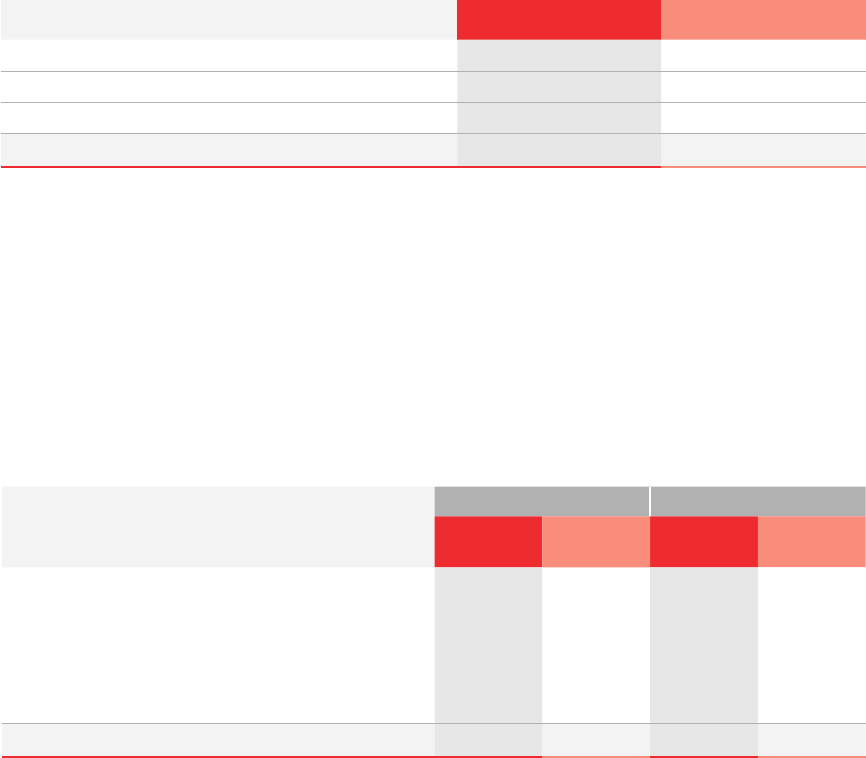
76
Annual Report of Yeti GermanCo 1 GmbH 2020
Income of K€ 8,383 (previous year: K€ 7,001) from variable lease payments under operating leases was
recognized in the reporting period.
16. Interests in Other Entities
Investments accounted for using the equity method
The following interests in associates were recognized on the basis of the interest in the equity of the relevant
entity as of December 31, 2020:
The minimum lease payments to be received from customers from such operating leases in the future break
down as follows:
Dec. 31, 2020 Dec. 31, 2019
Due within 1 year 2,850 2,605
Due between 1 and 5 years 4,036 4,518
Due after more than 5 years 101 168
6,987 7,291
Name and registered office of the entity
Shareholding in percent Carrying amount
Dec. 31,
2020
Dec. 31,
2019
Dec. 31,
2020
Dec. 31,
2019
Non-significant companies
Limes S.A.S., Saint-Herblain 50 % 50 % 3,723 3,725
Cliffside Helium LLC, Delaware 26 % 26 % 47 47
Cliffside Refiners LP, Delaware 26 % 26 % 1,392 1,605
GreenCO2, Zwijndrecht 35 % 35 % 518 517
5,680 5,894
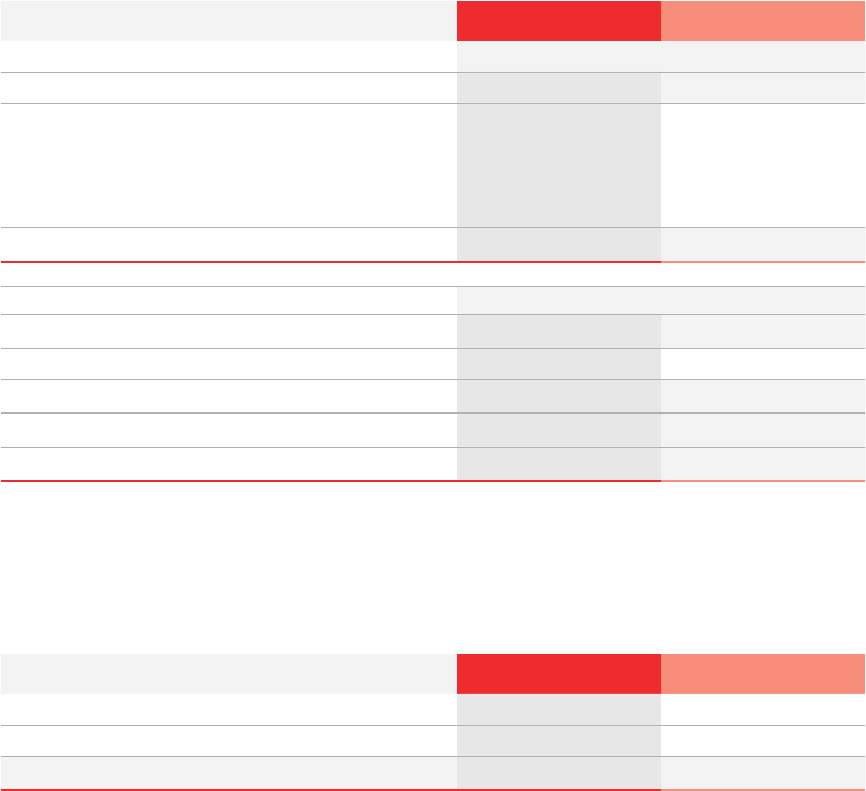
77
Annual Report of Yeti GermanCo 1 GmbH 2020
Interests in associates developed as follows:
The following table shows the summarized financial data of the individually immaterial associates: Limes
S.A.S., France, is a 50 % investment of Messer France S.A.S., France. BECO
2
B.V.B.A., Belgium, has a 50 %
interest in GreenCO
2
, Belgium. Messer LLC, USA, holds 26 % in Cliffside Refiners LP, USA, and 26 % in
Cliffside Helium LLC, USA.
2020 2019
Cost
As of Jan. 1 5,894 –
Group’s share of results / additions 228 100
Change in group reporting – 5,704
Dividend / disposals (306) –
Exchange rate changes (136) 90
As of Dec. 31 5,680 5,894
Cumulative amortization
As of Jan. 1 – –
Additions – –
As of Dec. 31 – –
Net carrying amount as of Jan. 1 5,894 —
Net carrying amount as of Dec. 31 5,680 5,894
Jan. 1 - Dec. 31, 2020 Jan. 1 - Dec. 31, 2019
Net profit for the year 876 401
Other comprehensive income (232) –
Total comprehensive income 644 401
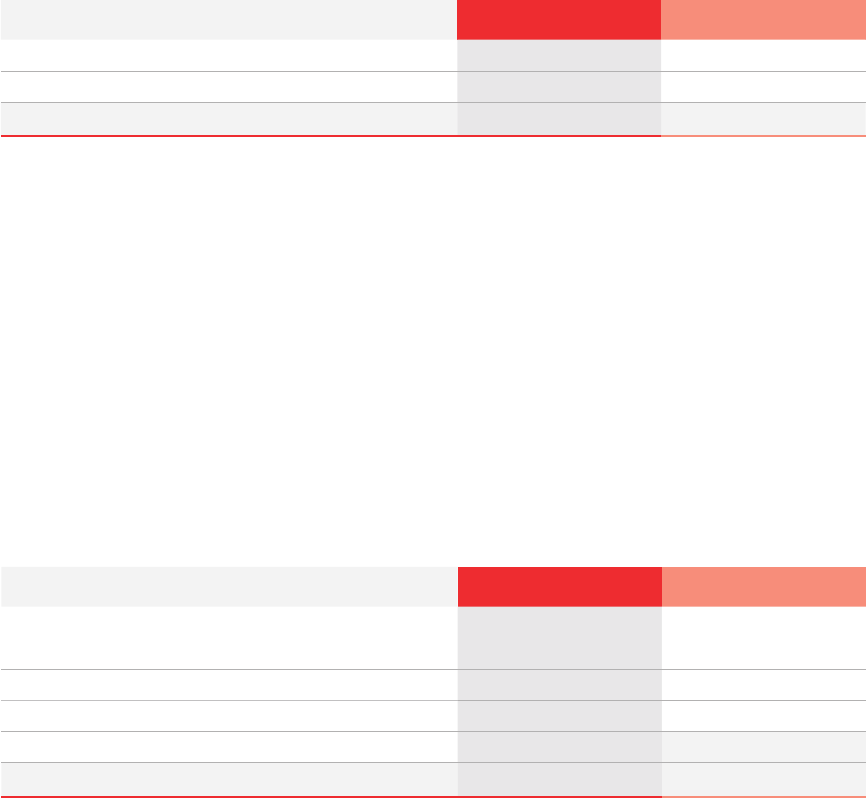
78
Annual Report of Yeti GermanCo 1 GmbH 2020
Joint operations
Messer LLC, USA, holds a 50 % interest in joint arrangements named East Coast Nitrogen Company LLC,
Delaware, USA, and East Cost Oxygen Company LLC, Delaware, USA, which were formed as partnerships
with Air Products, USA, to produce liquid nitrogen, oxygen and argon for selected partners of the joint
arrangement.
The associated assets and liabilities, income and expenses from joint operations are included in the consoli-
dated financial statements according to the economically attributable share.
The following table shows the summarized financial data of the individually immaterial joint arrangements:
17. Equity Investments
“Equity Investments” comprises equity investments in the companies Lida S.A.S., France, and Soprogaz
S.N.C., France, which are neither consolidated nor accounted for using the equity method.
18. Other Financial Investments
Other financial investments are investment securities; information on their measurement can be found under
note 32 “Other Financial Instrument Disclosures”.
19. Other Non-Current Receivables and Assets
Jan. 1 - Dec. 31, 2020 Jan. 1 - Dec. 31, 2019
Net profit for the year (6,366) (4,413)
Other comprehensive income (5,562) 161
Total comprehensive income (11,928) (4,252)
Dec. 31, 2020 Dec. 31, 2019
Trade receivables 10 282
Other receivables 25,365 37,082
Financial assets 25,375 37,364
Prepaid expenses 1,959 1,357
Non-financial assets 1,959 1,357
Total 27,334 38,721
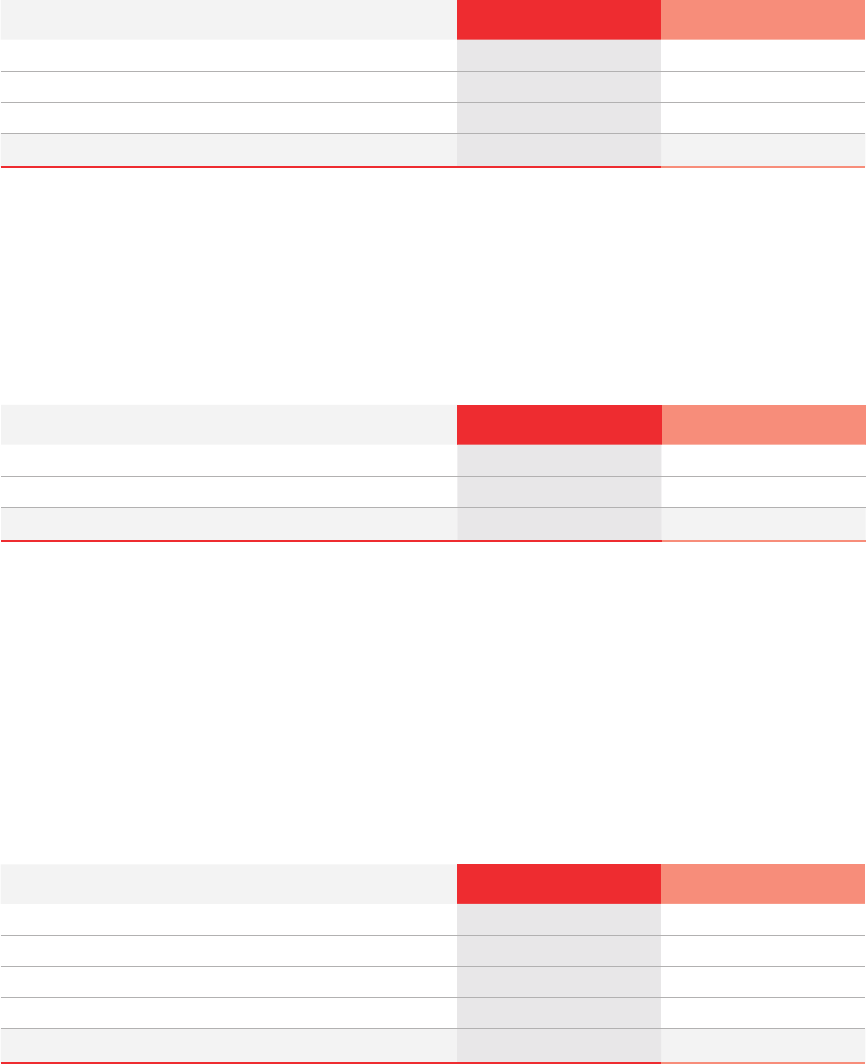
79
Annual Report of Yeti GermanCo 1 GmbH 2020
20. Inventories
K€ 17,772 (previous year: K€ 17,288) of the inventories recognized on December 31, 2020 were measured
at their net realizable value. There are impairment losses of K€ 14,150 (previous year: K€ 14,834) on the
net realizable value. The impairment losses were recognized in the cost of sales. The amount of inventories
recognized as an expense in the reporting period is K€ 446,330 (previous year: K€ 385,252).
21. Trade Receivables
22. Contract Balances
All work related to engineering contracts was billed in fiscal 2020 and 2019 and the corresponding amounts
were reported in trade receivables.
Performance obligations from contracts with customers
The following table shows the Group’s performance obligations from long-term gas supply contracts with
customers:
The amounts shown above essentially relate to contractually agreed fixed payments, known as take-or-
pay installments. Variable obligations were not taken into account. Revenue is recognized on delivery of
the gases.
Dec. 31, 2020 Dec. 31, 2019
Raw materials and supplies 24,018 27,233
Work in progress 6,166 3,797
Finished goods and goods for resale 126,177 153,491
Total 156,361 184,521
Dec. 31, 2020 Dec. 31, 2019
Trade receivables 292,220 314,754
Write-downs on receivables (35,428) (38,347)
Total 256,792 276,407
Dec. 31, 2020 Dec. 31, 2019
Due in 1st year 230,046 104,598
Due in 2nd year 228,203 104,183
Due in 3rd year 224,812 99,833
Due after more than 3 years 1,269,298 491,759
Total 1,952,359 800,373
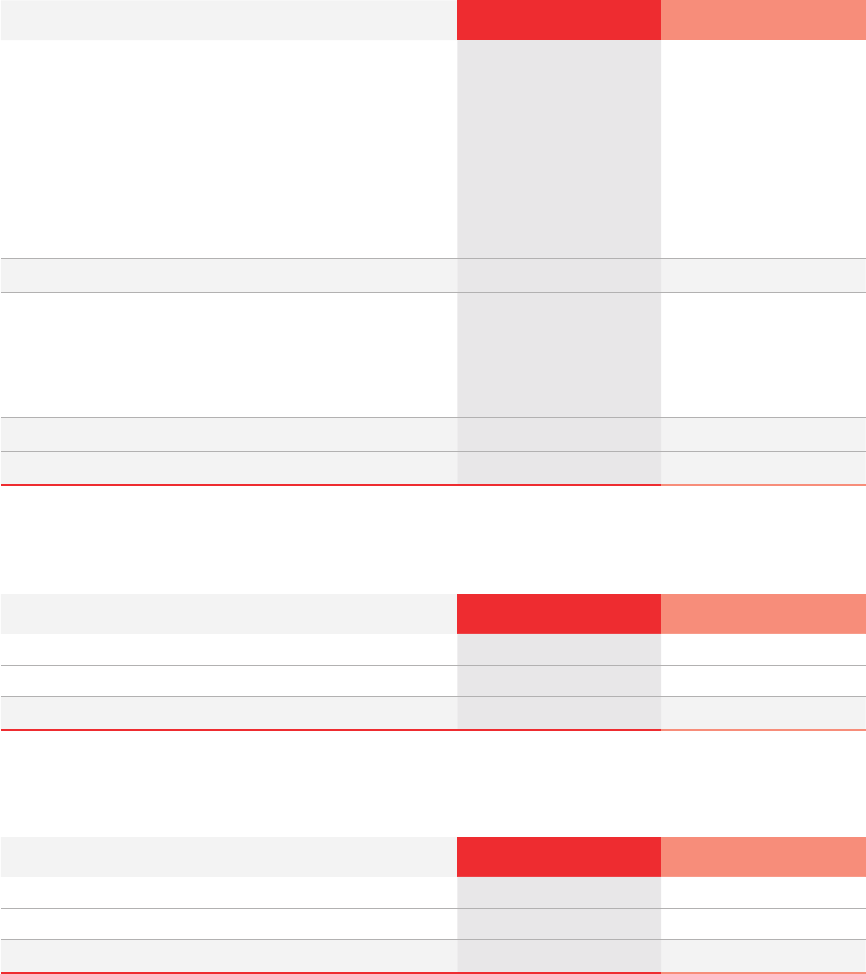
80
Annual Report of Yeti GermanCo 1 GmbH 2020
23. Other Current Financial and Non-Financial Assets
24. Cash and Cash Equivalents
25. Provisions for Employee Benefits
Pension benefits are provided to employees in a number of countries through both defined benefit and
defined contribution pension plans. The benefits vary according to legal, fiscal and economic circumstances
of each country. Plan benefits are based on years of service and the level of employee compensation.
Provisions for other employee benefits mainly relate to company or statutory severance benefits and early
retirement benefits. Some of the obligations under defined benefit pension plans are covered by plan assets
held in independent trust funds. The net assets of these funds are predominantly invested negotiable
equities, real estate and fixed-income securities.
Dec. 31, 2020 Dec. 31, 2019
Other receivables from operating activities 14,294 29,194
Receivables from related parties 5,365 4,731
Derivative financial instruments in hedges 3,686 5,095
Deposits and guarantees 416 388
Derivative financial instruments not in hedges – 109
Receivables from employees 11 2 40
Miscellaneous 561 2,762
Financial assets 24,434 42,319
Other tax receivables 36,427 44,563
Deferred expenses 6,276 9,449
Prepayments 79 864
Miscellaneous 6 45
Non-financial assets 42,788 54,921
Total 67,222 97,240
Dec. 31, 2020 Dec. 31, 2019
Cash, bank balances and checks 410,807 577,422
Cash equivalents − −
Cash and cash equivalents 410,807 577,422
Dec. 31, 2020 Dec. 31, 2019
Pension provisions 46,657 49,201
Provisions for other employee benefits 505 507
Provisions for employee benefits 47,162 49,708

81
Annual Report of Yeti GermanCo 1 GmbH 2020
The present value of the funded pension commitments predominantly relates to pension plans of Messer
Canada Inc. in the amount of K€ 84,167 (previous year: K€ 86,463).
Messer Canada Inc. operates a funded pension plan that grants members benefits in the form of a guaran-
teed lifetime pension. The amount of this pension is based on average income and is linked to age and
length of service. In Canada, the defined benefit component of the plan has been closed to new entrants
since January 1, 2005. Newcomers join a defined contribution plan. In the defined benefit pension plan,
future service recognition will be discontinued for the remaining employees, with final recognition ending
on June 30, 2021.
The Canadian pension plan is managed by a pension committee and its assets are held in a pension fund
that is legally independent of the company. The assets cannot be used for any purpose other than the
payment of pension benefits and related administrative fees.
The minimum funding requirements in Canada require the company to make special payments to amortize
any shortfalls in plan assets in relation to the relevant funding objectives. Instead of these special payments,
collateral in the form of letters of credit up to a maximum of 15 % of the actuarial liability used to determine
the funding objective is permitted. The company does not currently use any letters of credit.
In accordance with Canadian law, any remainder after accrued benefits have been provided to plan members
and after the plan has ended may be returned to the company. Pension legislation in Canada may require
the company to make a proposal to members and beneficiaries regarding the allocation of excess assets.
Part of this surplus can be used by the company to reduce future contributions or to pay refundable
administrative expenses.
The company also offers a limited number of active employees and retirees employer-paid life insurance and
post-retirement health plans. The post-retirement benefit plan is not funded.
Defined benefit plans expose the Company to various risks. In addition to general actuarial risks such as
longevity risk and interest rate risk, the Company is exposed to currency risk and capital market / investment
risk. The risk exposures from the respective plans are not materially different.
The amount recognized in the statement of financial position is derived as follows:
Dec. 31, 2020 Dec. 31, 2019
Present value of funded pension benefits 122,254 132,497
Present value of pension benefits funded by provisions 15,048 18,787
Present value of all pension benefits 137,302 151,284
Fair value of plan assets of all funds (90,645) (102,083)
Net liability recognized 46,657 49,201
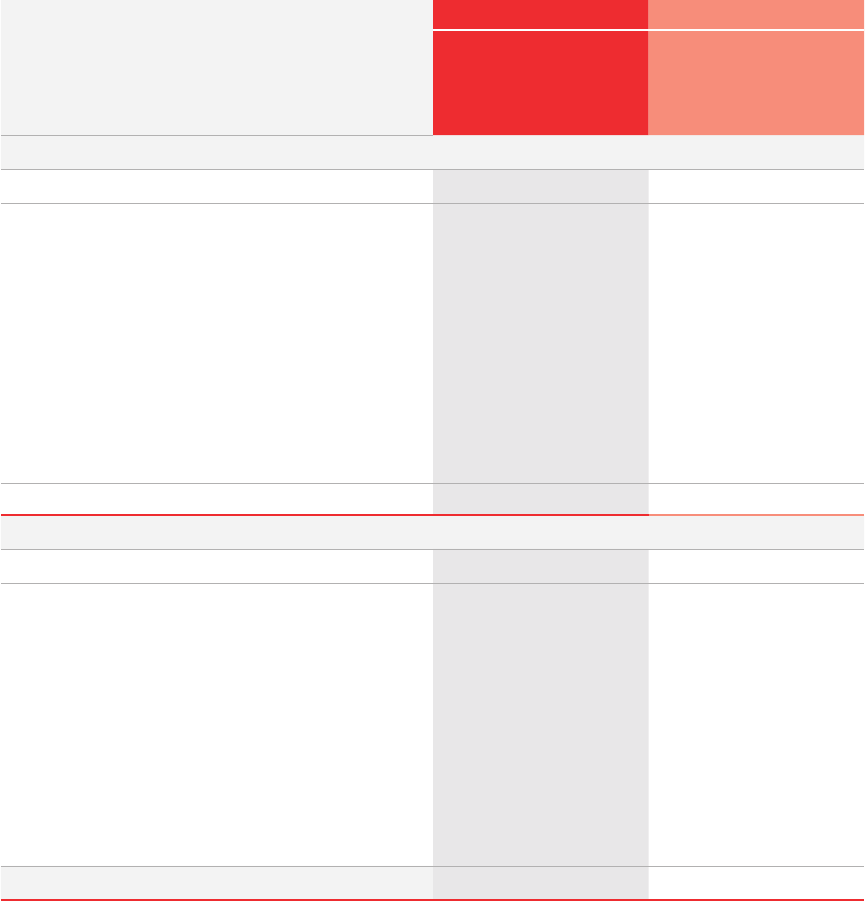
82
Annual Report of Yeti GermanCo 1 GmbH 2020
The following table shows the reconciliation of the funding of defined benefit plans to the amounts recogni-
zed in the consolidated financial statements as of December 31, 2020 and 2019:
The “Others” item under pension benefits relates to adjustments in the funded pension plan caused by
lowering the conversion rate for standard pension age at Messer Schweiz AG, Switzerland. The applicable
conversion rate is used to convert the pension credit available as of the pension date into a pension. As a
result of the change, the Group’s obligation was reduced by K€ 1,165, which was recognized in profit or loss.
The “Others” item also shows the disposal of pension benefits and plan assets for Messer B.V., Netherlands,
in the same amount. This disposal was recognized in other comprehensive income.
The changes in group reporting in 2019 relate to the subsidiaries in North and South America and Western
Europe, which were added as of March 1, 2019.
Dec. 31, 2020 Dec. 31, 2019
Pension
commitments
funded by
provisions
Pension
commitments
funded by
funds
Pension
commitments
funded by
provisions
Pension
commitments
funded by funds
Change in the present value of the defined benefit pension plans
Present value of all pension benefits as of Jan. 1 18,787 132,497 – –
Change in group reporting – – 13,610 124,173
Current service cost 266 1,394 223 1,320
Past service cost – – (245) –
Interest expense on obligations 801 2,630 981 2,754
Employee contributions – 503 – 489
Actuarial losses (gains) (417) 7,486 5,214 6,058
Pension payments (515) (7,282) (784) (4,614)
Others – (9,041) – –
Exchange rate changes (3,874) (5,933) (212) 2,317
Present value of all pension benefits as of Dec. 31 15,048 122,254 18,787 132,497
Change in plan assets of all funds
Fair value of plan assets of all funds as of Jan. 1 – 102,083 – –
Change in group reporting – − – 96,387
Interest income / (losses) – 2,057 – 2,123
Income / (losses) (not including interest income) – 3,562 – 3,537
Contributions paid in – employer – 2,151 – 2,264
Contributions paid in – employees – 503 – 489
Pension payments – (7,145) – (4,466)
Unrecognized excess of plan assets – − – −
Others – (7,876) – −
Exchange rate changes – (4,690) – 1,749
Fair value of plan assets of all funds as of Dec. 31 – 90,645 – 102,083
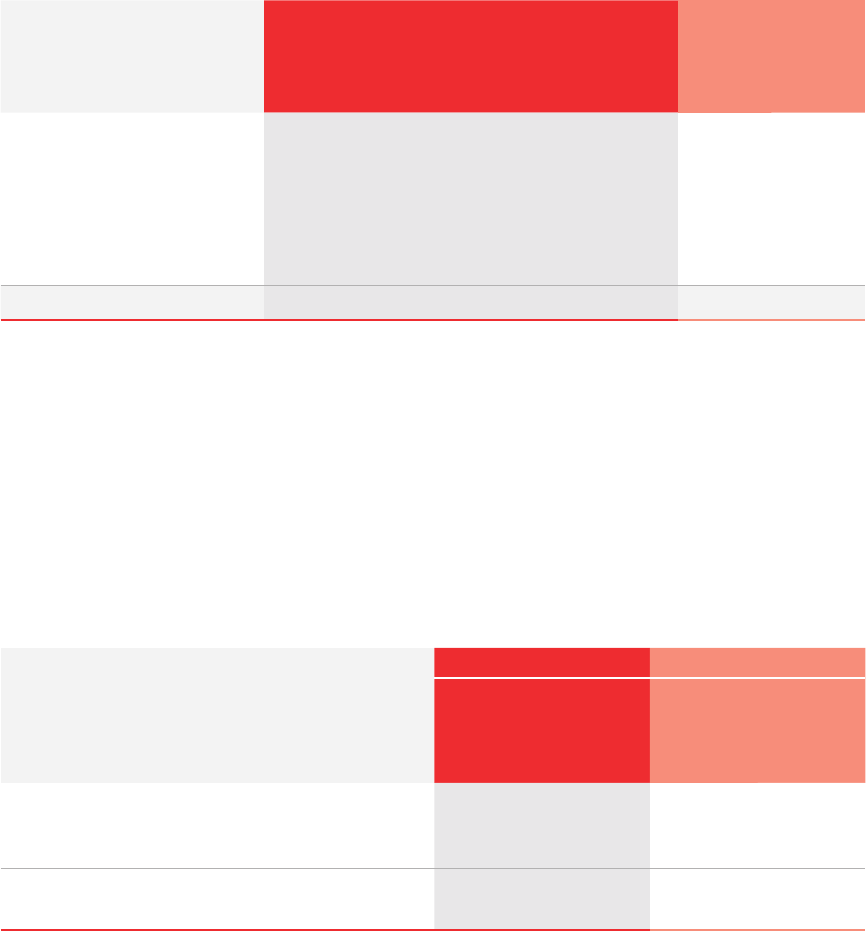
83
Annual Report of Yeti GermanCo 1 GmbH 2020
Plan assets are held exclusively to fulfill defined benefit obligations. The funding of these obligations
constitutes a reserve for future cash outflows. This is based on statutory regulations in some countries
and is voluntary in others. Given the diversity of pension benefits within the Group, the interest rate is not
hedged using financial instruments. Following guidelines stipulated by local management, the bodies
responsible for the various pension funds decide on the best possible investment strategy commensurate
with the age of beneficiaries and the timing of future payments, in accordance with applicable legislation.
Most of the plans are not intended to maximize profit, but rather to ensure optimal provision for the compa-
nies and employees concerned. Funds held to pay future benefits are invested responsibly.
Actuarial losses / (gains) arising on the of the present value of pension benefits comprise the following:
The fair value of plan assets breaks down among the individual asset classes as follows. The amounts
shown are weighted averages:
Dec. 31, 2020
Fair value
quoted on an
active market
not quoted
on an active
market
Dec. 31, 2019
Fair value
Equity instruments / funds 39,179 44 % 5,128 34,051 46,218 45 %
Bonds 37,321 41 % 4,806 32,515 41,316 40 %
Qualifying insurance policies 6,326 7 % – 6,326 6,055 6 %
Real estate 3,851 4 % 1,317 2,534 4,235 4 %
Other assets 2,881 3 % 1,580 1,301 2,727 3 %
Cash funds 1,087 1 % 1,087 – 1,532 2 %
Total 90,645 10 0 % 13,918 76,727 102,083 10 0 %
Jan. 1 - Dec. 31, 2020 Jan. 1 - Dec. 31, 2019
Pension
commitments
funded by
provisions
Pension
commitments
funded by
funds
Pension
commitments
funded by
provisions
Pension
commitments
funded by funds
Experience adjustments 409 395 1,566 (1,537)
Change in financial assumptions (826) 7,091 3,648 7,595
Change in biometric assumptions – – – –
Actuarial losses / (gains) arising on the remeasurement
of the present value of pension benefits
(417) 7,486 5,214 6,058
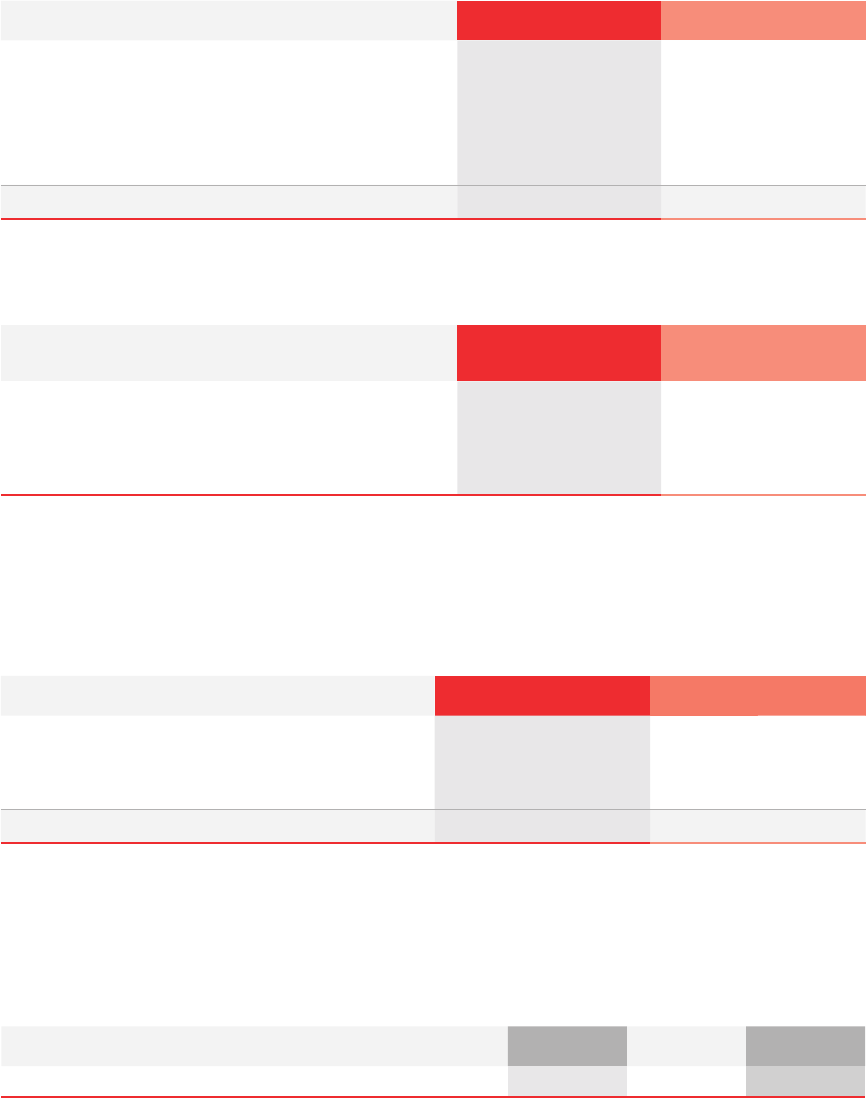
84
Annual Report of Yeti GermanCo 1 GmbH 2020
The following items were recognized in profit or loss in the reporting period:
The calculation of obligations and, in certain cases, the related plan assets is based on the following actuarial
parameters (reported as a weighted average):
The CPM 2014 tables were used to measure pension obligations in Canada. The pension obligation in
Switzerland was measured using the BVG 2015 GT mortality tables. Mortality tables specific to each compa-
ny were used to measure the pension obligations for other Group companies.
The present value of the defined benefit obligation relates to the following groups of beneficiaries:
The weighted average term of the defined benefit obligation as of December 31, 2020 is 14.7 years
(previous year: 15.1 years).
An increase or decrease in the discount rate by 50 basis points would have the following effect on the
present value of pension obligations as of December 31, 2020:
Jan. 1 - Dec. 31, 2020 Jan. 1 - Dec. 31, 2019
Current service cost 1,660 1,543
Past service cost – –
Interest expense on obligations 3,431 3,735
Expected return on plan assets (2,057) (2,123)
Others – –
Total amounts recognized in profit and loss 3,034 3,155
Dec. 31, 2020
in percent
Dec. 31, 2019
in percent
Discount rate 2.19 2.65
Expected rate of salary increases 1.63 1.66
Expected return on plan assets 0.50 0.42
Expected rate of pension increases 0.82 0.84
Dec. 31, 2020 Dec. 31, 2019
Active beneficiaries 90,420 66 % 92,302 61 %
Beneficiaries who have left the company 11,657 8 % 17,697 12 %
Retired employees 35,225 26 % 41,285 27 %
Total 137,302 100 % 151,284 10 0 %
Change in discount rate in basis points
- 50 - / + 0 + 50
Present value of all pension benefits 149,801 137,302 127,088
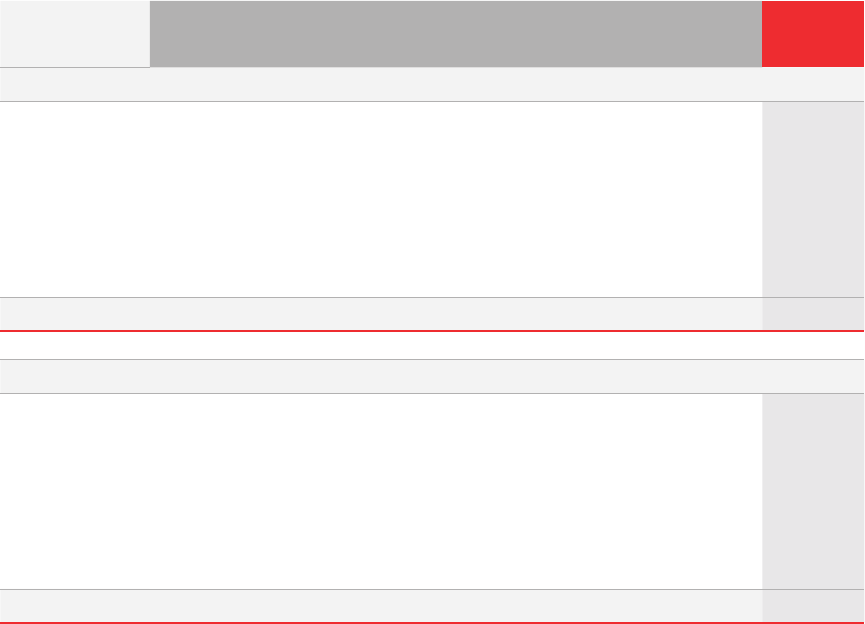
85
Annual Report of Yeti GermanCo 1 GmbH 2020
The sensitivity calculations are based on the average term of the pension obligations calculated as of
December 31, 2020. The calculation was made for the discount rate, the actuarial parameter classified as
material. As the sensitivity analysis is based on the average duration of the expected pension obligations
and therefore the expected payment dates are not taken into account, it only produces approximate
information or trend statements.
The Group anticipates contributions to the defined benefit plans of K€ 4,089 (previous year: K€ 2,622) in
2021.
26. Other Provisions
Contracts for which provisions have been recognized essentially have a broad range of remaining terms of
between one and 10 years.
The provisions for contractually agreed restoration obligations for existing plants essentially relate to
Messer LLC, USA. Messer North America Inc., USA, accounted for a significant portion of the provisions for
environmental risks, which were recognized for long-term plant cleaning obligations.
The provisions for litigation essentially relate to the areas of antitrust, HR and civil litigation. For more
information on a provision for litigation risks in Spain, please refer to note 31 “Contingent Liabilities”.
Jan. 1, 2020 Addition Utilization
Unused
amounts
reversed
Change
in group
reporting
Currency
translation
Dec. 31,
2020
Long-term
Restoration
obligations
27,603 5,393 (582) – – (2,653) 29,761
Litigation 9,885 6,246 (750) (922) – (2,438) 12,021
Environmental
risks
7,104 9,950 (473) – (1,233) 15,348
Personnel 3,274 3,031 (2.776) (286) – (168) 3,075
Miscellaneous 3,201 675 (500) (2,649) – – 727
Total 51,067 25,295 (5,081) (3,857) – (6,492) 60,932
Current
Personnel 10,670 4,626 (3,910) (282) – (482) 10,622
Environmental
risks
5,225 5,752 (4,236) – (542) 6,199
Restoration
obligations
3,595 1,596 (246) – – (297) 4,648
Litigation 1,384 2,014 (597) (182) – (254) 2,365
Miscellaneous 5,985 1,358 (4,279) (248) – (118) 2,698
Total 26,859 15,346 (13,268) (712) – (1,693) 26,532
86
Annual Report of Yeti GermanCo 1 GmbH 2020
Personnel provisions as of December 31, 2020 predominantly relate to bonus payments and outstanding
vacation.
The discounting of long-term provisions amounts to K€ 3,771 (previous year: K€ 2,116).
27. Financial liabilities
On March 1, 2019, Messer Industries GmbH and Messer Industries USA, Inc., USA, (as the borrower) and
Yeti GermanCo 3 GmbH (as another party), signed a loan agreement with a banking group led by CITIBANK
NA, UK.
The loan agreement serves to partially finance the purchase price payment for the Linde AG and Praxair
business acquired in North and South America in 2019 and to finance ongoing business operations.
The credit agreement contains three facilities:
• “Facility B-1” of USD 2,225 million, a long-term, fully utilized loan with a term of seven years. The borrower
is Messer Industries USA, Inc., USA. The loan will be repaid quarterly at 0.25 % of the original amount,
starting on June 28, 2019. The balance will be repaid in full on March 1, 2026. The margin is 2.5 % p.a. or
1.5 % p.a. depending on the underlying refinancing base of the banks.
• “Facility B-2” of € 540 million, a long-term, fully utilized loan with a term of seven years. The borrower
is Messer Industries GmbH. The loan is due on March 1. 2026. The margin was initially 2.75 % p.a., until
August 28, 2019, since when it has been subject to an adjustment mechanism based on the development
of the ratio of senior net debt to consolidated EBITDA.
• “Revolving facility” of USD 450 million: The borrowers are Messer Industries GmbH and Messer Industries
USA, Inc., Delaware, and any other company that secures the loan agreement as a guarantor. The facility
can be used to finance working capital and for all general financing requirements of the company on a
revolving basis. There is no need to reduce the loan to zero at any time during its term. It is available until
March 1, 2024. The margin was 1.75 % p.a. or 0.75 % p.a., depending on the underlying refinancing base
of the banks, until August 28, 2019, since when it has been subject to an adjustment mechanism based
on the development of the ratio of senior net debt to consolidated EBITDA.
Guarantees provided by individual Group companies serve as collateral for the full amount of the financing
arrangements:
Messer Industries GmbH, Messer Industries USA Inc., USA, Messer LLC, USA, Messer France S.A.S.,
France, Messer Canada Inc., Canada, and Messer Gases Ltda., Brazil.
Shares in the following companies have been pledged to the banks:
Messer Industries GmbH, Messer Industries USA, Inc., USA, Messer Gases Ltda., Brazil, and Messer France
S.A.S., France.
The assets of the following companies have been pledged to the banks:
Messer Industries USA, Inc., USA, Messer Canada Inc., Canada, and Messer LLC, USA. The carrying amount
of the companies’ property, plant and equipment is K€ 1,197,882.
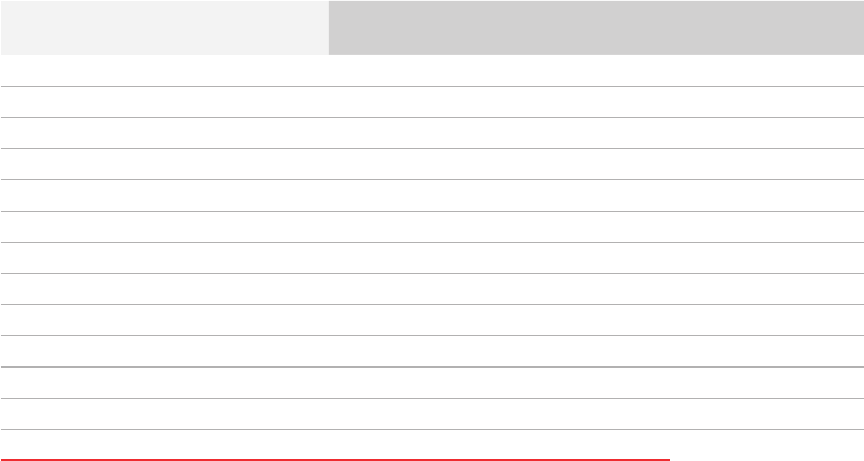
87
Annual Report of Yeti GermanCo 1 GmbH 2020
The bank accounts of the following companies have been pledged to the banks:
Messer Industries GmbH, Messer Gases Ltda., Brazil, Messer France S.A.S., France and Yeti GermanCo 3
GmbH with a total carrying amount of K€ 198,737.
The receivables of the following companies have been pledged to the banks:
Messer Gases Ltda., Brazil, and the intercompany receivables of Yeti GermanCo 3 GmbH, Messer Industries
GmbH and Messer France S.A.S., France. The carrying amount of the pledged receivables is K€ 42,064.
Intercompany receivables with a nominal value of K€ 43,389 have also been pledged.
The unutilized credit facilities amount to € 290 million as of December 31, 2020 (previous year: € 279 million).
The loan balances and maturities are as follows as of December 31, 2020:
1
K€ 9,498 was utilized as a guarantee for delivery and performance obligations; foreign currencies were translated using the rate as of
December 31, 2020.
2
K€ 7,486 was utilized as a guarantee for delivery and performance obligations; foreign currencies were translated using the rate as of
December 31, 2020.
3
K€ 17,234 was utilized as a guarantee for delivery and performance obligations and to secure credit facilities; foreign currencies were
translated using the rate as of December 31, 2020.
4
K€ 29,482 was utilized as a guarantee to secure credit facilities; foreign currencies were translated using the rate as of December 31,
2020.
5
K€ 12,631 was utilized as a guarantee for delivery and performance obligations and to secure credit facilities; foreign currencies were
translated using the rate as of December 31, 2020.
6
Weighted interest rate as of December 31, 2020, foreign currencies were translated using the rate as of December 31, 2020.
2020
Interest rate
p. a.
Credit facility Utilization Due date
USD 2,225.0 million, facility B-1 2.75 % 1,781,487 1,781,487 March 1, 2026
€ 540.0 million, facility B-2 2.50 % 540,000 540,000 March 1, 2026
USD 263.1 million, revolving facility 0.00 % 214,408 – March 1, 2024
USD 13.0 million, RFA ancillary facility
1
0.00 % 1,096 – March 1, 2024
USD 45.0 million, RFA ancillary facility
2
0.00 % 29,185 – March 1, 2024
USD 44.0 million, RFA ancillary facility
3
0.00 % 18,623 – March 1, 2024
USD 39.9 million, RFA ancillary facility
4
0.00 % 3,034 – March 1, 2024
USD 45.0 million, RFA ancillary facility
5
0.00 % 24,040 – March 1, 2024
Other local loans
6
3.02 % 3,845 3,845 Various
Lease liabilities
6
5.82 % n / a 86,098 Various
2,615,718 2,411,430
Transaction costs (54,314)
2,357,116
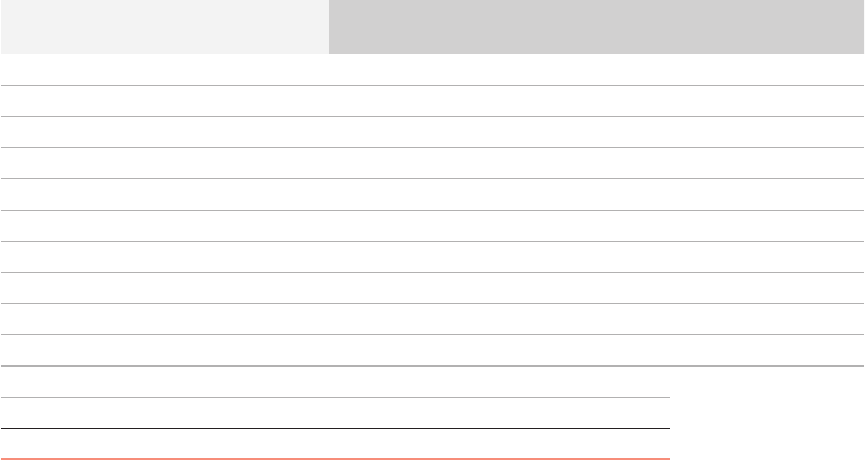
88
Annual Report of Yeti GermanCo 1 GmbH 2020
1
K€ 10,649 was utilized as a guarantee for delivery and performance obligations; foreign currencies were translated using the rate as of
December 31, 2019.
2
K€ 28,391 was utilized as a guarantee for delivery and performance obligations; foreign currencies were translated using the rate as of
December 31, 2019.
3
K€ 22,601 was utilized as a guarantee for delivery and performance obligations and to secure credit facilities; foreign currencies were
translated using the rate as of December 31, 2019.
4
K€ 35,517 was utilized as a guarantee to secure credit facilities; foreign currencies were translated using the rate as of December 31,
2019.
5
K€ 24,301 was utilized as a guarantee for delivery and performance obligations and to secure credit facilities; foreign currencies were
translated using the rate as of December 31, 2019.
6
Weighted interest rate as of December 31, 2019, foreign currencies were translated using the rate as of December 31, 2019
The loan balances and maturities are as follows as of December 31, 2019:
Transaction costs relate to the arrangement fees paid to the financing banks and various legal and advisory
costs directly attributable to the new financing. These costs are recognized as an expense over the terms of
the liabilities using the effective interest method in accordance with IFRS 9.
2019
Interest rate
p. a.
Credit facility Utilization Due date
USD 2,225.0 million, facility B-1 4.45 % 1,965,740 1,965,740 March 1, 2026
€ 540.0 million, facility B-2 2.50 % 540,000 540,000 March 1, 2026
USD 263.1 million, revolving facility 0.00 % 234,200 – March 1, 2024
USD 13.0 million, RFA ancillary facility
1
0.00 % 923 – March 1, 2024
USD 45.0 million, RFA ancillary facility
2
0.00 % 11,666 – March 1, 2024
USD 44.0 million, RFA ancillary facility
3
0.00 % 16,566 – March 1, 2024
USD 39.9 million, RFA ancillary facility
4
0.00 % – – March 1, 2024
USD 45.0 million, RFA ancillary facility
5
0.00 % 15,756 – March 1, 2024
Other local loans
6
1.50 % 841 841 Various
Lease liabilities
6
6.06 % n / a 89,212 Various
2,785,692 2,595,793
Transaction costs (69,538)
2,526,255
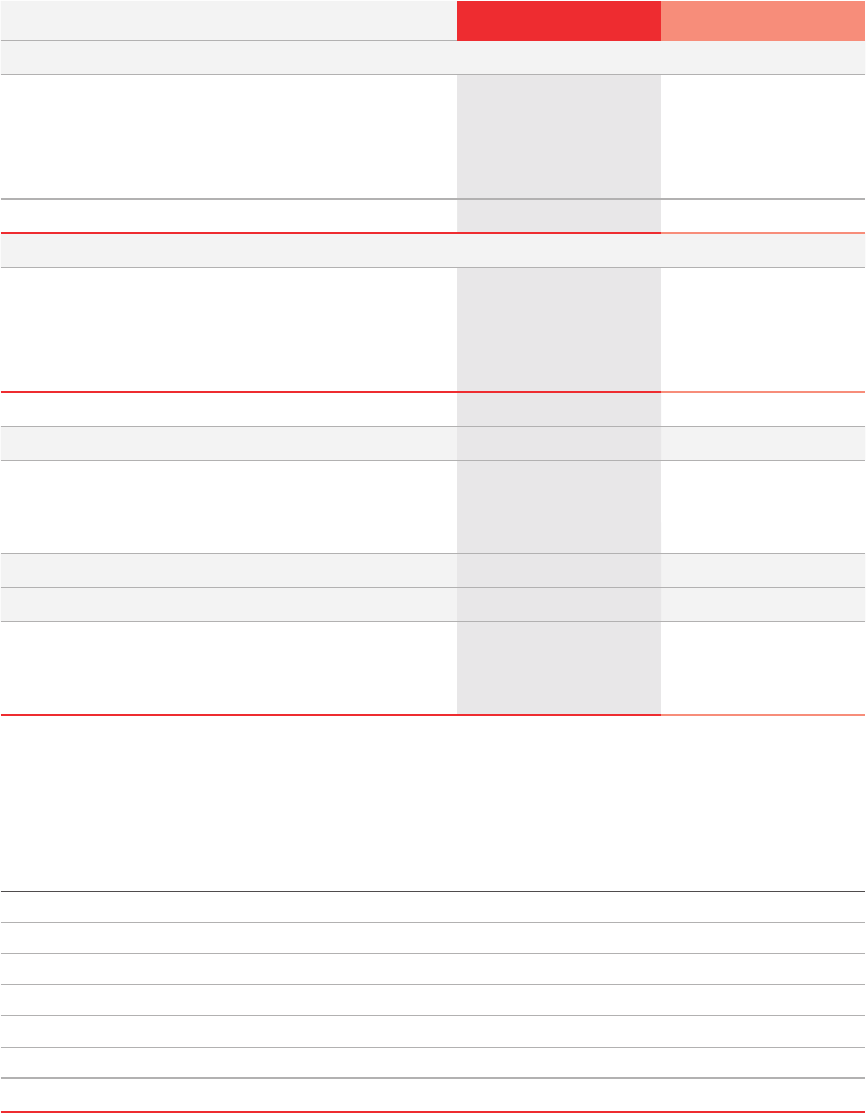
89
Annual Report of Yeti GermanCo 1 GmbH 2020
The average interest rate on financial liabilities was 2.81 % p. a. as of December 31, 2020 (previous year:
4.10 % p.a.).
Financial liabilities (not including transaction costs) are due as follows:
The following table provides an overview of the Group’s financial liabilities, measured on the basis of
nominal amounts:
2021 33,935
2022 31,970
2023 29,397
2024 25,531
2025 24,439
After 2025 2,266,158
2,411,430
Dec. 31, 2020 Dec. 31, 2019
Long-term
Liabilities to banks 2,306,414 2,486,752
Lease liabilities 71,081 74,194
Miscellaneous – –
Less transaction costs (43,754) (58,212)
2,333,741 2,502,734
Current
Liabilities to banks 18,918 19,829
Lease liabilities 15,017 15,018
Miscellaneous – –
Less transaction costs (10,560) (11,326)
23,375 23,521
Total Financial liabilities, net 2,357,116 2,526,255
Liabilities with a fixed interest rate 89,943 90,053
Liabilities with variable interest rates (hedged) 1,873,203 –
Liabilities with variable interest rates (not hedged) 448,284 2,505,740
Total financial liabilities, gross 2,411,430 2,595,793
Weighted average nominal interest rates for liabilities:
To banks 2.69 % 4.03 %
Leases 5.82 % 6.06 %
Other loans – –
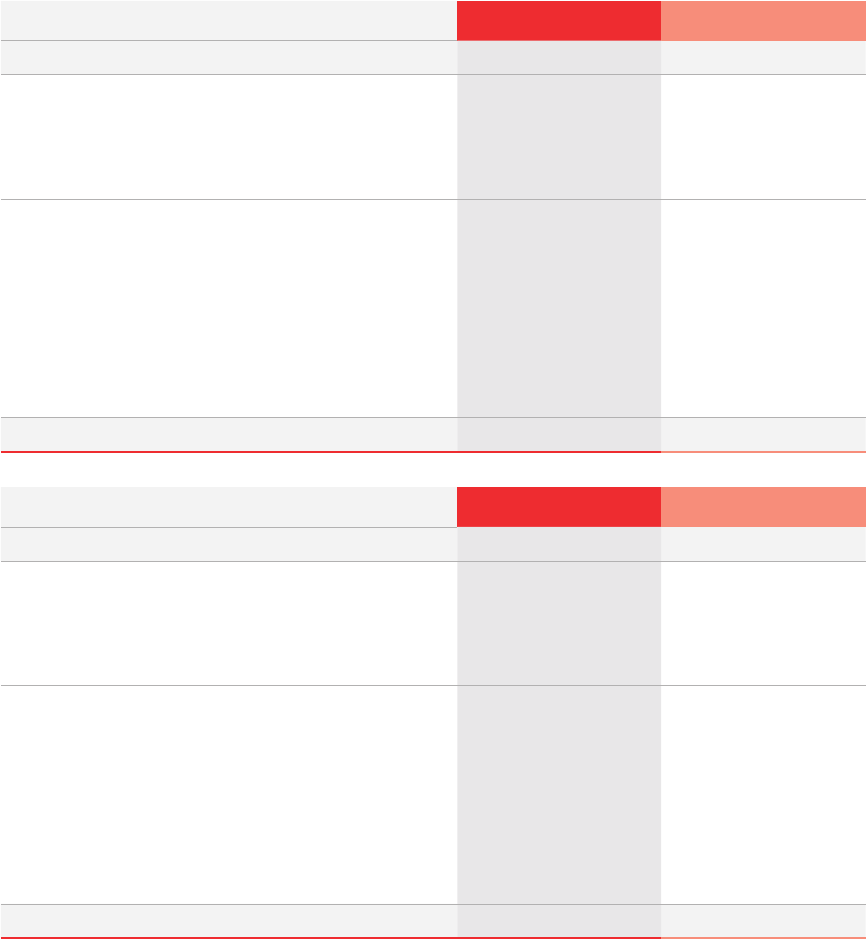
90
Annual Report of Yeti GermanCo 1 GmbH 2020
Under the credit agreement, the following key financial covenants must be complied with and calculated
in each compliance certificate submitted:
• First lien net leverage: ratio of senior consolidated net liabilities to consolidated EBITDA. This covenant
relates exclusively to the revolving facility and is only tested if utilized by more than 40 %. It must not
exceed 8x the value. Non-compliance is an event of default, but this can only be determined by the
lenders under the revolving credit facility.
2020 2019
Non-current financial liabilities as of Jan. 1 2,502,734 –
Cash changes
New debt raised 3,317 2,525,732
Transaction costs − (61,608)
Payments of principal (34,068) (25,074)
Non-cash changes
Additions to lease liabilities 21,435 7,385
Changes in maturities (5,227) (19,845)
Currency translation (5,517) 67
Exchange rate changes (160,027) (3,363)
Change in group reporting – 76,126
Transaction costs 11,094 3,314
Non-current financial liabilities as of Dec. 31 2,333,741 2,502,734
2020 2019
Current financial liabilities as of Jan. 1 23,521 –
Cash changes
New debt raised 50 175
Transaction costs – (13,119)
Payments of principal (6,333) (193)
Non-cash changes
Additions to lease liabilities 3,012 –
Changes in maturities 5,227 19,845
Currency translation (1,136) 27
Exchange rate changes (966) (19)
Change in group reporting – 15,028
Transaction costs – 1,777
Current financial liabilities as of Dec. 31 23,375 23,521
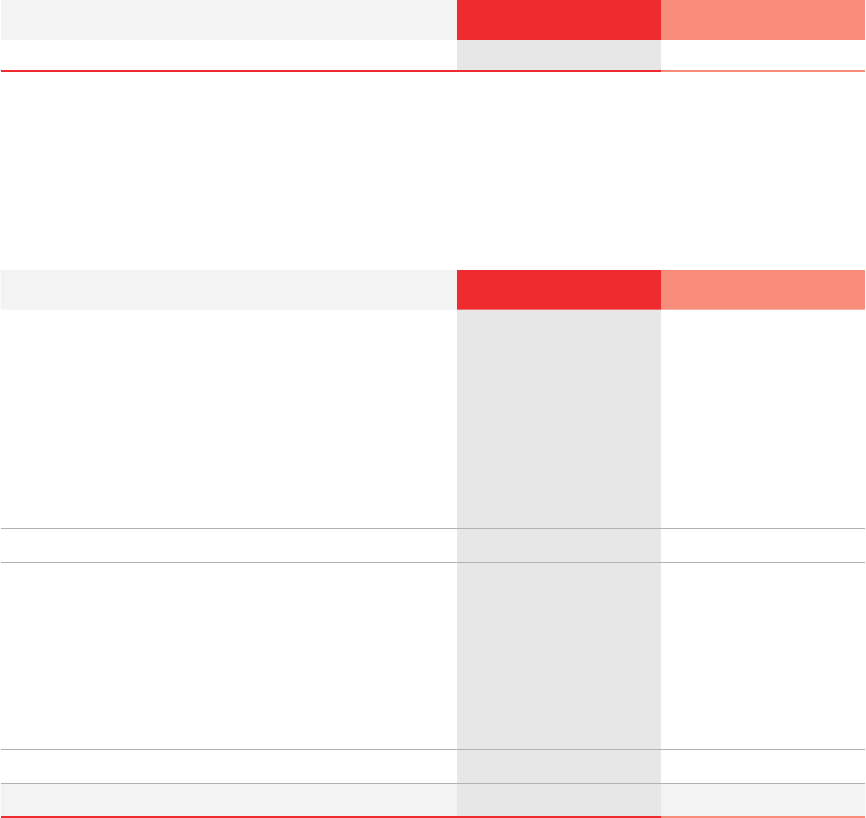
91
Annual Report of Yeti GermanCo 1 GmbH 2020
The following covenants are only relevant for certain planned transactions and compliance with them
must be demonstrated on a pro forma basis before the transaction:
• Secured net leverage: ratio of secured, consolidated net liabilities to consolidated EBITDA. The
covenant must be tested if collateral is to be provided that is subordinate to the collateral of the
credit agreement. The covenant must be less than or equal to 5.25:1.00.
• Total net leverage: The ratio of total net liabilities to consolidated EBITDA must be less than or equal to
5.25:1.00, 4.50:1.00 or 3.75:1.00, depending on the transaction at issue.
• Fixed charge coverage: The ratio of EBITDA to interest paid (substantially) in cash must be greater than 2.0.
Other non-current financial liabilities essentially comprise economic aid for the coronavirus pandemic in the
form of tax deferrals that will become due at a future date.
29. Current Income Tax Liabilities and Other Current Liabilities
28. Other Non-Current Financial Liabilities
Dec. 31, 2020 Dec. 31, 2019
Other non-current financial liabilities 2,052 –
Dec. 31, 2020 Dec. 31, 2019
Derivative financial instruments with an effective hedge 15,255 12,669
Other liabilities to customers 1,384 1,327
Deposits received for hardware 1,306 1,321
Interest payable 550 577
Derivative financial instruments without an effective hedge 266 348
Liabilities to related companies 60 531
Miscellaneous liabilities 64,278 16,403
Financial liabilities 83,099 33,176
Deferred income and other deferred liabilities 96,490 132,509
Payroll liabilities 44,584 46,406
Other taxes liabilities 25,669 38,521
Advance payments received on orders 16,203 18,583
Liabilities to social security providers 9,296 13,543
Other financial obligations 42,613 60,058
Non-financial liabilities 234,855 309,620
Total 317,954 342,796
92
Annual Report of Yeti GermanCo 1 GmbH 2020
Derivative financial instruments with an effective hedge include the negative fair values of currency forwards,
energy swaps and interest swaps.
The item “Deferred income and other deferred liabilities” includes liabilities for outstanding invoices of
K€ 65,824 (previous year: K€ 65,663). The remainder relates to deferred revenue of K€ 23,026, deferred
rental income for gas cylinders (K€ 6,856), other deferred income (K€ 586) and government grants (K€ 198).
The item “Other obligations” includes contingent liabilities recognized in conjunction with purchase price
allocation in 2019. The majority of this is attributable to Messer Gases Ltda., Brazil, and relates to obligations
arising from pending proceedings.
Current income tax liabilities
K€ 1,041 (previous year: K€ 263,100) of current income tax liabilities of K€ 27,022 (previous year: K€ 283,166)
relates to the tax group in the US. The high income tax liabilities in the previous year essentially related to
the tax expenses in connection with various sales of shares and corporate law activities carried out in
preparation for the acquisition of the US business of Linde and Praxair. These were paid in fiscal 2020.
Issued capital
By way of shareholder resolution of March 29, 2019, the share capital was increased by K€ 5 from K€ 25.
The issued capital thus amounts to K€ 30 (previous year: K€ 30) as of December 31, 2020 and is fully
paid in.
Capital reserves
By way of deposit agreement dated February 25, 2019, Investments S.à.r.l., Luxembourg, has agreed with
Yeti GermanCo 1 GmbH to pay a capital contribution of K€ 225 into the Company’s capital reserves. In
accordance with the payment direction agreement of February 25, 2019, K€ 75 of the deposit was paid in
cash directly to Yeti GermanCo 1 GmbH and indirect payments of K€ 75 each were made through Yeti
GermanCo 2 GmbH and Yeti GermanCo 3 GmbH.
By way of loan agreement of February 25, 2019, Yeti Investments S.à.r.l., Luxembourg, granted Yeti German-
Co 1 GmbH a shareholder loan of K€ 557,657. Subsequently, by way of deposit agreement dated February
27, 2019, a capital deposit in the form of a non-cash contribution was made by transferring the receivable of
Yeti Investments S.à.r.l., Luxembourg, to the capital reserves of Yeti GermanCo 1 GmbH in the amount of
K€ 557,657.
By way of agreement dated February 27, 2019, Messer Group GmbH and Yeti GermanCo 1 GmbH resolved
to transfer receivables and liabilities from the Western European Messer companies to the Company’s
equity as a mixed non-cash contribution in the amount of K€ 150,207. K€ 89,549 of this amount relates to
receivables, K€ 7,650 to liabilities and K€ 68,308 to the assignment of a purchase price receivable of Messer
GasPack GmbH from Messer GasPack 2 GmbH.
30. Equity

93
Annual Report of Yeti GermanCo 1 GmbH 2020
On February 27, 2019, Messer Group GmbH transferred its shares in Yeti GermanCo 2 GmbH in the amount
of K€ 600,515 to the capital reserves of Yeti GermanCo 1 GmbH. On February 28, 2019, Messer Group GmbH
made a contribution of K€ 16 to the capital reserves of Yeti GermanCo 1 GmbH in order to achieve the
intended shareholding in Yeti GermanCo 1 GmbH.
By way of deposit and assignment agreement of May 2 / 3, 2019, Messer Group GmbH has undertaken to
assign the purchase price receivable for a 11 % minority interest in Messer Industriegase GmbH to Yeti
GermanCo 1 GmbH and subsequently to add this to the free capital reserves of Yeti GermanCo 1 GmbH in
the form of a non-cash contribution. The capital reserves of Yeti GermanCo 1 GmbH were thus increased by
K€ 21,278.
The capital reserves amount to K€ 1,329,973 as of December 31, 2020 (previous year: K€ 1,329,973).
Retained earnings
Retained earnings comprise the undistributed past earnings of consolidated companies and the effects of
the remeasurement of the net defined benefit pension liability, net of deferred taxes.
Other components of equity
This item is used to report changes in equity in other comprehensive income, to the extent that such changes
do not relate to equity transactions with shareholders (e.g. capital increases or distributions). This includes
the difference in currency translation (through other comprehensive income), the result of net investments
in foreign operations and changes in the fair value measurement of derivatives used for hedging purposes.
Non-controlling interests
This item comprises the shares held by other shareholders in the equity of consolidated subsidiaries.
Non-controlling interests are held by other shareholders in Algeria and Belgium.
The dividend payments to other shareholders include distributions of the previous year’s results.
The following companies have insignificant non-controlling interests:
Name and registered office of subsidiary
Country
Shareholding in percent
Dec. 31, 2020 Dec. 31, 2019
bECO
2 B.V.B.A., Zwijndrecht
Belgium 70 % 70 %
Messer Algérie SPA, Alger Algeria 59.86 % 59.86 %

94
Annual Report of Yeti GermanCo 1 GmbH 2020
Capital management
A strong capital base is a key requirement for ensuring the continued existence of the Messer Industries
Group as a going concern. The items reported in the statement of financial position are considered equity.
Other items with the legal status of equity or other instruments similar in nature to equity are not used.
The owners of Messer Group GmbH, CVC, management in key positions and the Advisory Board ensure
that the trust of the lending banks, creditors and the market in general in Messer Industries Group is
maintained through a strong capital base.
Management in key positions and the Advisory Board regularly review and report to lending banks on
compliance with these and other targets.
31. Contingent Liabilities
Guarantees
Obligations from issuing guarantees were as follows:
Financial guarantees essentially relate to commitments to cover the contractual obligations of the
respective principal debtors. Pledges given to secure the liabilities of Group companies were eliminated
in consolidation and are thus not included in the above table.
Other financial obligations
The Group has undertaken to invest in the acquisition, construction and maintenance of various production
facilities. Obligations of this kind relate to the future purchase of plant and equipment at market prices.
There are also long-term contracts giving rise to obligations. As of December 31, 2020, the commitments
under orders, investment projects and long-term contracts amounted to K€ 612,942 (previous year:
K€ 325,469).
Litigation
A search was conducted at Messer Ibérica de Gases S.A., Spain, in November 2017. In this context, docu-
ments were confiscated relating to permits to build and operate our air separation units and a donation for
the renovation of a city hall. A decision on whether an action will be filed is expected in 2021.
The company was searched again in February 2019 in conjunction with a second investigation. The investiga-
tion was focused on the procurement, consumption and redistribution of electricity to Carburos Metallicos.
A third investigation is pending. The investigative records have not yet been disclosed, hence the subject
and target of the investigation are not yet known.
Dec. 31, 2020 Dec. 31, 2019
Maximum
potential
obligation
Amount reported
as a liability
Maximum potential
obligation
Amount reported as
a liability
Guarantees 83,268 – 122,848 –
95
Annual Report of Yeti GermanCo 1 GmbH 2020
It is currently assumed that the probability of a criminal conviction is low. Fines might be possible in administ-
rative procedures initiated separately at a later date.
After the Spanish regulator issued the Spanish power utility Endesa with a payment order for its grid usage
fee, Endesa invoiced Messer Ibérica de Gases S.A. for an additional charge in the same amount of € 35.6
million for allegedly underpaying its grid usage fee in the period 2008 to February 2020. In the opinion of
our local Spanish lawyers, both Endesa and Messer Ibérica de Gases S.A. have strong arguments for success-
fully defending against the claim for payment made by the Spanish regulator in its initial notice in an appeal,
and thus also against the claim made by Endesa against Messer Ibérica de Gases S.A.
Even if a claim to payment were assumed, our local lawyers believe there are good arguments for reducing
the amount claimed to less than € 10 million on the basis of the statute of limitations and the only partial
utilization of electricity by Messer Ibérica de Gases S.A.
Messer Ibérica de Gases S.A. has recognized a provision of € 5 million for any fines for applications not made
in accordance with the proper formal requirements and thus any permits not formally in place.
The proceedings are expected to take four to seven years
Other legal matters
The Messer Industries Group is also exposed to a wide range of legal risks in the areas of competition and
antitrust law, civil law, tax law and environmental protection.
Appropriate risk provisions have been recognized for these proceedings, provided that the obligation is
reasonably certain. This is not currently expected to have any material impact on the financial position or
financial performance of the Group.
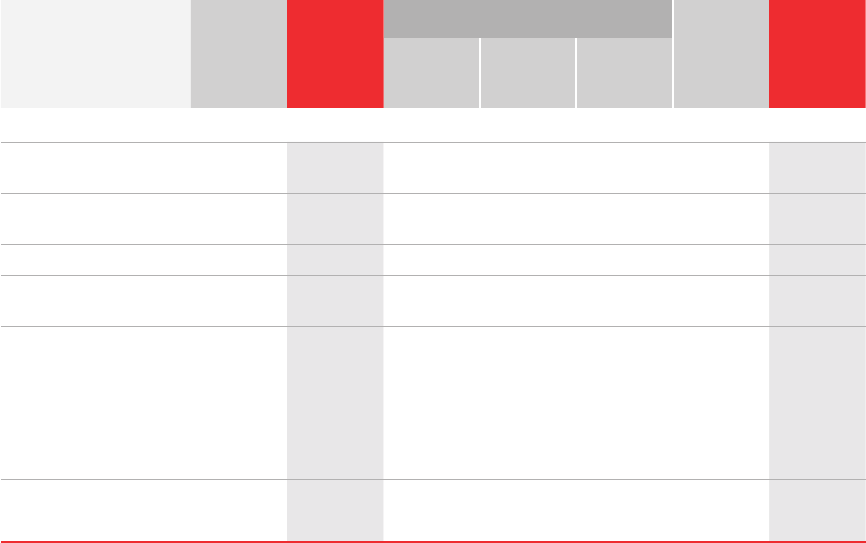
96
Annual Report of Yeti GermanCo 1 GmbH 2020
1
Hierarchy level 2
32. Other Financial Instrument Disclosures
The following table shows the carrying amount and fair values of the individual financial assets and financial
liabilities for each class of financial instruments as of December 31, 2020. It does not contain any information
on the fair value of financial assets and financial liabilities not measured at fair value when carrying amount
is a reasonable approximation of fair value.
Measurement
category in
accordance
with IFRS 9
Carrying
amount as of
Dec. 31,
2020
Measurement in accordance with IFRS 9
Measurement
in accordance
with IFRS 16
Fair value as
of Dec. 31,
2020
Amortized
cost
Fair value
through OCI
Fair value
through profit
or loss
Financial assets
Other Financial
Investments
FVOCI 209 – 209 – – 209
1
Other non-current
receivables and assets
AC 25,375 25,375 – – – 25,375
1
Trade receivables AC 256,792 256,792 – – –
Other current receivables
and other assets
AC 20,748 20,748 – – –
Derivative financial assets
Derivatives without an ef-
fective hedge relationship
FVTPL – – – – – –
Derivatives in an effective
hedge relationship
FVOCI 3,686 – 3,686 – – 3,686
1
Cash and cash
equivalents
AC 410,807 410,807 – – –
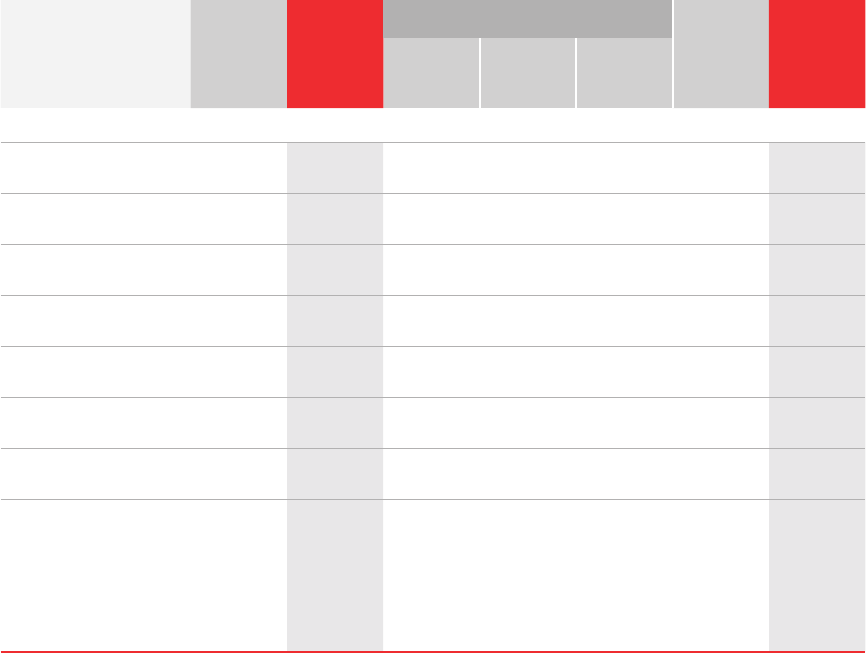
97
Annual Report of Yeti GermanCo 1 GmbH 2020
1
Hierarchy level 2
Measurement
category as
per IFRS 9
Carrying
amount as of
Dec. 31, 2020
Measurement in accordance with IFRS 9
Measurement
in accordance
with IFRS 16
Measure-
ment in
accordance
with IFRS 16
Amortized
cost
Fair value
through OCI
Fair value
through profit
or loss
Financial liabilities
Non-current financial
liabilities
AC 2,262,660 2,262,660 – – – 2,476,453
1
Non-current lease liabi-
lities
n / a 71,081 – – – 71,081
Other non-current liabi-
lities
AC 2,052 2,052 – – – 2,019
1
Current financial liabilities AC 8,358 8,358 – – –
Current lease liabilities n / a 15,017 – – – 15,017
Trade payables AC 148,045 148,045 – – –
Other current liabilities AC 67,578 67,578 – – –
Derivative financial
liabilities
Derivatives without an ef-
fective hedge relationship
FVTPL 266 – – 266 – 266
1
Derivatives in an effective
hedge relationship
FVOCI 15,255 – 15,255 – – 15,255
1
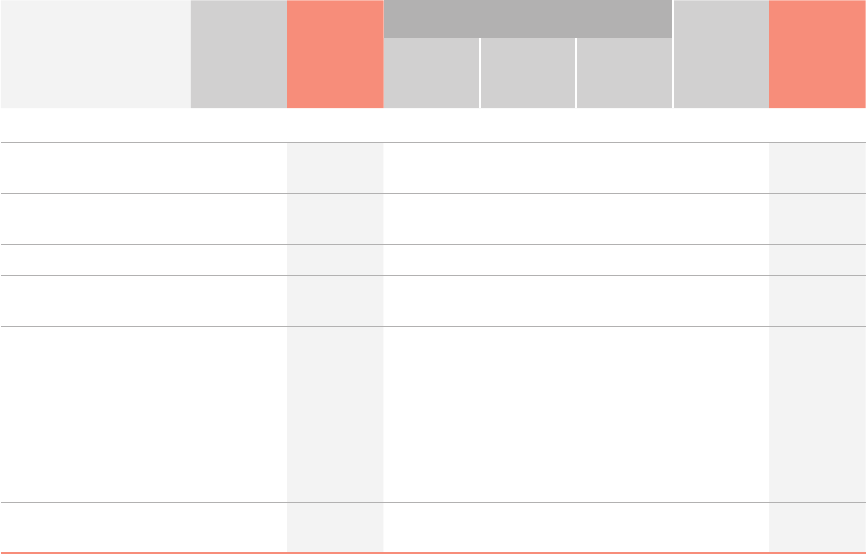
98
Annual Report of Yeti GermanCo 1 GmbH 2020
The following table shows the carrying amounts and fair values for each class of financial instrument in
accordance with IFRS 9 as of December 31, 2019:
1
Hierarchy level 2
Measurement
category as
per IFRS 9
Carrying
amount Dec.
31, 2019
Measurement in accordance with IFRS 9
Measurement
in accordance
with IFRS 16
Fair value as
of Dec. 31,
2019
Amortized
cost
Fair value
through OCI
Fair value
through profit
or loss
Financial assets
Other Financial
Investments
FVOCI 209 – 209 – – 209
1
Other non-current
receivables and assets
AC 37,364 37,364 – – – 37,364
1
Trade receivables AC 276,407 276,407 – – –
Other current receivables
and other assets
AC 37,115 37,115 – – –
Derivative financial assets
Derivatives without an
effective hedge
relationship
FVTPL 109 – – 109 – 109
1
Derivatives in an effective
hedge relationship
FVOCI 5,095 – 5,095 – – 5,095
1
Cash and cash
equivalents
AC 577,422 577,422 – – –
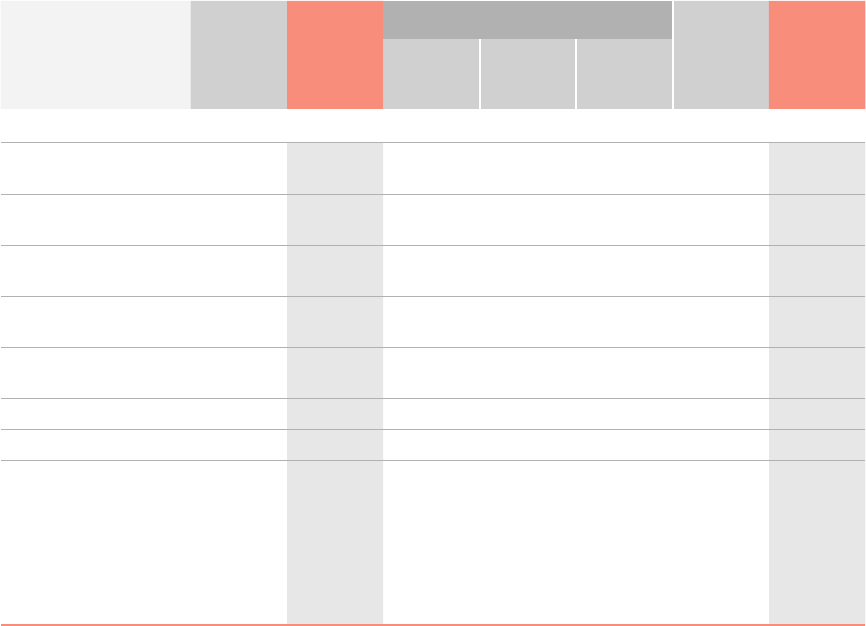
99
Annual Report of Yeti GermanCo 1 GmbH 2020
The Messer Industries Group uses the following hierarchy of inputs to measure fair value:
Level 1: Prices quoted in active markets accessible to the entity for identical assets or liabilities on the
measurement date
Level 2: Inputs other than the quoted prices listed in Level 1 that can be observed either directly or indirectly
for the asset or liability
Level 3: Inputs that are not observable for the asset or liability
Non-consolidated equity investments classified as non-financial items are not measured at fair value.
The fair value measurement of equity investments is based on the market value quoted on the relevant
market.
Non-current receivables and other non-current assets, and non-current financial liabilities and trade payables,
are discounted to present value. For these purposes, the measurement model is based on interest rate
curves and exchange rates for the respective maturities applicable as of the end of the reporting period.
Given their short remaining terms, the carrying amounts of current receivables, trade payables and cash
funds are approximately their fair value. There is no requirement to disclose the fair values of non-financial
items as they are not financial instruments as defined by IFRS 7.
1
Hierarchy level 2
Measurement
category as
per IFRS 9
Carrying
amount Dec.
31, 2019
Measurement in accordance with IFRS 9
Measurement
in accordance
with IFRS 16
Fair value as
of Dec. 31,
2019
Amortized
cost
Fair value
through OCI
Fair value
through profit
or loss
Financial liabilities
Non-current financial
liabilities
AC 2,428,540 2,428,540 – – – 2,475,752
1
Non-current lease
liabilities
n / a 74,194 – – – 74,194
Other non-current
liabilities
AC – – – – –
Current financial
liabilities
AC 8,503 8,503 – – – 8,503
1
Current lease
liabilities
n / a 15,018 – – – 15,018
Trade payables AC 215,231 215,231 – – –
Other current liabilities AC 20,159 20,159 – – –
Derivative financial
liabilities
Derivatives without
an effective hedge
relationship
FVTPL 348 – – 348 – 348
1
Derivatives in an effective
hedge relationship
FVOCI 12,669 – 12,669 – – 12,669
1
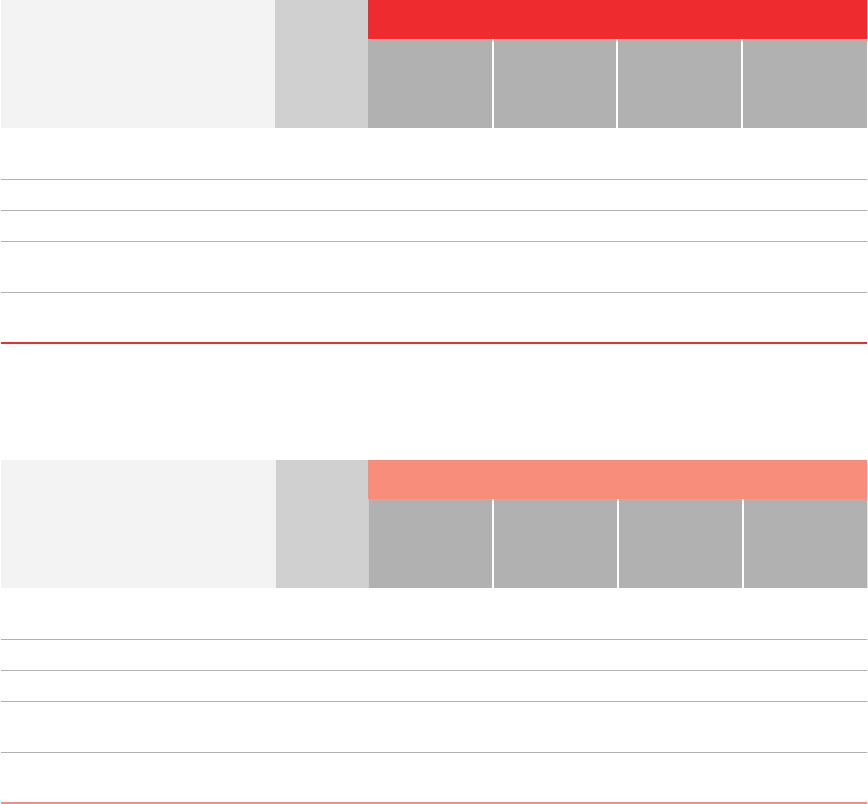
100
Annual Report of Yeti GermanCo 1 GmbH 2020
Net gains and losses on financial instruments include the effects on earnings of financial instruments.
These essentially include gains or losses on remeasurement from currency translation, adjustments to
fair value, impairment losses and their reversals.
The following table shows the effects on earnings of financial instruments by IFRS 9 measurement
category:
The following table shows the effects on earnings of financial instruments by IFRS 9 measurement
category in 2019:
Derivative financial instruments
The Messer Industries Group essentially uses derivative financial instruments to hedge currency and raw
material exposures and variable interest payments in order to reduce the related risks. Foreign currency risks
from posted transactions are largely hedged. The exposure for raw material and currency hedges is derived
from production requirement planning and the future purchases necessary over the hedged period, which are
therefore highly probable. Interest hedges are based on a loan with a floating interest rate. The risk and its
assessment are monitored continuously. The Messer Industries Group currently uses standard currency
forwards, non-deliverable forwards (NDFs), interest derivatives and energy swaps as hedging instruments.
2020 in K€
From
interest
Net gains and net losses
At fair value
Currency
translation
Impairment
losses
From disposals
Financial assets and financial liabilities
at fair value through profit or loss
_ 763 (65) _ _
Financial liabilities at amortized cost (90,711) _ (2,040) _ _
Financial assets at amortized cost 3,766 _ (4,367) (2,861) _
Financial assets at fair value through
OCI
_ (240) _ _ –
Financial liabilities at fair value through
OCI
_ 42 _ _ –
2019 inK€
From
interest
Net gains and net losses
At fair value
Currency
translation
Impairment
losses
From disposals
Financial assets and financial liabilities
at fair value through profit or loss
(1,418) 9,113 (1,029) – –
Financial liabilities at amortized cost (97,916) – 2,627 – 1,322
Financial assets at amortized cost 8,579 – 6,841 (3,848) –
Financial assets at fair value through
OCI
– – – – –
Financial liabilities at fair value through
OCI
280 – – – –
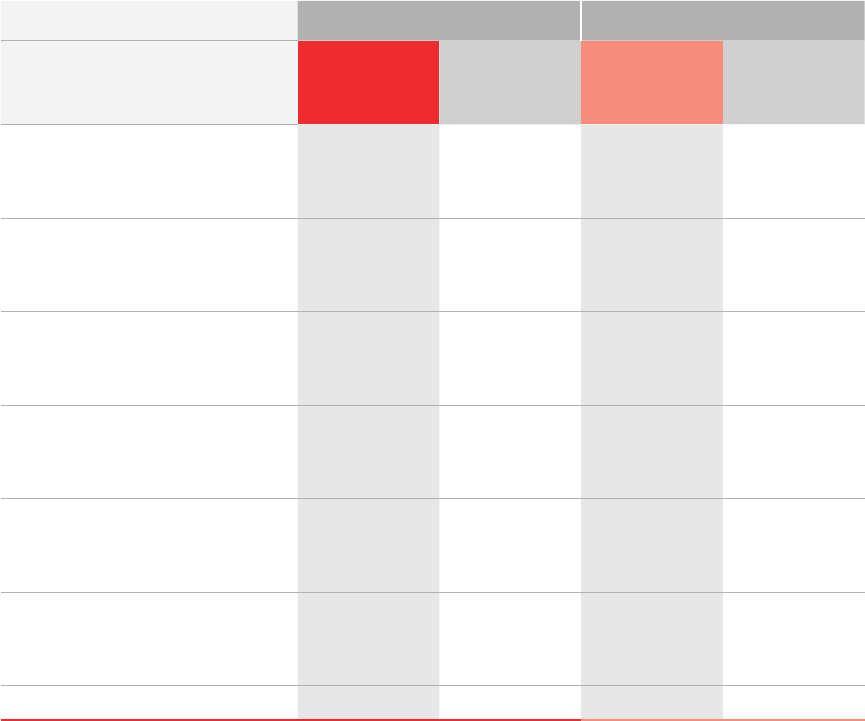
101
Annual Report of Yeti GermanCo 1 GmbH 2020
Hedges are entered into only with partners of good credit standing; any potential ineffectiveness resulting
from them, if material, would be reported separately in profit or loss.
The Group currently uses derivative financial instruments to hedge future payments for energy purchases
in the US and currency hedges for future USD payments from foreign currency liabilities in Canada. It also
uses derivative financial instruments to hedge future variable USD interest payments on the USD loan
(Facility B-1) and variable EUR interest payments on the euro loan (Facility B-2). These hedges are subject to
hedge accounting in accordance with IFRS (cash flow hedges). The average hedge rate for energy purchases
is USD 29.94 (EUR 24.40) per megawatt hour (previous year: USD 30.56 (EUR 27.20)), and USD 1.278 / CAD 1
for currency hedges; the fixed interest rate is 0.46 % and the interest cap is 0.25 %. Furthermore, cash
flows in the currencies USD, EUR, BRL and COP are essentially hedged outside hedge accounting, using
currency forwards and NDFs.
There are currently no derivative financial instruments in the Group that qualify as fair value hedges or hedges
of a net investment in foreign operations.
Furthermore, hedges are entered into outside hedge accounting. These hedges nevertheless comply with
the principles of risk management from an economic perspective.
Assets
Dec. 31, 2020 Dec. 31, 2019
Financial derivatives in K€
Fair value
(carrying amount)
Nominal
amount
Fair value
(carrying amount)
Nominal
amount
Currency swaps
without a hedging relationship – – – –
as a cash flow hedge – – 1,158 3,999
Currency forwards
without a hedging relationship 0 140 – 25
as a cash flow hedge – – – –
Energy swaps
without a hedging relationship – – – –
as a cash flow hedge 3,151 15,924 3,937 16,213
Gas swaps
without a hedging relationship – – – –
as a cash flow hedge – – – –
Interest derivatives
without a hedging relationship – – – –
as a cash flow hedge 535 432,000 – –
Other transactions
without a hedging relationship – – 109 22,831
as a cash flow hedge – – – –
Total 3,686 448,064 5,204 43,068
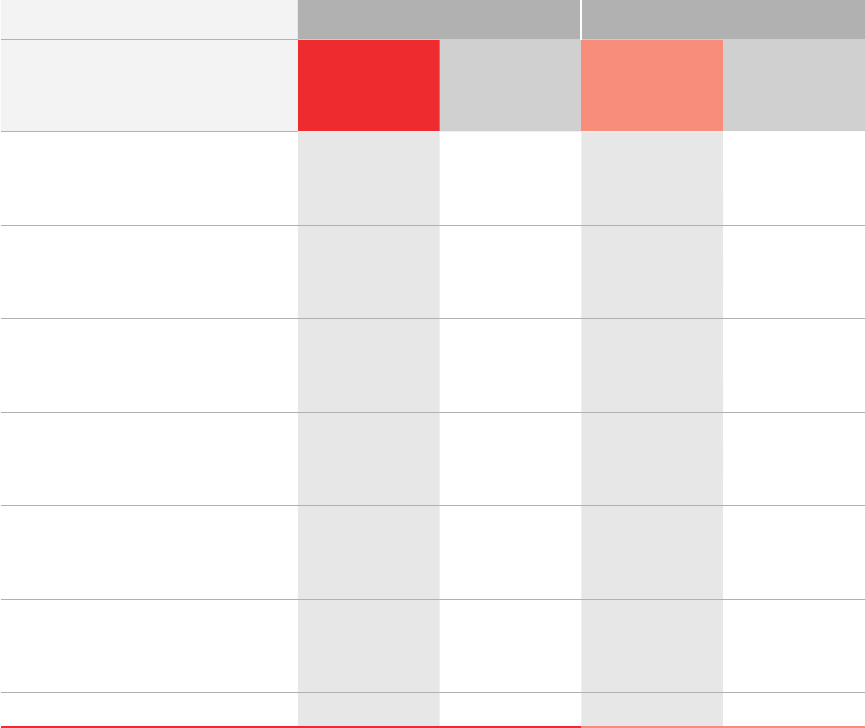
102
Annual Report of Yeti GermanCo 1 GmbH 2020
The nominal volume of derivative financial instruments consists of the total nominal amounts of the individual
contracts. By contrast, the fair value is calculated from the measurement of all contracts at prices on the
measurement date. It shows how the result would have changed if the derivative contracts had been closed
immediately as of the end of the reporting period.
The effective portion of the changes in the value of derivative financial instruments, which was recognized
in the OCI in the reporting period, is K€ 14,113 (previous year: K€ 13,863). The amount that was reclassified
from equity to the income statement in the context of hedge accounting in the reporting period is K€ 9,948
(previous year: K€ 4,496) and is essentially shown in cost of sales. The ineffective portion of the change in
market value is recognized directly in profit or loss.
No significant ineffective portions of the change in the fair value of hedging instruments were identified in
the fiscal year.
Liabilities
Dec. 31, 2020 Dec. 31, 2019
Financial derivatives in K€
Fair value
(carrying amount)
Nominal
amount
Fair value
(carrying amount)
Nominal
amount
Currency swaps
without a hedging relationship – – – –
as a cash flow hedge – – 259 10,845
Currency forwards
without a hedging relationship 36 986 132 5,509
as a cash flow hedge 820 17,170 – –
Energy swaps
without a hedging relationship – – – –
as a cash flow hedge 8,553 53,141 12,410 71,775
Gas swaps
without a hedging relationship – – 144 631
as a cash flow hedge – – – –
Interest derivatives
without a hedging relationship – – – –
as a cash flow hedge 5,882 1,441,203 – –
Other transactions
without a hedging relationship 230 11,690 72 19,930
as a cash flow hedge – – – –
Total 15,521 1,524,190 13,017 108,690
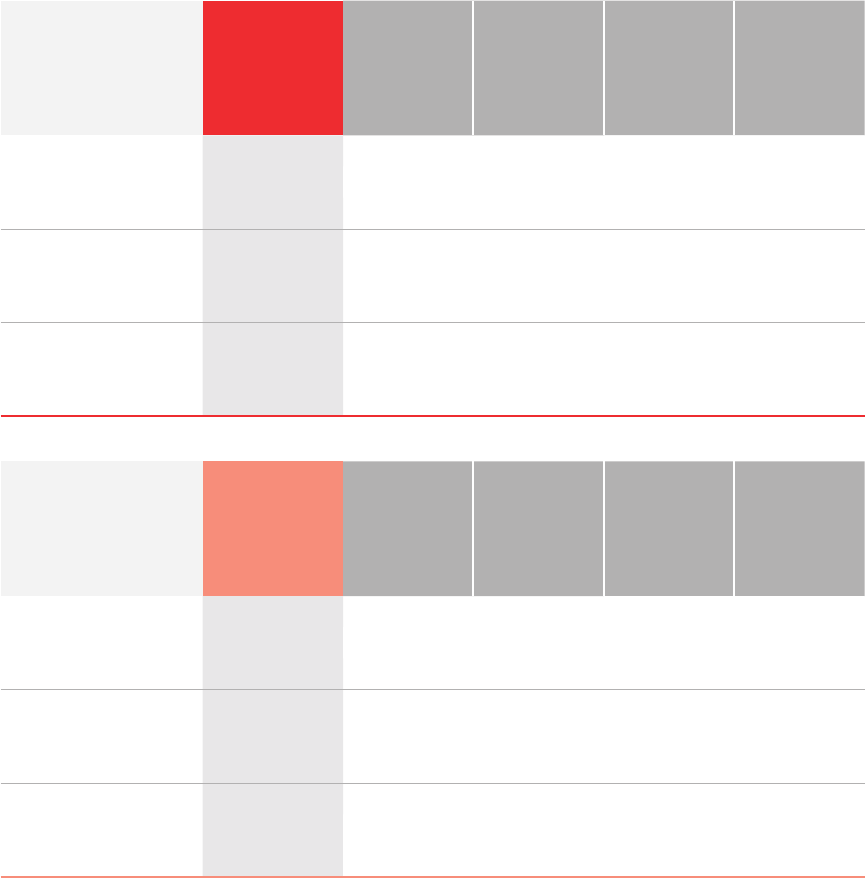
103
Annual Report of Yeti GermanCo 1 GmbH 2020
The following table shows when the cash flows from cash flow hedges occur and how they affect fair value
in the income statement:
The Messer Industries Group uses derivatives in accordance with the International Swaps and Derivative
Association (ISDA) Agreement. This agreement does not meet the criteria for offsetting in the consolidated
statement of financial position, as it only provides for offsetting rights for future events, such as default or
insolvency of the Group or counterparty. The following table shows the potential financial impact of offset-
ting the agreement described, regardless of whether the items are offset in the consolidated statement of
financial position in accordance with IAS 32.42.
in K€
Fair value
(carrying amount)
December 31,
2020
Nominal
amount
up to 1 year 1 to 5 years
more than
5 years
Currency swaps
Assets – – – – –
Liabilities (820) 17,170 17,170 – –
Energy swaps
Assets 3,151 15,924 1,229 14,695 –
Liabilities (8,553) 53,141 22,914 30,227 –
Interest derivatives
Assets 535 432,000 – 432,000 –
Liabilities (5,882) 1,441,203 18,132 1,423,071 –
in K€
Fair value
(carrying amount)
December 31,
2019
Nominal
amount
up to 1 year 1 to 5 years
more than
5 years
Currency swaps
Assets 1,158 3,999 3,999 – –
Liabilities (259) 10,845 10,845 – –
Energy swaps
Assets 3,937 16,213 1,931 14,282 –
Liabilities (12,410) 71,775 25,067 46,708 –
Interest derivatives
Assets – – – – –
Liabilities – – – – –

104
Annual Report of Yeti GermanCo 1 GmbH 2020
Management of financial risks
In conjunction with its operating activities, the Messer Industries Group is exposed to various financial
risks, in particular credit, liquidity, interest and currency risk, which are described in more detail below. The
Group’s risk management system takes into account the fact that financial market developments are not
foreseeable and is intended to minimize any potential negative impact on the Group’s financial position. The
Group uses derivative financial instruments to hedge against specific risks.
Risk management is handled by Group Treasury in compliance with guidelines approved by management.
Group Treasury identifies, assesses and hedges financial risks. The guidelines contain general principles for
risk management and detailed rules for specific areas, such as currency and interest rate risks, the use of
derivative financial instruments and the investment of surplus cash. Further information on risk management
can be found in the risk report section of the Group management report.
Credit risk
Credit risk is the risk of financial losses if customers or the counterparty to a financial instrument do not
meet their contractual obligations.
There are no impairment losses for other financial assets and financial investments such as bank balances,
securities and derivatives that are assets, as the credit risk is classified as remote. Such risks are limited
by Group Treasury by selecting counterparties of good credit standing and by limiting the investment
amounts.
Credit risk in the Messer Industries Group mainly arises from trade receivables.
The corresponding impairment loss is measured at an amount equal to lifetime expected credit losses,
based on an analysis of historical default data and forecasts of future economic conditions. Expected
credit losses are a probability-weighted estimate of credit losses.
Credit risk in the Messer Industries Group is primarily influenced by customers’ individual characteristics.
For risk management purposes, the credit rating of each customer is first analyzed individually before the
respective Group company offers its standard delivery and payment terms. Where available, the analysis
comprises annual financial statements, information from credit agencies, sector information and, in some
cases, credit reports from banks. Specific limits are set individually for each customer. These represent the
maximum outstanding amount that can be granted without the approval of the Risk Management Committee.
The limits are reviewed at least once a quarter.
in K€
Dec. 31, 2020 Dec. 31, 2019
Gross amounts
of derivatives
in the
consolidated
statement of
financial position
Amounts
from netting
agreements
Net
amounts
Gross amounts of
derivatives in the
consolidated
statement of
financial position
Amounts
from netting
agreements
Net
amounts
Derivative assets – – – 109 (37) 72
Derivative liabilities – – – 72 37 109
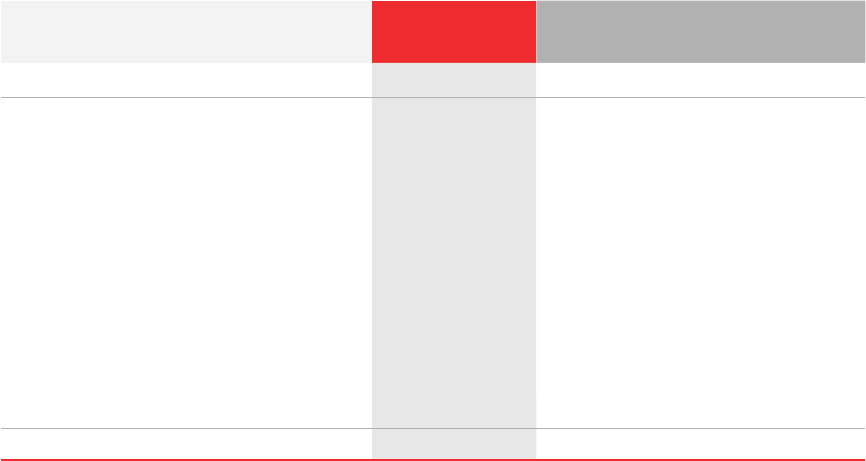
105
Annual Report of Yeti GermanCo 1 GmbH 2020
Due regard is also given to whether the customer is a natural person or a legal entity. Other factors taken
into account are geographical location, market sector, the aging structure of receivables and the occurrence
and duration of payment problems.
The expected credit loss over the total term of the respective receivables is taken into account in the
measurement of the receivables. The Messer Industries Group uses the simplified impairment model for
this.
In order to assess the expected credit risk, receivables are grouped on the basis of the existing credit risk
and maturity structure of the receivables concerned. Customers are also divided into groups to monitor the
risk of default. The groups with comparable credit risks to be taken into account for the Messer Industries
Group result from the business areas and registered office of the respective customers.
If there is objective evidence that the forecast future inflows are impaired, a receivable is classified as
impaired. Examples of such evidence include impending insolvency or breach of contract due to default.
Default occurs if it is unlikely that a debtor will be able to settle its liabilities in full.
Each company in the Messer Industries Group therefore performs an analysis to determine whether there
are objective indications of impairment for customers whose receivables are past due by a certain number
of days, indicating an increased credit risk. At the latest, there is an increased credit risk when the amount
of the receivable past due is higher than the average turnover. This can vary between 90 and 270 days
depending on the company.
The following table provides information on the estimated credit risk and the expected credit losses for non-
current and current trade receivables as of December 31, 2020, calculated in accordance with the default
event:
Receivables
Default rate,
in percent
Expected credit loss
Individually impaired 55,193 45.4 25,058
Collectively impaired in accordance with
default event
Days past due:
Not past due 180,114 1. 6 2,811
between 1 and 30 days 31,849 3.2 1,011
between 31 and 60 days 9,003 8.5 762
between 61 and 90 days 3,546 1 7. 7 627
between 91 and 120 days 2,958 42.5 1,256
between 121 and 180 days 2,162 26.0 563
between 181 and 270 days 2,626 32.6 857
more than 271 days 4,779 52.0 2,483
292,230 35,428
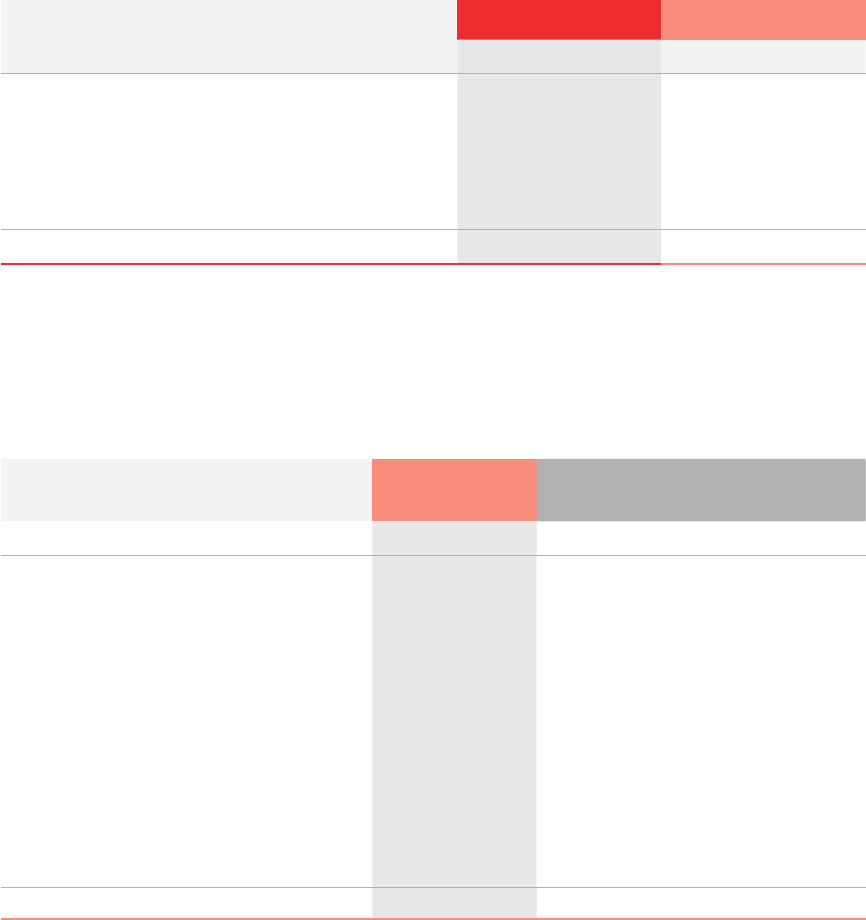
106
Annual Report of Yeti GermanCo 1 GmbH 2020
Impairment losses on non-current and current trade receivables developed as follows:
The impairment loss relates to trade receivables and was calculated exclusively on the basis of lifetime
expected credit losses.
Liquidity risk
Liquidity risk, i.e. the risk that the Messer Industries Group cannot meet its financial obligations, is limited
both by creating the necessary financial flexibility and by effective cash management. In addition to cash
funds, the Messer Industries Group also has access to long-term, freely available credit facilities to safe -
guard its liquidity. There are no indications that any of the credit facilities granted are not fully available.
Liquidity risks are monitored regularly and reported to management, in particular regarding compliance with
the financial covenants described in note 27 “Financial Liabilities”.
The following table provides information on the estimated credit risk and the expected credit losses for
non-current and current trade receivables as of December 31, 2019:
2020 2019
As of Jan. 1 38,347 –
Additional impairment requirement as of January 1, 2020 – –
Net change through profit or loss 2,861 4,026
Net change through OCI (1,834) (39)
Change in group reporting – 34,539
Exchange rate changes (3,946) (179)
As of Dec. 31 35,428 38,347
Receivables
Default rate,
in percent
Expected credit loss
Individually impaired 56,880 36.1 20,507
Collectively impaired in accordance with
default event
Days past due:
Not past due 175,745 2.1 3,735
between 1 and 30 days 42,528 4.9 2,074
between 31 and 60 days 12,164 12.4 1,510
between 61 and 90 days 5,421 23.0 1,245
between 91 and 120 days 3,354 33.6 1,126
between 121 and 180 days 3,786 29.6 1,119
between 181 and 270 days 4,522 39.8 1,799
more than 271 days 10,636 49.2 5,232
315,036 38,347
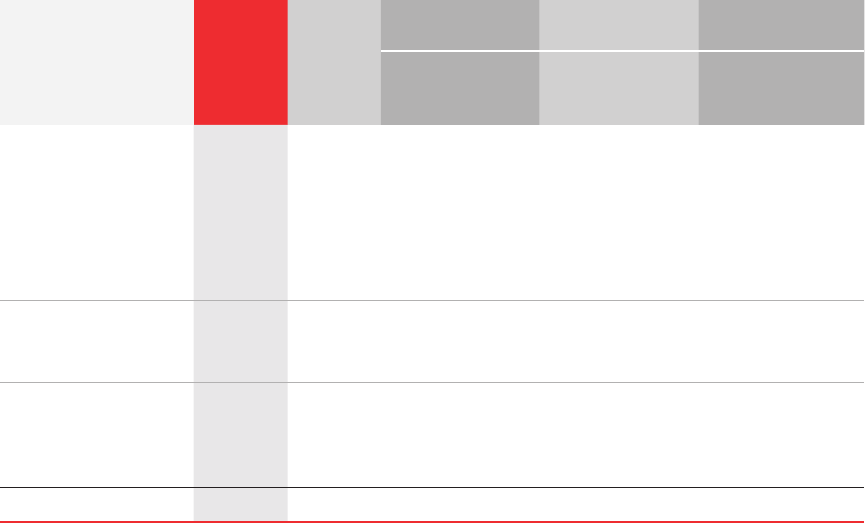
107
Annual Report of Yeti GermanCo 1 GmbH 2020
Trade payables and other current liabilities have remaining terms of less than one year. Information relating
to the maturities of financial liabilities can be found in note 27 “Financial Liabilities”. Other non-current
liabilities have remaining terms of between one and five years.
The following table shows the expected cash flows for financial liabilities:
This includes all instruments that were in the portfolio on December 31, 2020 and for which payments
were already contractually agreed. Forecast figures for future new liabilities are not included. Foreign
currency amounts were translated using the rate as of December 31, 2020.
Description
Carrying
amount
Dec. 31,
2020
Expected
cash flow
Cash Flows
2021
Cash Flows
2022 - 2025
Cash Flows
from 2026
Interest
Payment
of
principal
Interest
Payment
of
principal
Interest
Payment
of
principal
Financial liabilities at
amortized cost
2,488,693 (2,862,376) (62,914) (234,541) (246,451) (77,304) (10,004) (2,231,162)
Financial liabilities
1
2,271,018 (2,644,701) (62,914) (18,918) (246,451) (75,252) (10,004) (2,231,162)
Other non-current liabilities
2,052 (2,052) – – – (2,052) – –
Trade payables
148,045 (148,045) – (148,045) – – – –
Other current liabilities
67,578 (67,578) – (67,578) – – – –
Financial liabilities at fair
value through OCI
15,255 (15,255) – (4,645) (5,883) (4,727) – –
Financial derivatives
2
15,255 (15,255) – (4,645) (5,883) (4,727) – –
Financial liabilities at
fair value through profit
or loss
266 (266) – (266) – – – –
Financial derivatives
2
266 (266) – (266) – – – –
Lease liabilities
86,098 (114,650) (4,609) (15,017) (12,774) (36,085) (11,169) (34,996)
1
The transaction costs for financing were already reported as cash outflows and are therefore not a component of future cash flows.
2
Repayments of principal for financial derivatives are contractual cash flows.
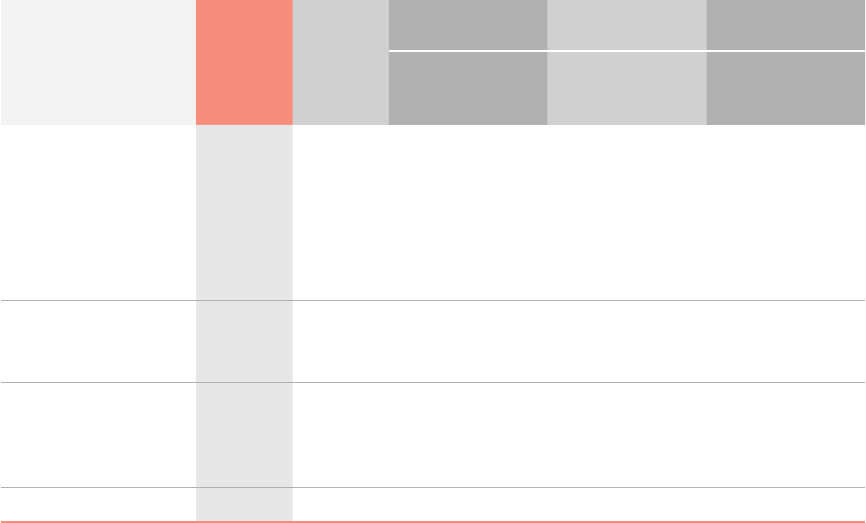
108
Annual Report of Yeti GermanCo 1 GmbH 2020
Interest risk
Interest risk can arise when interest-bearing liabilities are not hedged in terms of maturity or amount by
either corresponding assets or derivative instruments. The objective is to optimize the net interest result and
minimize interest risks. The Company has hedged 81.4 % of its total financial liabilities against interest rate
changes through fixed interest rate agreements.
Variable financial instruments are subject to a cash flow risk with regard to the uncertainty of future interest
payments. The cash flow risk is measured using a sensitivity analysis. The sensitivity analysis assumes a
shift in the yield curves for all currencies by +/- 100 basis points as of December 31, 2020.
The change in interest rate derivatives is recognized in profit or loss using the current market interest at the
end of the reporting period. If market interest rates had been 100 basis points higher (lower) as of December
31, 2020, consolidated net profit would have been K€ 43,935 (previous year: K€ 0) higher or K€ 13,448
(previous year: K€ 0) lower.
For variable financial liabilities and our financial investments, an interest rate level 100 basis points higher
(lower) as of December 31, 2020 would have produced a result lower (higher) by K€ 375 (previous year:
K€ 19,283). As of December 31, 2020, the exposure to interest rate risk was K€ 37,477 (previous year:
K€ 1,928,318).
Description
Carrying
amount Dec.
31, 2019
Expected
cash flow
Cash Flows
2020
Cash Flows
2021 - 2024
Cash Flows
from 2025
Interest
Payment
of
principal
Interest
Payment
of
principal
Interest
Payment
of
principal
Financial liabilities at
amortized cost
2,672,433 (3,352,156) (101,323) (255,219) (396,445) (80,042) (112,417) (2,406,710)
Financial liabilities
1
2,437,043 (3,116,766) (101,323) (19,829) (396,445) (80,042) (112,417) (2,406,710)
Other non-current liabilities
– – – – – – – –
Trade payables
215,231 (215,231) – (215,231) – – – –
Other current liabilities
20,159 (20,159) – (20,159) – – –
Financial liabilities at fair
value through OCI
12,669 (12,669) – (8,306) – (4,363) – –
Financial derivatives
2
12,669 (12,669) – (8,306) – (4,363) – –
Financial liabilities at
fair value through profit
or loss
348 (348) – (348) – – – –
Financial derivatives
2
348 (348) – (348) – – – –
Lease liabilities
89,212 (119,714) (4,600) (15,018) (12,926) (36,837) (12,976) (37,357)
1
The transaction costs for financing were already reported as cash outflows and are therefore not a component of future cash flows.
2
Repayments of principal for financial derivatives are contractual cash flows.
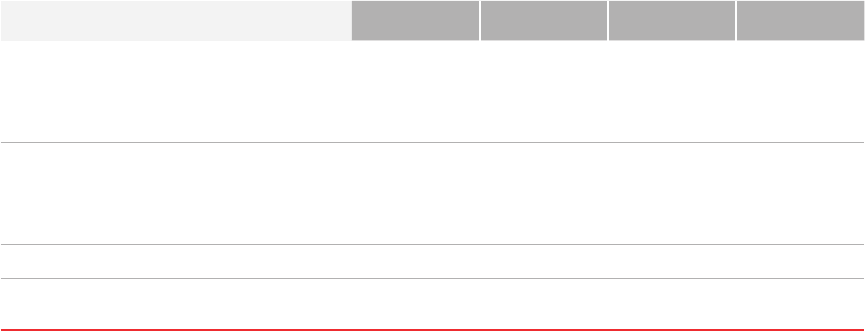
109
Annual Report of Yeti GermanCo 1 GmbH 2020
Currency risk
Currency risk for the Messer Industries Group arises from both financing and operating activities in an
international environment. Foreign currency risks are hedged to the extent that they have a significant
influence on the Group’s cash flows.
Foreign currency risks relating to financing activities result from foreign currency financial liabilities and loans
for the financing of Group companies. Group Treasury hedges these risks. Currency derivatives are used to
convert financial obligations and intragroup loans denominated in foreign currencies into the functional
currency of the Group companies.
As far as operating activities are concerned, the individual Group companies predominantly conduct their
business in their own functional currency. The Messer Industries Group’s currency risk from operating
activities is therefore considered remote overall. However, a number of Group companies are exposed to
foreign currency risks in connection with operational transactions not denominated in their own functional
currency. This mainly relates to payments in conjunction with a long-term supply agreement and payments
in conjunction with investments. The Messer Industries Group also uses currency derivatives to hedge
these risks.
Currency risks as referred to by IFRS 7 result from financial instruments that are denominated in a currency
other than the functional currency and that are monetary in nature; exchange rate differences arising from
the translation of financial statements into the Group currency are not taken into account.
Currency risk is measured on the basis of sensitivity analyses. The currency analysis assumes an appreciation
(depreciation) of all currencies by 10 % compared to the euro.
If the euro appreciates (depreciates) by 10 % against the major currencies, this would produce a hypotheti-
cal result K€ 21,250 lower (higher) (previous year: K€ 21,458 lower). The net currency risk from statement
of financial position exposures was as follows:
in K€ as of Dec. 31, 2020
USD CAD CHF BRL
Foreign currency risk from statement
of financial position exposures
49,838 254,901 (216)
(1,279)
Foreign currency risk from
forecast transactions
(84,085) (1,343) (5,500)
(13,912)
Transactional foreign
currency exposures
(34,247) 253,558 (5,716)
(15,191)
Exposures hedged in economic
terms by derivatives
14,098 – – –
Unhedged foreign currency exposures (20,149) 253,557 (5,716)
(15,192)
Change in foreign currency exposures as a result
of a 10 % appreciation of the euro
2,015 (25,356) 572
1,519
110
Annual Report of Yeti GermanCo 1 GmbH 2020
33. Related Parties
Transactions with the following entities and individuals are treated as related party transactions.
Related companies
The ultimate company with significant influence is Messer Industrie GmbH, which is controlled by the
Messer family. Associated companies, joint ventures and joint operations and non-consolidated subsidiaries
classified as related parties are shown in the list of shareholdings.
The following companies are considered related parties:
• CVC Capital Partners VII (A) L.P., UK
CVC Capital Partners VII (A) L.P. holds 94.51 % in Yeti Holdings Jersey Limited, USA, as of
December 31, 2020.
• Greenbelt Ltd., British Virgin Islands, and Hardtberg Grundstücks GmbH
Stefan Messer, Managing Director and co-shareholder of Messer Industrie GmbH, is also a Managing
Director and co-shareholder or sole shareholder of these companies.
• Messer Group GmbH (Messer Group)
Messer Group GmbH holds 54.46 % in Yeti GermanCo 1 GmbH and 58.02 % in Yeti Warehouse GmbH
(formerly: Messer Family NewCo GmbH) as of December 31, 2020.
• Messer Management SE
Messer Management SE is the general partner (SE) of the future Messer SE & Co. KGaA. Please refer to
the comments under note 34 “Events after the Reporting Period”.
• Messer Holding GmbH
Messer Holding GmbH holds 100 % in Messer Group GmbH as of December 31, 2020.
• Messer Industrie GmbH
Messer Industrie GmbH holds 100 % in Messer Holding GmbH as of December 31, 2020.
• Messer Medical Home Care Holding GmbH (Home Care Group)
The Messer Group has spun off its home care activities into an independent group since March 31, 2011.
The parent company of this Group, Messer Medical Home Care Holding GmbH, is wholly owned by MIG
Holding GmbH, an affiliate of Messer Industrie GmbH.
• MIG Holding GmbH and Messer Eutectic Castolin Gruppe (MEC Group)
100 % of the shares in MEC Global GmbH are held by MIG Holding GmbH, an affiliate of Messer
Industrie GmbH with the same ownership structure.
• Yeti Americas Management Participation GmbH & Co. KG
Yeti Americas Management Participation GmbH & Co. KG holds 4.21 % in Yeti GermanCo 1 GmbH as of
December 31, 2020.
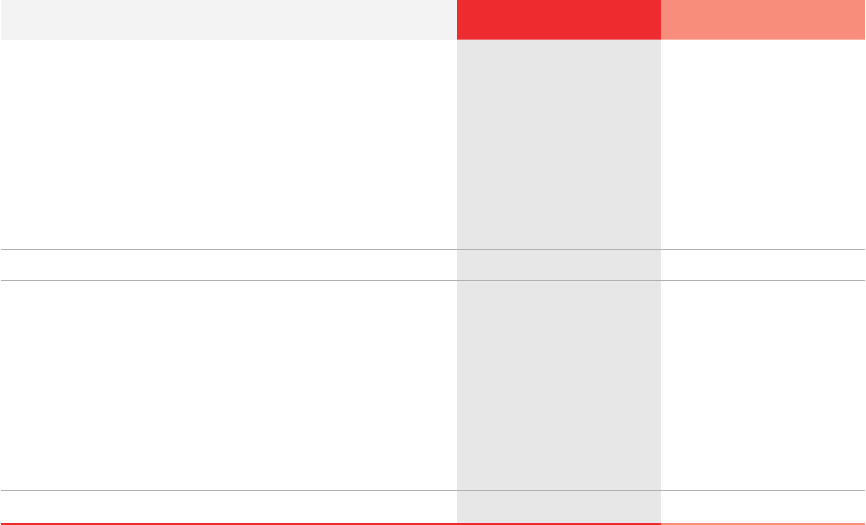
111
Annual Report of Yeti GermanCo 1 GmbH 2020
• YetiEurope Management Participation GmbH & Co. KG
Yeti Europe Management Participation GmbH & Co. KG holds as 1.98 % in Yeti GermanCo 1 GmbH as of
December 31, 2020.
• Yeti Holdings Jersey Limited, Jersey
Yeti Holdings Jersey Limited holds 100 % in Yeti Holdings S.à.r.l., Luxembourg, as of
December 31, 2020.
• Yeti Holdings S.à r.l., Luxembourg
Yeti Holdings S.à.r.l., Luxembourg holds 100 % in Yeti Investments S.à.r.l., Luxembourg, as of
December 31, 2020.
• Yeti Investments S.à.r.l., Luxembourg
Yeti Investments S.à.r.l. holds 41.95 % in Yeti Warehouse GmbH (formerly: Messer Family NewCo GmbH)
and 39.35 % in Yeti GermanCo 1 GmbH as of December 31, 2020.
• Yeti Management Verwaltungs GmbH (formerly: Yeti NewCo 0 GmbH)
Yeti Management Verwaltungs GmbH is the general partner (GmbH) of Yeti Americas Management
Participation GmbH & Co. KG and Yeti Europe Management Participation GmbH & Co. KG as of
December 31, 2020.
• Yeti Warehouse GmbH (formerly: Messer Family NewCo GmbH)
Yeti Warehouse GmbH holds 100 % in Yeti Management Verwaltungs GmbH as of December 31, 2020.
The Yeti GermanCo 1 GmbH Employee Participation Program is bundled in Yeti Warehouse GmbH.
The following transactions were performed with related companies:
Jan. 1 - Dec. 31, 2020 Jan. 1 - Dec. 31, 2019
Revenue with related parties
Ultimate controlling party – –
Parent company 1,809 135
Associated companies,
joint ventures and joint operations
20 11
Non-consolidated subsidiaries – –
Other related parties 4,414 3,095
6,243 3,241
Purchased goods and services
Ultimate controlling party – –
Parent company 9,325 6,772
Associated companies,
joint ventures and joint operations
4,955 2,583
Non-consolidated subsidiaries – –
Other related parties 9,135 9,702
23,415 19,057
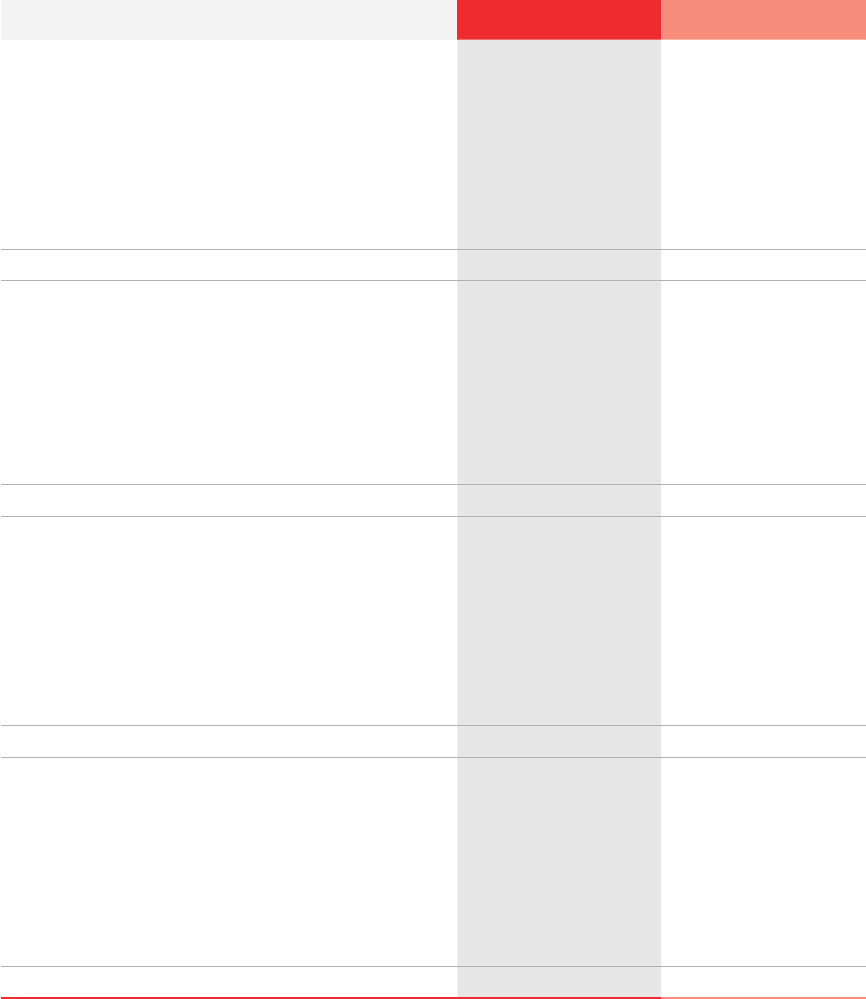
112
Annual Report of Yeti GermanCo 1 GmbH 2020
The receivables from related parties result from service agreements and sales transactions with varying
maturities. The receivables are not secured by collateral and do not bear interest. There were no impairment
losses on receivables from related parties (previous year: K€ 0) and no uncollectible receivables from related
parties recognized as an expense for the period (previous year: K€ 0). No loans were granted to related
companies or were extended by them to the Messer Industries Group.
Dec. 31, 2020 Dec. 31, 2019
Trade receivables
Ultimate controlling party – –
Parent company 354 172
Associated companies,
joint ventures and joint operations
49 60
Non-consolidated subsidiaries – –
Other related parties 673 908
1,076 1,140
Other financial and non-financial assets
Ultimate controlling party – –
Parent company 190 161
Associated companies,
joint ventures and joint operations
5,023 4,379
Non-consolidated subsidiaries 100 96
Other related parties 52 95
5,365 4,731
Trade payables
Ultimate controlling party – –
Parent company 1,957 1,252
Associated companies,
joint ventures and joint operations
506 309
Non-consolidated subsidiaries – –
Other related parties 960 3,165
3,423 4,726
Other financial and non-financial liabilities
Ultimate controlling party – –
Parent company 7 532
Associated companies,
joint ventures and joint operations
49 –
Non-consolidated subsidiaries – –
Other related parties 4 –
60 532
113
Annual Report of Yeti GermanCo 1 GmbH 2020
Related persons
Members of management in key positions
Management in key positions at Yeti GermanCo 1 GmbH included the following in the fiscal year:
• Carsten Knecht, Managing Director of Yeti GermanCo 1 GmbH
• Michael Beck, Managing Director of Yeti GermanCo 1 GmbH (until May 31, 2020)
• Matthias Störmer, Managing Director of Yeti GermanCo 1 GmbH (from May 11 until September 24, 2020)
• Jan Desmeth, Managing Director of Messer Belgium N.V., Belgium (until December 31, 2020)
• Jens Lühring, CEO of Messer Industries USA, Inc., USA
• Gareth Parkin, CFO of Messer Industries USA, Inc., USA
The total remuneration of the members of management in key positions at Yeti GermanCo 1 GmbH
amounted to K€ 3,025 in the fiscal year (previous year: K€ 2,937).
Of this figure, fixed remuneration including benefits in kind and other fringe benefits amounted to K€ 1,351
(previous year: K€ 1,142). The total amount of variable remuneration was to K€ 1,433 (previous year:
K€ 1,557) and is linked to the achievement of certain performance indicators. Post-employment benefits
amount to K€ 241 (previous year: K€ 238).
Yeti GermanCo 1 GmbH Employee Participation Program
For persons in key positions and other senior employees of the Group and Messer Group GmbH, a
management participation program was created in the form of management investment companies as a
shareholder of Yeti GermanCo 1 GmbH. The management participation program enables management and
other executives to invest in the Messer Industries Group and, in the event of an exit by the current main
shareholders (through sale or IPO), to participate in the expected increase in value. The management
participation program gives participants the opportunity to indirectly acquire shares in Yeti GermanCo 1
GmbH through a predetermined structure. These investments participate indirectly in the returns and
performance of a particular geographically defined business unit consisting of basic residual amounts and
preference interest-bearing equity instruments (VSLs). These instruments bear defined interest on the
capital invested and must be served before the residual amounts.
As the companies of Messer Industries Group are not required to settled share-based payments themselves,
this constitutes equity-settled share-based payment in accordance with IFRS 2.43B (b).
The purchase prices for the transfer of shares to the participants of the management participation program
were determined as of March 1, 2019, taking into account the value of the contribution by Messer Group
GmbH and CVC Capital Partners Fund VII.
The participants can only sell the shares they have acquired to Yeti Warehouse GmbH (formerly Messer
Family NewCo GmbH). If a participant leaves, Yeti Warehouse GmbH is entitled to repurchase his shares.
In the event of an early sale of shares or if a participant leaves the Yeti GermanCo 1 Group as a good leaver,
participants receive a formula-based market value of the shares for a contractually determined portion of the
portfolio, which is vested up to the date they leave. For the non-vested portion, good leavers receive the
lower amount of the formula-based market value and the purchase price less refunds since received. Five
years after the specified date of entry, the good leaver receives 100% of the market value of the respective
portfolio on leaving. In the event of leaving as a bad leaver, the employee receives the lower of the formula-
based market value and the purchase price.
114
Annual Report of Yeti GermanCo 1 GmbH 2020
The program stipulates that, after a defined exit event (which can include an IPO or a similar transaction in
which all or substantially all the Group’s assets are disposed of so that current investors retain less than
50 % of the shares), the proceeds of the sale, after deduction of the costs, are used to serve the instruments
described (first the VSLs and then the residual amounts), taking the intended interest into account. The
investors are required to cooperate in the exit event and to participate in the proceeds of the sale in
proportion to the portfolio they hold.
In order to determine the expense for the period as referred to by IFRS 2, the purchase prices to be paid by
the participants were compared against the fair values of the share classes at the respective date of entry
(date of grant). If this shows that the employees acquired the shares at a value lower than the fair value, the
fair value of the benefit granted to the employee from the time the instrument was granted is calculated as
the difference. As the purchase prices to be paid were equal to the fair value as of the grant date, there was
no difference that would have been recognized as the “grant date fair value”.
Advisory Board
• Dr. Hans-Gerd Wienands-Adelsbach, Chairman, Lawyer
• Ernst Bode, COOEurope Messer Group GmbH
• Stefan Messer, CEO Messer Group GmbH
• Dr. Alexander Dibelius, Managing Partner CVC Capital Partners, UK
• Dr. Daniel Pindur, Partner CVC Capital Partners, UK
• Lars Haegg, Principal CVC Capital Partners, UK
The Advisory Board received no remuneration from Group companies of Yeti GermanCo 1 GmbH for the
fiscal year.
34. Events after the Reporting Period
Messer Group GmbH, which founded Yeti GermanCo 1 GmbH as a joint venture with CVC, will transform
into a Kommanditgesellschaft auf Aktien (KGaA – partnership limited by shares) and, in the future, will
operate as Messer SE & Co. KGaA. The transformation will take legal effect on entry in the commercial
register, which had not yet occurred as of the date that these financial statements were prepared. The
legal form of a partnership limited by shares will establish Messer as a globally positioned group of
companies with more extensive options and opportunities for the future. The 100 % control and influen-
ce of the shareholder family is still assured.
On March 23, 2021, it was resolved to repay long-term financial liabilities ahead of schedule. In light of
this, EUR 125 million of facility B-2 was repaid early on March 31, 2021. USD 50 million of the USD-deno-
minated facility B-1 was repaid early as of March 31, 2021. The resolution intends to use between € 100
and € 125 million of freely available cash funds for early repayments over the course of the year.
There were no other reportable events of particular significance to the financial position and financial
performance of the Group after December 31, 2020.
115
Annual Report of Yeti GermanCo 1 GmbH 2020
35. Prior-Year Financial Statements
The financial statements for the previous year as of December 31, 2019 were approved by the Advisory
Board on April 17, 2020 and published in the German Federal Gazette.
36. Auditors’ Fees
The fees of the auditor of the German Group companies were exclusively for audits of financial statements
and amounted to K€ 379 in fiscal 2020 (previous year: K€ 634).
Bad Soden am Taunus, April 9, 2021
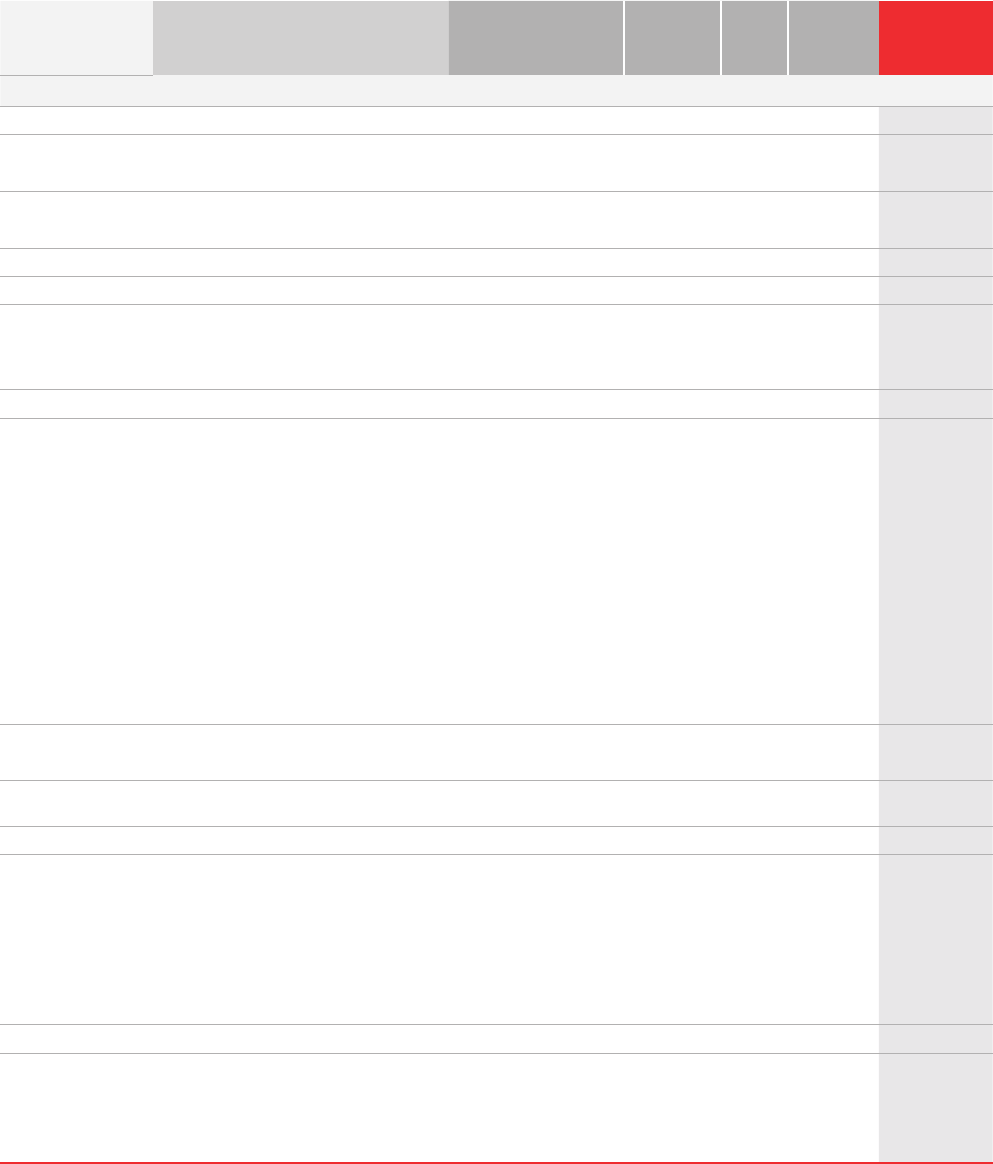
116
Annual Report of Yeti GermanCo 1 GmbH 2020
Appendix
List of shareholdings as of December, 31 2020
Country
Name Domicile
Equity
(in €
thousands)
Direct /
Indirect
Shareholding
in %
Net result after
taxes
(in € thousands)
Affiliated companies included in the consolidated financial statements
Algeria Messer Algérie SPA Alger 3,213 I 59.86 2,133
Belgium bECO2 B.V.B.A. Zwijndrecht 116 I 70.00 84
Messer Belgium N.V. Zwijndrecht 25,781 I 100.00 3,577
Brazil Messer Gases Ltda. Sao Paulo 116,374 I 100.00 22,404
Messer Indústria de Gases Ltda. Sao Paulo 11,377 I 100.00 1,871
Canada Messer Canada Inc. Ontario 26,825 I 100.00 17,615
Chile Messer Chile Limitada Santiago 23,060 I 100.00 929
Colombia Messer Energy S.A.S. E.S.P. Bogotá (36) I 100.00 (89)
Messer Colombia S.A. Bogotá 70,661 I 100.00 7,325
REMEO Medical S.A.S. Bogotá 1,912 I 100.00 430
France Messer France S.A.S. Suresnes 93,503 I 100.00 6,674
Germany Messer Industries GmbH Sulzbach 1,093,017 I 100.00 -
Messer GasPack 2 GmbH Sulzbach 74,807 I 100.00 2,972
Messer Industriegase GmbH Sulzbach 71,511 I 100.00 -
Messer Produktionsgesellschaft mbH
Salzgitter
Sulzbach 17,525 I 100.00 -
Messer Produktionsgesellschaft mbH
Siegen
Sulzbach 12,224 I 100.00 -
Messer Produktionsgesellschaft mbH
Speyer
Bad Soden am Taunus 3,525 I 100.00 450
Yeti GermanCo 1 GmbH Sulzbach 1,327,625 0 100.00 (1,257)
Yeti GermanCo 2 GmbH Sulzbach 1,093,387 D 100.00 -
Yeti GermanCo 3 GmbH Sulzbach 1,093,282 I 100.00 -
Netherlands Messer B.V. Moerdijk 9,239 I 100.00 3,034
Messer Industries B.V. Moerdijk 264,458 I 100.00 (1,066)
Portugal
MesserGas Distribuicao des Gases
Industriais, Unip
Lisbon 536 I 100.00 148
Puerto Rico Messer Gas Puerto Rico Inc. San Juan (794) I 100.00 2,591
Spain Adamite Investments S.L. Tarragona 6,241 I 100.00 (1)
Leteira Investments S.L. Tarragona 126,985 I 100.00 13
Litadas Investments S.L. Tarragona 45 I 100.00 (2)
Messer Ibérica de Gases S.A. Tarragona 17,848 I 100.00 (724)
MG Industries Iberica S.L. Tarragona 113,180 I 100.00 (49)
Toubkal Investments S.L. Tarragona 9,090 I 100.00 (9)
Switzerland Messer Schweiz AG Lenzburg 23,684 I 100.00 3,967
USA General Gases of the V.I. Inc. St. Croix 7,514 I 100.00 1,342
Messer Energy Services Inc. Delaware (1,849) I 100.00 (413)
Messer Industries USA Inc. Delaware 482,018 I 100.00 (68,187)
Messer LLC Delaware 1,381,095 I 100.00 210,959
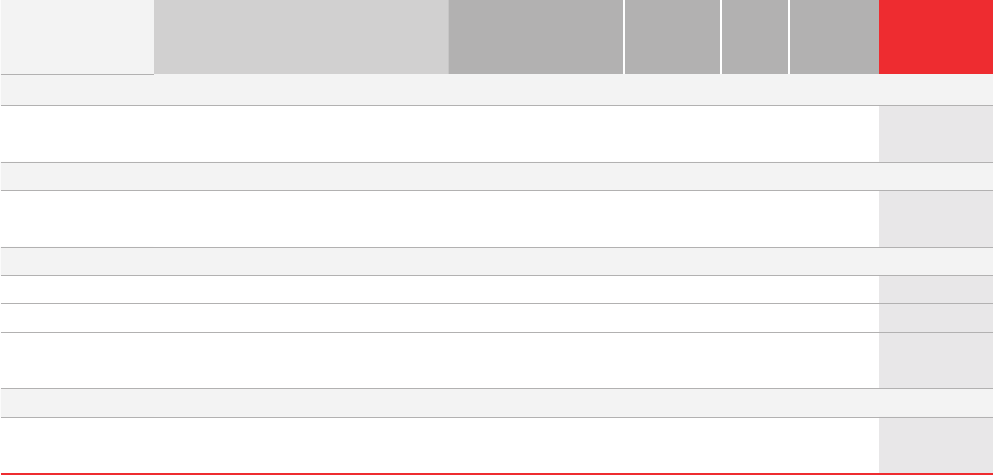
117
Annual Report of Yeti GermanCo 1 GmbH 2020
1
Affiliated companies not included in the consolidated financial statements owing to immateriality for the net assets, financial position and result of operations
Country
Name Domicile
Equity
(in €
thousands
Direct /
Indirect
Shareholding
in %
Net result after
taxes
(in € thousands)
Affiliated companies included in the consolidated financial statements
USA Messer Merchant Production LLC Delaware 10,529 I 100.00 (2,190)
Messer North America Inc. Delaware 112,257 I 100.00 (49,422)
Companies accounted for using the proportional consolidation
USA East Coast Nitrogen Company LLC Delaware 58,412 I 50.00 (5,006)
East Coast Oxygen Company LLC Delaware 5,075 I 50.00 (1,360)
Companies accounted for using the equity method
Belgium GreenCO2 Zwijndrecht 66 I 35.00 2
France Limes S.A.S. Saint-Herblain 4,904 I 50.00 2
USA Cliffside Helium LLC Delaware 61 I 26.00 19
Cliffside Refiners LP Delaware 1,857 I 25.74 853
Affiliated companies not included in the consolidated financial statement
France Lida S.A.S St.Quentin Fallavier - I 21.50 -
1
Soprogaz S.N.C. Beauvais - I 50.00 -
1

